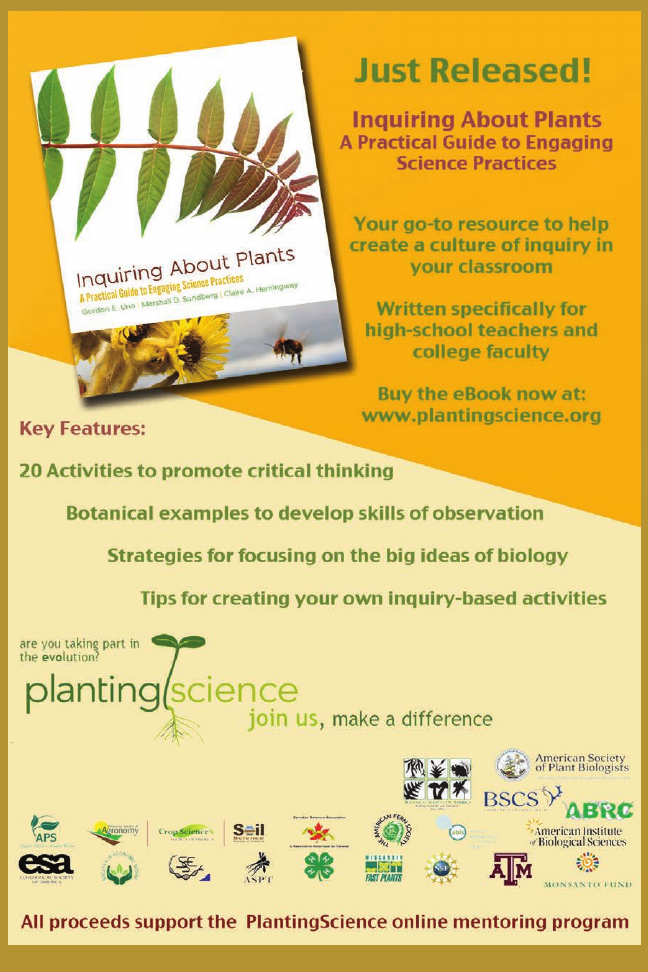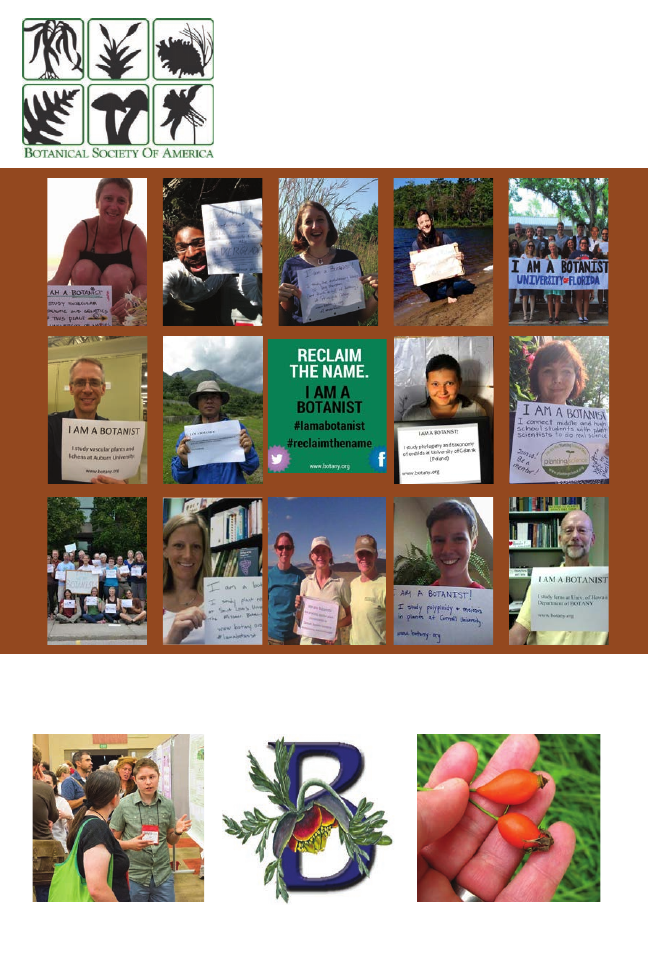
P
LANT
S
CIENCE
Bulletin
Fall 2014 Volume 60 Number 3
In This Issue..............
Rutgers University. combating
plant blindness.....p. 159
The season of awards......p. 119
Scientists proudly state their profession!
Botany 2014 in Boise: a fantastic
event......p.114

From the Editor
Fall 2014 Volume 60 Number 3
PLANT SCIENCE
BULLETIN
Editorial Committee
Volume 60
-
Marsh
Kathryn LeCroy
(2018)
Biological Sciences, Ecology and
Evolution
University of Pittsburgh
4249 Fifth Avenue
Pittsburgh, PA 15213
kalecroy@gmail.com
Christopher Martine
(2014)
Department of Biology
Bucknell University
Lewisburg, PA 17837
chris.martine@bucknell.edu
Lindsey K. Tuominen
(2016)
Warnell School of Forestry &
Natural Resources
The University of Georgia
Athens, GA 30605
lktuomin@uga.edu
Daniel K. Gladish
(2017)
Department of Botany &
The Conservatory
Miami University
Hamilton, OH 45011
gladisdk@muohio.edu
Carolyn M. Wetzel
(2015)
Biology Department
Division of Health and
Natural Sciences
Holyoke Community College
303 Homestead Ave
Holyoke, MA 01040
cwetzel@hcc.edu
Reclaim the name: #Iamabotanist is the latest
sensation on the internet! Well, perhaps this is a bit of
an overstatement, but for those of us in the discipline,
it is a real ego boost and a bit of ground truthing. We
do identify with our specialties and subdisciplines,
but the overarching truth that we have in common
is that we are botanists! It is especially timely that
in this issue we publish two articles directly relevant
to reclaiming the name. “Reclaim” suggests that
there was something very special in the past that
perhaps has lost its luster and value. A century ago
botany was a premier scientific discipline in the life
sciences. It was taught in all the high schools and
most colleges and universities. Leaders of the BSA
were national leaders in science and many of them
had their botanical roots in Cornell University, as
well documented by Ed Cobb in his article “Cornell
University Celebrates its Botanical Roots.” While
Cornell is exemplary, many institutions throughout
the country, and especially in the Midwest, were
leading botany to a position of distinction in the
development of U.S. science.
Beginning in the late 1930s and early 1940s a
serious disease began to appear in the U.S. that was
only diagnosed in 1998—PLANT BLINDNESS! In
hindsight, this serious disease was a major factor
in the steady erosion of botany and the status of
botanists. How can we overcome this epidemic
to help “reclaim the name”? Strong doses of local
treatment are indicated, and Lena Struwe and her
collaborators provide a good example of opening
students’ eyes in their article, “The Making of a
Student-Driven Online Campus Flora: An example
from Rutgers University.” Student engagement,
hands-on with plants, should provide the stimulus
for redeveloping plant sightedness—and a greater
appreciation for botany both within the scientific
community and with the public at large.
I’m sure that many of you have additional examples
d e m o n s t r a t i n g
effective treatment
of the insidious
disease, Plant
Blindness. I
encourage you to
share your results
by submitting a
manuscript to PSB.
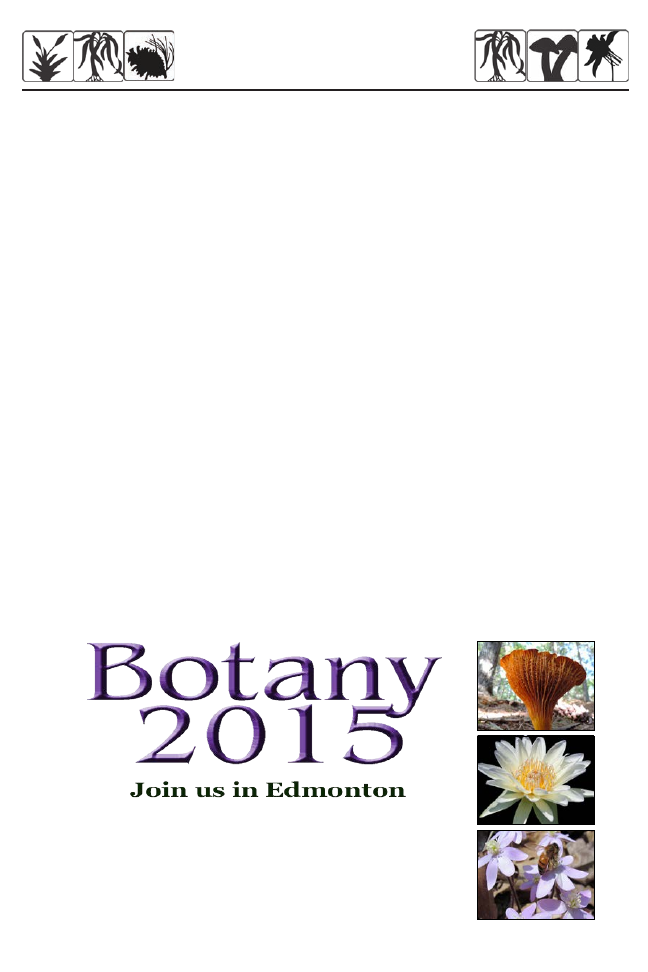
113
Table of Contents
Society News
Annual Meeting ..............................................................................................................114
Awards .........................................................................................................................120
“Crowdfund” your research ............................................................................................123
BSA Science Education News and Notes ....................................................
125
Editor’s Choice ............................................................................................
127
Announcements
Personalia
ASPT Honors Chris Martine ................................................................................128
AIBS Releases New Science Advocacy Toolkit .............................................................129
National Cleared Leaf Collection ...................................................................................129
Funding Opportunities
American Philosophical Society ..........................................................................130
Bullard Fellowship ...............................................................................................130
Missouri Botanical Garden hosts Meeting of Ecological Restoration Alliance .............131
In Memoriam
Matthew H. Hils, 1955 - 2014 ..............................................................................132
Otto Ludwig Stein, 1925 - 2014 ...........................................................................132
AJB Celebration Continues .............................................................................................134
Reports
Cornell University Celebrates its Botanical Roots. ........................................................141
The Making of a Student-Driven Online Campus Flora: an example from Rutgers
University .............................................................................................................159
Book Reviews
Economic Botany ...........................................................................................................170
Systematics ....................................................................................................................174
Books Received ...........................................................................................
182
Science and Plants for People
Shaw Convention Centre
July 25 - 29, 2015
Submit your symposia proposal now at
www.botanyconference.org
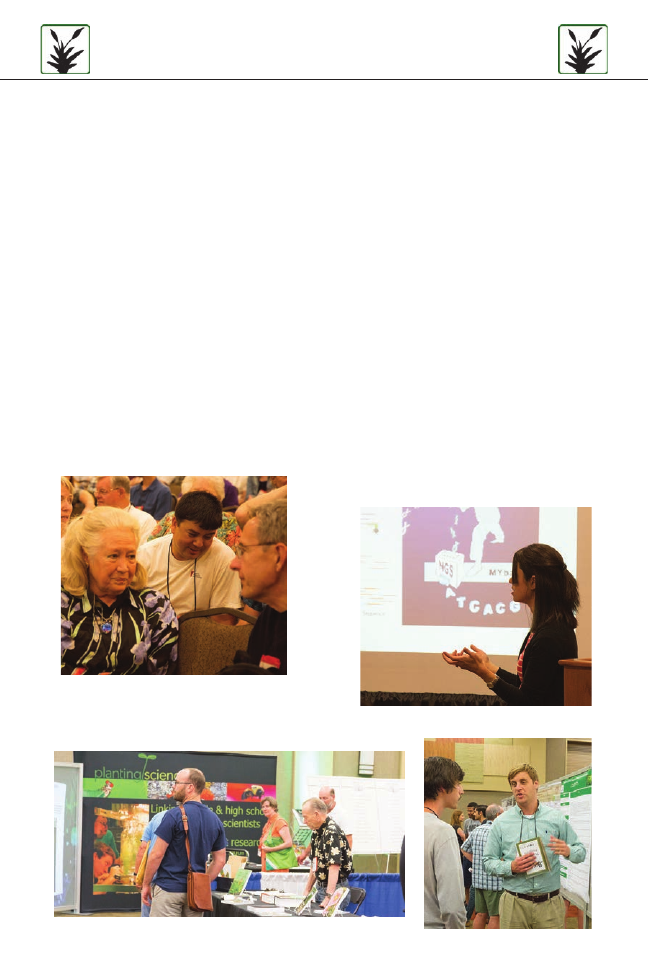
114
Society News
BOTANY 2014 Conference
A Success
BOTANY 2014 in Boise was an amazing success,
with 1056 botanists from 49 states and 39 countries
in attendance. (From the United States, only
Delaware was missing!) The conference welcomed a
large international contingent, from China, Bhutan,
New Zealand, Nigeria, Vietnam, and more.
Boise rolled out the red carpet for the conference,
with stores displaying “Welcome Botany” signs in
windows throughout the city, and attendees were
enthusiastic about the cities welcoming ambiance,
safe and walkable venues, delicious and affordable
restaurants. The Boise Center and host hotel, The
Grove, provided not only great meeting sites, but
the important places for impromptu and planned
locations for the attendees to meet with each other.
One attendee described the conference as “an
explosion of science,” and another as the “single
week that keeps me excited and challenged
throughout the year.”
As always, the Exhibit Hall was popular, with
32 exhibitors on hand to bring some of the newest
industry information to conference attendees. And
the Poster Session was a wealth of information
from some of the up-and-coming young scientists
ready to present during the week-long conference.
The week started out with the traditional Botany
in Action service project—approximately 30
botanists put their backs into the work of weeding,
pruning and generally buffing up for “Firewise!”---
the program designed to teach citizens how to
design, plant, and care for their property so it
survives a wildfire.
That field trip, along with others, was well-
attended and popular. While some attendees went
out to enjoy Idaho’s spectacular weather, others
stayed in for an array of workshops designed to
hone professional skills.
This year, awards were given in a new format
called “Celebrate!” featuring a reception and an
informal ceremony, which replaced the banquet
from previous years. The mixer furthered the
meeting’s reputation for opportunities to meet and
network.
....The week is an an explosion of science....
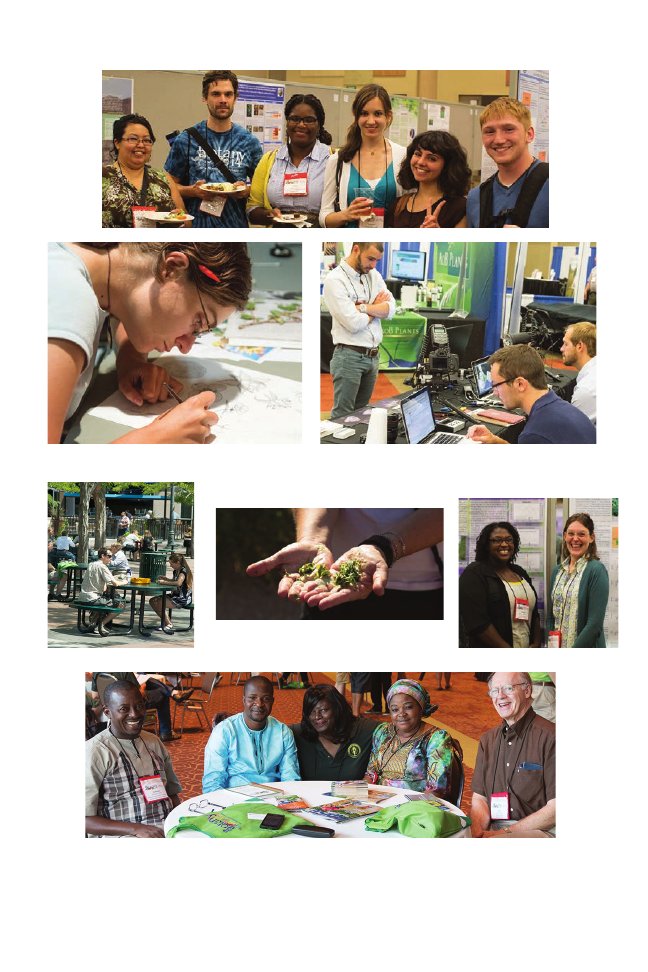
115
Plant Science Bulletin 60(3) 2014
The 2014 Conference sets the stage for Botany 2015, July 25-29 in Edmonton, Alberta, with the theme
“Science and Plants for People.” The conference site http://www.botanyconference.org/ is now open for
symposia proposals.
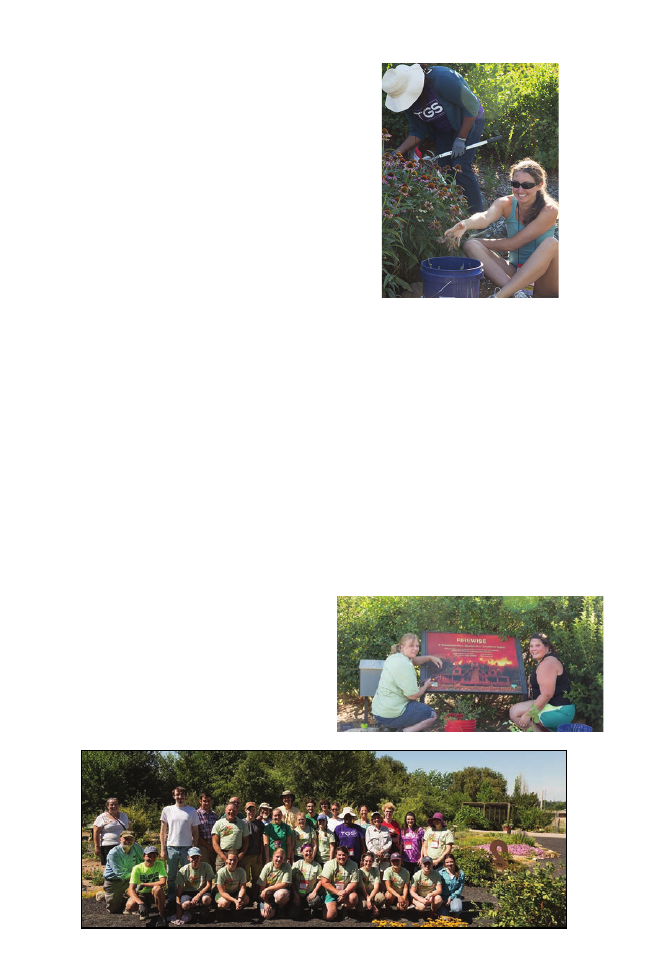
116
Plant Science Bulletin 60(3) 2014
Conference Attendees Give
Back to Boise with “Botany in
Action” Service Project
Most scientific conferences feature lectures and
posters, but attendees rarely get a chance to actually
give back to the host city---but then, Botany
Conferences have always stood out for offering
above-and-beyond experiences.
At Botany 2014 in Boise, more than 30 botanists
put their backs to work spiffing up the two-acre
Firewise Demonstration Garden during the Botany
in Action field trip. They descended on the flower
beds to weed, prune, and deadhead as well as
climb over the massive hill to remove the invading
weeds to once again render the hills fireproof.
The Garden—a cooperative project between the
Bureau of Land Management (BLM), the college
of Western Idaho Horticulture program, and the
Idaho Botanical Garden—is used to show the
public an example of how plantings can be used to
protect homes and property in the area.
The “before and after” was evident as the group
put their expertise to work, with the organizers of
the trip noting the difference between the “botany
volunteers” and some other groups, in terms of
their unwavering energy for the task.
It may have been more than energy, one volunteer
said. “We just know what we are looking at with the
plants. We know what to prune and where, how to
deadhead, what is a weed and what is a plant. That
makes the work fun for us. And we are learning
here too.”
The project, located adjacent to the Idaho
Botanical Garden, includes more than 350 native
and domestic species, all being evaluated for
performance and fire resistance in the Idaho
climate. The plants are watered in a drip system.
The Firewise project also focuses on teaching
residents about plant choice, maintenance, and
spacing, as well as how to plant in zones so that
structures do not burn. The concept of “defensible
space” is taught so that owners learn about planting
the right plants in the right place.
Roger Rosentreter, a botanist now retired from
the BLM and Boise State University who started
the Firewise project, coordinated the 2014 Botany
in Action for the Botany Conference. He explained
that today, perhaps with the onslaught of many
forest fires throughout the West, the idea of the
program is spreading. He says there is support from
the environmental community as well as the public.
“Landscaping and roofing materials will literally
determine if your house will burn,” Rosentreter
said. “What the public cares about is their houses.”
---Janice Dahl, Great Story!
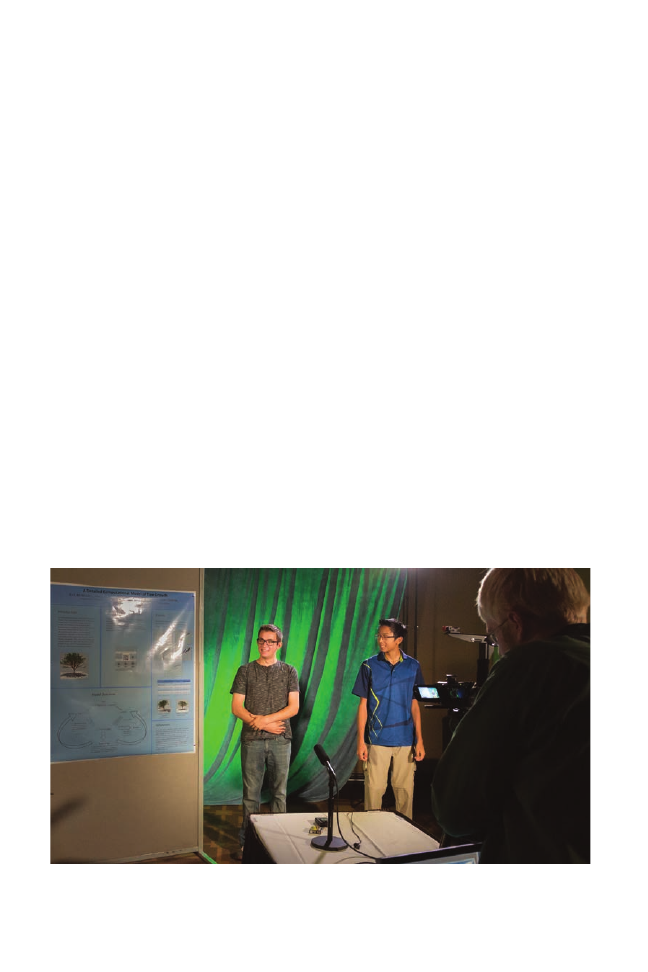
117
Plant Science Bulletin 60(3) 2014
A (Much) Younger Crowd at Botany 2014
Botany 2014 attendees may have noticed a few younger-than-usual botanists in the mix this year. Here
are two stories of how the conference can affect those whose interest in botany has started early in life.
Youngest-Ever Presenters Win Physiological Section Award
High school students Eli Echt-Wilson and Albert Zuo were excited to be accepted to present their poster
at Botany 2014---but they never dreamed they would win the award for the best poster presentation in
the Physiological Section.
They developed their project, “Detailed Computational Model of Tree Growth,” working with mentor
and post-doc Sean Hammond and spurred to achieve more by their high school science teacher, Jason
DeWitte. DeWitte connected the students with Hammond, who started the tree modeling work. The two
students did the work as juniors at La Cueva High School in Albuquerque, New Mexico.
“Mr. Hammond told us about the Botany conference,” said Eli. “It is very exciting to be here,” chimed
in Albert. “People have been friendly and open to come up to our poster to talk about it.”
“The project started out as fun thing, a local challenge, but it snowballed and became something really
good,” Albert explained. “We just went with the flow!”
The young scientists entered their work earlier in the year in the Intel Science Fair and were delighted
to see one of the judges at the Botany conference. They found their own excitement growing at the
opportunity to attend presentations by scientists from all over the world.
With such a stellar performance, where do these young men plan to head in their careers? Both are
interested in computer sciences and how those are applied to other fields. Botany is definitely still in the
mix.
“I always wanted to be a scientist,” Eli said. “If I can apply com sci to botany or biology, it would be of
interest to me.”
“I would definitely come back,” said Albert with a smile, his fellow scientist adding, “We’re already
thinking about our next project.”
Eli Echt-Wilson and Albert Zuo, in the middle of filming a video presentation of their award-winning
Physiological Section poster.
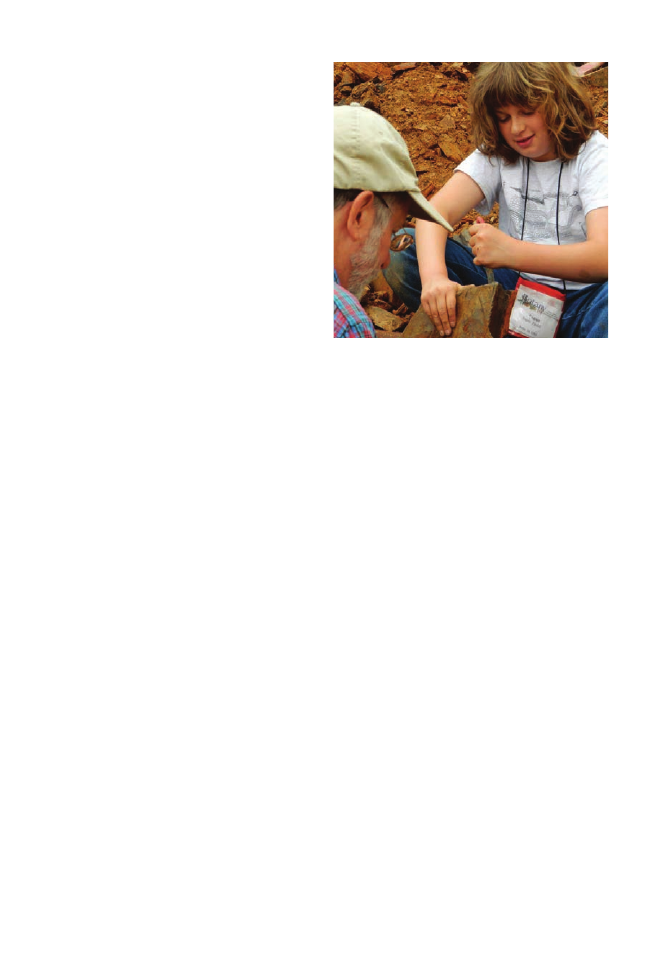
118
Plant Science Bulletin 60(3) 2014
techniques for lifting the leaves from the rock.
“I grew up with my father being a scientist in
Los Alamos, a town of scientists, and was able to
feel the excitement my father had for discovery
and science,” Sarah said of the Botany Conference
experience. “Eagan was able to pick up on that and
feel it himself. That was the best/most a mother
could have hoped for and was not disappointed.”
Sarah said Eagan began collecting unusual plants
at age 4 with bromeliads, figuring out on his own
what that was. This year, he made several flower
gardens for his mother on Mother’s Day and has
created window gardens in every available space.
Already, Eagan has shown an interest in the loss
of plant diversity on the planet, though his mother
says he is not a prodigy botanist.
Sarah said she has worked to get her son
interested in other things, to make him better-
rounded. But his fascination with plants remains.
And perhaps, at the center of this ongoing discover,
the Botanical Society of America will help lead the
way.
---Janice Dahl, Great Story!
The Making of a Botanist
Although Botany conference organizers are
proud to have a large representation of students,
it’s rare when one of those students hasn’t even
entered high school. When 11-year-old Eagan
Brandenberger signed up for a Botany Conference
field trip, he and his mother Sarah Brandenberger
didn’t know quite what to expect---so perhaps they
were surprised to see world-renowned botanists
open their arms to someone so young.
Eagan talked about the many botanists on
the “Fossil floras associated with the Middle
Miocene Columbia River Basalts of Northern
Idaho” field trip who were eager to share their
help, showing him the plants and fossils. He saw
the professional botanists keeping drawings and
journal entries, and he kept his own journal during
the field trips. His mother said he started out by
drawing flowers, emulating the botanists he saw
doing the same, and then making notes about what
he saw. It’s something a bit unusual for 11-year-
olds, but maybe not for those headed so intently for
a career they’ve fallen in love with at such a young
age.
“The experience was amazing,” Eagan said,
talking about 50-million-year-old fossils he
unearthed on the three-day trip led by Dr. Steve
Manchester. Big leafs, little leafs, all different leafs
clustered on a rock just “this big,” he gestured in
excitedly explaining his discovery of fractured bald
Cyprus. “I was really looking for an avocado…but
I didn’t find it,” he added with the exasperation
reserved for pre-teens.
During the trip, they learned about geography,
stopping at Whitebird to discover fossils right at the
side of the road. Side by side with botanists, Eagan
learned how to split the rock, looking at each find
with fascination as each fossil was identified. The
scientists taught Eagan how to split the fossils from
the rock so that the entire rock doesn’t have to be
carried to preserve the fossil.
“(Field trip coordinator) Bill (Rember) was
showing me the leaf and I realized it wasn’t yet rock
or simply impression—but an actual organic leaf,”
Sarah said. Later, some of the participants invited
Eagan to “botanize” the wet lands, so they went and
checked out the flora of the wetlands and “freed”
some fossils from the dig. The botanists worked
with Eagan, Sarah said, showing him different
Eagan Brandenberger, 11, learning about plant fossil
identification during a Botany 2014 field trip.
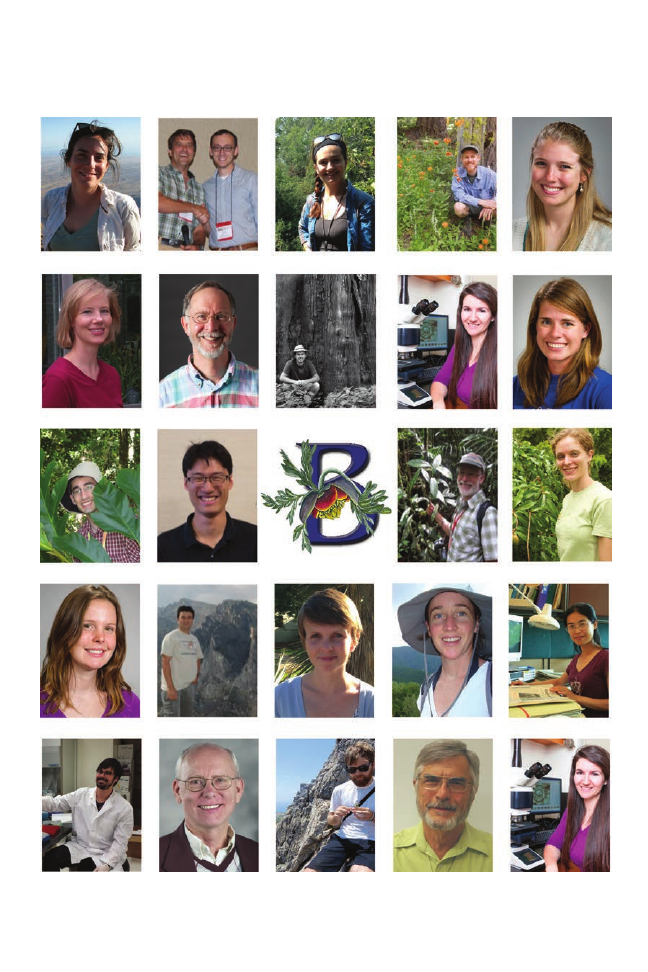
119
Plant Science Bulletin 60(3) 2014

120
Plant Science Bulletin 60(3) 2014
Isabel Cookson
Award (Paleobotanical Section)
Established in 1976, the Isabel Cookson Award
recognizes the best student paper presented in the
Paleobotanical Section.
Kelly K.S. Matsunaga from Humboldt State
University, for the paper, “A whole-plant concept for
an Early Devonian (Lochkovian-Pragian) lycophyte
from the Beartooth Butte Formation (Wyoming)”
Co-author: Alexandru M.F. Tomescu.
Katherine Esau Award
(Developmental and Structural
Section)
This award was established in 1985 with a
gift from Dr. Esau and is augmented by ongoing
contributions from Section members. It is given to
the graduate student who presents the outstanding
paper in developmental and structural botany at
the annual meeting.
This year’s award goes to Rebecca Povilus, from
Arnold Arboretum of Harvard University, for the
paper “Pre-fertilization reproductive development
and floral biology in the remarkable water
lily, Nymphaea thermarum.” Co-authors: Juan M.
Losada and William E. Friedman.
Physiological Section
Li-Cor Prize
Christina Hilt, Fort Hays State University-
Advisor, Dr. Brian Maricle, for the poster
“Physiological responses of grasses to drought and
flooding treatments” Co-author: Brian Maricle
Maynard Moseley Award
(Developmental & Structural and
Paleobotanical Sections)
The Maynard Moseley Award was established
in 1995 to honor a career of dedicated teaching,
scholarship, and service to the furtherance of the
botanical sciences. Dr. Moseley, known to his
students as “Dr. Mo”, died Jan. 16, 2003 in Santa
Barbara, CA, where he had been a professor
since 1949. He was widely recognized for his
enthusiasm for and dedication to teaching and
his students, as well as for his research using floral
and wood anatomy to understand the systematics
and evolution of angiosperm taxa, especially
waterlilies (PSB, Spring, 2003). The award is given
to the best student paper, presented in either the
Paleobotanical or Developmental and Structural
sessions, that advances our understanding of plant
structure in an evolutionary context.
Fabiany Herrera, from the University of Florida,
Florida Museum of Natural History, for the
paper “Revealing the Floristic and Biogeographic
Composition of Paleocene to Miocene Neotropical
Forests “ Co-authors: Steven Manchester and Carlos
Jaramillo
Developmental & Structural
Section
Best Student Presentation Awards
Kelsey Galimba, University of Washington,
for the poster “Gene duplication and neo-
functionalization in the APETALA3 lineage of floral
organ identity genes in a non-core eudicot” Co-
author: Jesus Martinez-Gomez and Veronica S Di
Stilio
Ecology Section Student
Presentation Awards
Rachel M. Germain (Graduate Student),
University of Toronto, for the paper “Hidden
responses to environmental variation: maternal
effects reveal species niche dimensions” Co-author:
Benjamin Gilbert
Clayton J. Visger (Graduate Student), University
of Florida, Florida Museum of Natural History,
for the paper “Niche Divergence in Tolmiea
(Saxifragaceae): using Ecological Niche Modeling
to develop a testable hypothesis for a diploid-
autotetraploid species pair” Co-authors: Charlotte
Germain-Aubrey, Pamela S. Soltis, and Douglas E.
Soltis
Takashi Yamamoto, Chiba University, for the
best Graduate Student poster “Refugia might affect
the genetic structure of a sea-dispersal plants: Vigna
marina” Co-authors: Koji Takayama, Reiko
Nagashima, Yoichi Tateishi, and Tadashi Kajita
Ignacio Vera, for the best Undergraduate
Student poster “Comparing Seed Viability and
Harvest Consistency Across Sites and Years for the
Federally Endangered Plant Eriastrum densifolium
spp. sanctorum”
Davis Blasini, Chicago Botanic Garden,
for the best Undergraduate Student poster
“Introduction of Echinacea pallida in the Prairies
of Western Minnesota and its Possible Effects on
Native Echinacea angustifolia” Co-author: Stuart
Wagenius
Botany 2014 AWARDS

121
Plant Science Bulletin 60(3) 2014
Genetics Section
Student Presentation Award
Morgan Roche, Bucknell University, for the
poster “When dioecy doesn’t pay: Population genetic
comparisons across three breeding systems and five
species in Australia Solanum” Co-authors: Ingrid
Jordon-Thaden and Chris Martine
Physiological Section Student
Presentation Awards
Eli Echt-Wilson and Albert Zuo, La Cueva
High School - Advisor, Jason DeWitte, for the paper
“A Detailed Computational Model of Tree Growth”
Co-authors: Sean Hammond, David Hanson and
Jason DeWitte
Keri Caudle, Fort Hays State University
- Advisor, Dr. Brian Maricle, for the poster
“Pigment variation among ecotypes of big bluestem
(Andropogon gerardii) across a precipitation
gradient” Co-authors: Christina Hilt, Cera Smart,
Diedre Kramer, Sana Cheema, Loretta Johnson,
Sara Baer and Brian Maricle
Southeastern Section -
Association of Southeastern
Biologists, Poster/Paper Awards
Titian Ghandforoush, Wake Forest
University - for the ASB 2014 presentation:
“Phylogenetic reconstruction of relationships I the
paleotropical Vaccinieae (Ericaceae) based on DNA
sequence data” Co-author Kathleen Kron
Kristin Emery, University of North
Carolina at Asheville - for the ASB 2014 poster:
“Effects of open pollination, selfing, inbreeding and
outbreeding treatments on seed set and viability
in Spiraea virginiana, an endangered rose” Co-
authors Jennifer Rhode Ward and H. David Clarke
Developmental & Structural
Section Student Travel Awards
Italo Antonio Cotta Coutinho, Universidade
Federal de Vicosa - Advisor, Renata Maria Strozi
Alves Meira - for the Botany 2014 presentation:
“Diversity of secretory structures in Urena
lobata L.: ontogenesis, anatomy and biology of the
secretion” Co-authors: Sara Akemi Ponce Otuki,
Valéria Ferreira Fernandes, Renata Maria Strozi
Alves Meira
Roux Florian, INRA - Advisor, Jana Dlouhá - for
the Botany 2014 presentation: “Flexible juveniles or
why trees produce ‘low quality’ wood?” Co-authors:
Jana Dlouhá, Tancrède Almeras, Meriem Fournier
Rebecca Povilus, Harvard University -
Advisor, William E. Friedman - for the Botany
2014 presentation: “Pre-fertilization reproductive
development and floral biology in the remarkable
water lily, Nymphaea thermarum” Co-authors: Juan
M. Losada, William E. Friedman
Beck Powers, University of Vermont - Advisor,
Jill Preston - for the Botany 2014 presentation:
“Evolution of asterid HANABA TARANU-like genes
and their role in petal fusion” Co-author: Jill Preston
Ecology Section Student Travel
Awards
Rachel Germain, University of Toronto -
Advisor, Dr. Benjamin Gilbert - for the Botany 2014
presentation: “Hidden responses to environmental
variation: maternal effects reveal species niche
dimensions” Co-author: Benjamin Gilbert
Jessica Peebles Spencer, Miami University -
Advisor, Dr. David L. Gorchov - for the Botany 2014
presentation: “Effects of the Invasive Shrub, Lonicera
maackii, and a Generalist Herbivore, White-
tailed Deer, on Forest Floor Plant Community
Composition” Co-author: David L. Gorchov
Economic Botany Section
Student Travel Awards
Lauren J. Frazee, Rutgers University - Advisor,
Lena Struwe - for the Botany 2014 presentation:
“Urban Environmental Education and Outreach
using Edible, Wild, and Weedy Plants” Co-authors:
Sara Morris-Marano and Lena Struwe
Jacob Wasburn, University of Missouri -
Advisor, J. Chris Pires - for the Botany 2014
presentation: “Photosynthetic evolution in the grass
tribe Paniceae” Co-authors: James Schnable, Gavin
Conant and J. Chris Pires
Genetics Section Student Travel
Awards
Heather Dame, University of Ottawa - for
the Botany 2014 presentation: “Phylogeny of the
paraphyletic Fuireneae (Cyperaceae)” Co-authors:
Anna K. Monfils, Derek R. Shiels, Julian Starr,
David Pozo, Adriane L. Shorkey and Elizabeth R.
Schick
Robert Massatti, University of Michigan -
for the Botany 2014 presentation: “Microhabitat
differences impact phylogeographic concordance of
co-distributed species: genomic evidence in montane
sedges (Carex L.) from the Rocky Mountains” Co-
author: Lacey Knowles

122
Plant Science Bulletin 60(3) 2014
Rosa Rodriguez, Florida International
University - for the Botany 2014 presentation:
“Genetic structure, diversity, and differentiation
of Pseudophoenix (Arecaceae) in Hispaniola” Co-
authors: Brett Jestrow, Teodoro Clase, Francisco
Jimenez, Alan Meerow, Eugenio Valentin Santiago,
Jose Sustache, Patrick Griffith and Javier Francisco-
Ortega
Pteridological Section &
American Fern Society Student
Travel Awards
Alyssa Cochran, University of North Carolina,
Wilmington - Advisor, Dr. Eric Schuettpelz - for
the Botany 2014 presentation: “Tryonia, a new
taenitidoid fern genus segregated from Jamesonia
and Eriosorus (Pteridaceae)” Co-authors: Jefferson
Prado and Eric Schuettpelz
Jordan Metzgar, University of Alaska, Fairbanks
- Advisor, Dr. Stefanie Ickert-Bond - for the Botany
2014 presentation: “From eastern Asia to North
America: historical biogeography of the parsley ferns
(Cryptogramma)” Co-author: Stefanie Ickert-Bond
Jerald Pinson, University of North Carolina,
Wilmington - Advisor, Dr. Eric Schuettpelz - for
the Botany 2014 presentation: “Origin of Vittaria
appalachiana, the “Appalachian gametophyte”” Co-
author: Eric Schuettpelz
Sally Stevens, Purdue University - Advisor, Dr.
Nancy C. Emery - for the Botany 2014 presentation:
“Home is Where the Heat Is? Temperature and
Humidity Responses in a Fern Gametophytex” Co-
author: Nancy C. Emery
SPECIAL AWARDS:
Dr. Elizabeth Kellogg
Out-going BSA Past-President,
Danforth Center
The Botanical Society of America presents a
special award to Dr. Kellogg expressing gratitude
and appreciation for outstanding contributions
and support for the Society. Toby has provided
exemplary contributions to the Society in terms of
leadership, time, and effort.
Dr. David Spooner
Out-going Program Director,
University of Wisconson
The Botanical Society of America presents a
special award to Dr. Spooner expressing gratitude
and appreciation for outstanding contributions
and support for the Society. David has provided
exemplary contributions to the Society in terms of
leadership, time, and effort.
Dr. Linda Graham
Out-going Director-at-large
for Development, University of
Wisconson
The Botanical Society of America presents a
special award to Dr. Graham expressing gratitude
and appreciation for outstanding contributions
and support for the Society. Linda has provided
exemplary contributions to the Society in terms of
leadership, time, and effort.
Morgan Gostel
BSA Student Representative to the
Board, George Mason University
The Botanical Society of America presents a
special award to Morgan expressing gratitude and
appreciation for outstanding contributions and
support for the Society.

123
Plant Science Bulletin 60(3) 2014
well for increasing the number of potential donors
for one campaign, Experiment.com is structured
for a single principal investigator to launch a
campaign. This is something they are actively
working to change as numerous researchers have
requested for group campaign options.
If you already have a polished grant proposal,
this is a good place to a start. You will have to
modify it, though, dividing it into smaller sections
and removing ALL undefined technical language.
This will enable the public, particularly your friends
and family, to comprehend the importance of your
campaign and be motivated to contribute to your
science. A highlight of this alternative ‘open source’
research is that the backers (e.g. donors) receive
updates from you as your campaign progresses and
as your successfully funded project generates new
data. These updates are posted by the researcher,
and the website automatically sends an email to
donors saying that something has been posted that
they might be interested in. As with any company,
though, the backers agree to be part of this
community after they contribute until they remove
their email from the Experiment.com database.
Donors will continue to get notifications from
Experiment.com when other projects they might be
interested have been launched or are close to being
funded. In addition, researchers using Experiment.
com must agree to publish their research in an open
access journal.
The staff at Experiment.com will review your
campaign page multiple times until you and they
”Crowdfund” your research
What do you do when you have a great research
idea but can’t afford to pay for it?
One option is to “crowdfund” your idea using
Experiment.com, a small private company based
in the venture capital of the world, San Francisco.
From an office in the living room of a shared
apartment in the Mission District, the staff at
Experiment.com invited me to sit on a beanbag
chair on their deck and talk about my research. We
used Skype to bring Tommy Stoughton, my field
partner, into the discussion from the other side of
the state nearer Los Angeles. We focused on the
differences between a crowdfunding campaign and
a grant proposal, and the psychology of potential
donors. Following this conversation, we hashed
out a schedule and planned for the launch of our
crowdfunding campaign involving alpine plant
research.
It isn’t necessary that you make a personal visit to
establish a connection with the staff at Experiment.
com, but since I was in town, I wanted to meet
these folks in their element. The bare-essentials
living room had a large table with chairs around
and was crowded with computer equipment -- they
all slept in the apartment. Their job, and why we
hire them, is to help promote and manage your
social web-based presence to the World Wide Web
via Social Media in this new age of technology and
connectedness. They also manage the collection
of individual donations that are made to your
campaign, spending plenty of time encouraging
principle investigators (like us) to get out there and
find more backers.
Experiment.com is creating a different kind of
community of public involvement in the Scientific
Community. What most people ask is, “It is like
Kickstarter.com, but for science, right?” That is
exactly right. In the fall of 2013, Tommy Stoughton
launched his own all-or-nothing $20,000 campaign
on Experiment.com, but he ultimately received
nothing when his fundraising efforts fell short by
about $13,000. After great consideration regarding
how or why Tommy had failed, we received
encouragement to try again with a more realistic
goal. Tommy’s first attempt was designed to fund
an entire Ph.D. dissertation, not a small paper or
individual chapter. We decided to combine forces
and launch the campaign together as a team,
taking advantage of mostly non-overlapping social
network outlets. While this strategy might work
Ingrid Jordon-Thaden and Thomas Stoughton in
the Ruby Mountains, Humboldt National Forest,
Nevada.

124
Plant Science Bulletin 60(3) 2014
are confident that the public will understand your
goals and descriptions. It helps to make a video
of your research, your field trips, or even a small
dialogue of you talking about your goals. You
can repost this video on YouTube, for example,
providing information to link the video to your
campaign page. I posted our video before the
launch in order to prepare our network of friends
for the 30-day campaign.
When it really comes down to it, there were three
major sources of backers for our project: (1) our
contacts and posts on Facebook, (2) the Twitter
network, and (3) old-fashioned email, phone, and
personal communications. Immediately upon
launching the project, we sent individual emails
to friends, family and colleagues, asking them to
support our research. A high percentage of our
backers were people we already knew. In order
to entice an unknown science enthusiast, it’s best
to prepare interviews with journalists or bloggers
in advance, to promote your campaign before
it even begins. I was a bit late in that aspect, but
did arrange to have an article in my hometown
newspaper (The Omaha World-Herald) a few
days before our campaign ended. This did find a
few people who knew me as a child and reached
out to help. I can say that I spent approximately
10 hours a week in a 30-day period using my
communication outlets to encourage people to
donate. Tommy spent an equivalent amount of time
blogging and communicating with friends, family,
and others. Even though Experiment.com helps
with this aspect, they do not have access to your
personal contacts, and responsibility of promoting
your project lies almost entirely on you. Reflecting
again on Tommy’s first attempt to raise funds on
Experiment.com, having a slew of project backers
before the launch may be the quintessential key to
a successful crowdfunding effort. Project backers
attract more project backers as momentum builds
toward a 100% funded campaign.
We raised $7,170 in pledges. After a couple
of backers’ declined credit card attempts, and
Experiment.com’s 8% commission, we came
away with $6,593.80. This will cover our two field
trips this summer to the mountains of western
Montana, central Idaho, and the Yukon, Canada.
Any remaining funds will be used in the lab on our
newly acquired samples. We are already planning
a second campaign to fund the lab work we have
proposed for newly collected samples. We will likely
set a higher goal of $10,000 for this campaign, but
that number is not seen by the public right away. If
you are 100% funded before your campaign time
ends (set by the researcher to 30, 60, or 90 days),
this higher goal will be shown on your page as an
‘extension’ goal. Once a project has reached greater
than 100%, more members of the general public are
likely to chip in. We were funded 103%, but there
have been numerous successful projects that were
funded over 150%.
Overall, it has been a very positive experience
working with the team at Experiment.com.
Crowdfunding won’t replace grant-writing—
you can’t depend on the public and your family/
friends to continue funding your research—but
it can work once or twice as an excellent method
for generating preliminary data for larger grant
proposals. Crowd-source funding takes advantage
of the natural tendency of people to get excited
about scientific research. When a project is 85%
funded, for example, and you let people know
that you are progressing towards your goal, the
momentum can REALLY build. People talk about
your project, other backers chip in, the goal is met.
It is like an old-fashioned fundraiser at your school
or church, but with more technology and fewer
chocolate chip cookies... unless you want to try
your luck at Kickstarter.com and promise a rewards
like oatmeal raisin or external hard drives with all
the raw data.
---by Ingrid Jordan-Thaden, Bucknell University

125
BSA Science Education
News and Notes
BSA Science Education News and Notes is a quarterly update about the BSA’s education efforts and the
broader education scene. We invite you to submit news items or ideas for future features. Contact: Catrina
Adams, Acting Director of Education, at CAdams@botany.org or Marshall Sundberg, PSB Editor, at psb@
botany.org.
New and Ongoing Society
Efforts
PlantingScience Launches 17th
Session, Welcomes New Teachers
and Mentors
PlantingScience, the online mentoring program
started by the BSA in 2005, continues to reach
hundreds of students each session. Through
PlantingScience, plant scientists take advantage
of the opportunity to conduct K-12 outreach
from their own offices. They inspire middle- and
high-school student teams to do real science
investigations, to see themselves as scientists, and
to open students’ eyes to plants in their world.
We’d like to welcome the 30 new mentors
who have registered with PlantingScience since
last spring, and the 11 teachers who will use
PlantingScience in their classrooms for the first
time this fall. We also welcome back our dedicated
mentoring team, many of whom have been
mentoring for over 5 years.
We expect about 250 teams at 27 schools to
participate this fall, from 12 states in the USA as well
as from The Netherlands, Nigeria, and Indonesia.
By the end of the fall’s session we will have reached
well over 14,000 students with the program.
If you aren’t familiar with PlantingScience,
please stop by the website this session to see how
the teams are doing. We feature teams each week on
the homepage, www.plantingscience.org. If you are
interested in becoming a scientist mentor, please
apply! The time commitment is small, and you can
really make a difference in the students’ lives. We
are recruiting now for the upcoming spring session,
which will run from mid-February through mid-
April.
BSA is pleased to sponsor the following BSA
graduate students and post-docs as part of our
Master Plant Science Team this year: Jesse W.
Adams, Katie Becklin, Alan Bowsher, Riva
Bruenn, Steven Callen, Elizabeth Georgian, Tara
Caton, Julia Chapman, Taylor Crow, Cameron
Douglass, Rachel Hackett, Julie Herman, Cody
Hinchliff, Ingrid Jordon-Thaden, Irene Liao,
Daniel Blaine Marchant, Angela McDonnell,
Nora Mitchel, Mischa Olson, Rhiannon Peery,
Megan Philpott, Jerald Pinson, Adam Ramsey,
Amanda Tracey, Maria Vasquez, Evelyn Williams,
and Bethany Zumwalde.
Fundraising efforts continue as we strive to
expand and provide long-term support for this
successful program. A crowdfunding campaign
through the website www.Indiegogo.com is planned
for mid-September. Sales of the ebook Inquiring
About Plants: A Practical Guide to Engaging
Science Practices are going well. If you have not
gotten your copy of the e-book yet, you can learn
more and purchase a copy at www.plantingscience.
org. All proceeds support the PlantingScience
program.
Join us at the Life Discovery –
Doing Science Conference in San
Jose, California, October 3-4
The theme for this year’s Life Discovery
Conference (LDC) is “Realizing Vision & Change,
Preparing for Next Generation Biology.”
Designed as a “working conference,” the LDC is
organized to maximize interaction and exchange
among participants. The conference features 2
keynote speakers, 30 short presentations of best
practices in Biology education, 9 workshops and
more than 30 Education Share Fair Roundtable
discussions over the 2 days of the conference.
Additionally, there will be time for discussion
and networking by special interest groups. All
are welcome to bring your ideas and solutions to
advance Biology education in the 21st century.
Learn more and register here: http://www.esa.
org/ldc/2014-ldc-conference/information/
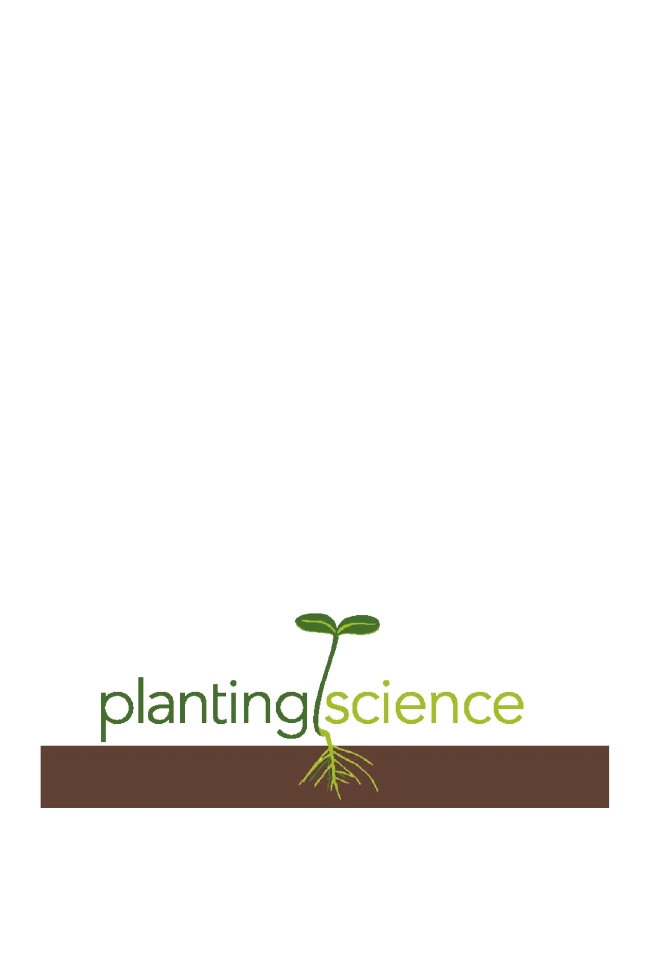
126
Plant Science Bulletin 60(3) 2014
Apply now for Upcoming Gordon Research Conference on
Undergraduate Biology Education Research (UBER) - July 12-17, 2015, Bates
College, Maine
Join a stellar group of colleagues from across the nation to advance our understanding of what it takes to
change undergraduate biology programs systemically and to catalyze novel directions for future research
at this new Gordon Research Conference.
The specific goals of the conference are to:
• Bring together a diverse community of biologists, biology education scholars, disciplinary society
leaders, and others to discuss current issues, drivers, trends and future directions in undergraduate
biology education research.
• Exchange information and ideas about best practices and their implementation.
• Foster development of new research ideas and collaborations among attendees.
• Develop a longer-term vision for regular UBER GRC meetings.
Applications for this meeting are currently available at: http://www.grc.org/programs.aspx?id=16908
www.plantingscience.org

127
Two of the articles explore “plant blindness,”
the concept developed by the late BSA member
Jim Wandersee to describe the public’s failure to
notice or appreciate plants. In “Attention ‘Blinks’
Differently for Plants and Animals,” Benjamin
Balas and Jennifer L. Momsen demonstrate that
there is, in fact, a fundamental difference in how
the visual systems of college students process plant
images versus animal images. They suggest several
useful strategies for overcoming zoocentrism.
Janice L. Anderson, Jane P. Ellis, and Alan
M. Jones use drawings of plant structures to
examine plant blindness in school students. In
“Understanding Early Elementary Children’s
Conceptual Knowledge of Plant Structure
and Function through Drawings,” the authors
demonstrate that young children have a basic
knowledge of plant structure and some functions,
but also identify some common misconceptions.
They conclude that drawings are a very useful tool
for assessing student understanding at this level.
In “An Evaluation of Two Hands-On Lab Styles
for Plant Biodiversity in Undergraduate Biology,”
John M. Basey, Anastasia P. Maines, Clinton D.
Francis, and Brett Melbourne describe two very
basic modifications to incorporate more student-
active learning into a traditional biodiversity course.
Finally, Jennifer Rhode Ward, H. David Clarke, and
Jonathan L. Horton, in “Effects of a Research-Infused
Botanical Curriculum on Undergraduates’ Content
Knowledge, SEM Competencies, and Attitudes
toward Plant Sciences,” describe the benefits of
incorporating plant-based field and laboratory
research throughout the undergraduate curriculum
at their institution, a public liberal arts college,
beginning with the introductory sophomore level
course and extending throughout the curriculum.
They provide some useful suggestions for keeping
the time demand manageable for faculty members.
The Plant Sciences Education issue of CBE-Life
Sciences Education [13(3)] is live at http://www.
lifescied.org/content/current! CBE-Life Sciences
Education is online and open access, and this issue
features an essay on Plant Behavior, by Dennis W.C.
Liu of the Howard Hughes Medical Institute; a book
review of the children’s book, My Life as A Plant,
published by ASPB; and seven research articles all
linked by a pithy editorial by Diane Ebert-May and
BSA member Emily Holt titled “Seeing the Forest
and the Trees: Research on Plant Science Teaching
and Learning.”
Three of the articles report on original inquiry-
based instructional materials. “Connections
between Student Explanations and Arguments
from Evidence about Plant Growth,” by Jenny
Dauer, Jennifer Doherty, Allison Freed, and Charles
Anderson, focuses on understanding matter and
energy transformations during growth. Although
the study examines middle and high school
students, the results and suggestions are clearly
applicable to college freshman courses.
In “Beyond Punnett Squares: Student Word
Association and Explanations of Phenotypic
Variation through an Integrative Quantitative
Genetics Unit Investigating Anthocyanin
Inheritance and Expression in Brassica rapa Fast
Plants,” Janet Batzli, Amber Smith, Paul Williams,
Seth McGee, Katalin Dosa, and Jesse Pfammater
describe a 4-week inquiry focusing first on
quantitative inheritance and then effectively
integrating Mendelian genetics.
“Optimizing Learning of Scientific Category
Knowledge in the Classroom: The Case of Plant
Identification” by Bruce Kirchoff, Peter Delaney,
Meg Horton, and Rebecca Dellinger-Johnston,
describes the application of computer software
in an active-learning format to improve sight
recognition of plants. The experimental design
provides proof of concept of the tools Bruce has
developed and demonstrated at BSA workshops for
the past several years.
Editor’s Choice

128
ANNOUNCEMENTS
Personalia
The American Society of Plant
Taxonomists honored BSA Member
Chris Martine for his emphatic
teaching and social media
outreach
Teaching is like planting seeds. Lessons take root,
understanding grows and knowledge branches
out to new ground. Professor of Biology Chris
Martine has been planting seeds at Bucknell for two
years, and was recently honored for his efforts in
disseminating knowledge of the plant sciences far
and wide. The budding scientists he has nurtured
here too have garnered recognition for their own
research.
In May, Martine was honored by the American
Society of Plant Taxonomists with its Innovations
in Plant Systematics Education prize. The society
lauded Martine not only for his “contagiously
positive and fact-based way of enhancing botanical
learning especially among college undergraduates,”
but also for his efforts to reach a broader audience
through new and social media. Martine has more
than 1,600 Twitter followers (@MartineBotany);
blogs about plants, science and teaching for the
Huffington Post; and writes, produces and stars in
an educational YouTube series, “Plants are Cool,
Too!”
“People are using social media; people are
watching things on YouTube; people are reading
the Huffington Post,” Martine said. “I try to place
content where people are already spending time
watching things and reading things.”
Martine, the David Burpee Chair in Plant
Genetics and Research, said there’s a serious motive
underlying the entertaining, sometimes playful
content he posts.
“I’m really concerned about people recognizing
not only that biodiversity is declining on Earth, but
also that there is a lot of unknown biodiversity on
Earth that we still have a chance to discover,” he
said. “As a botanist, I try to use plants to help people
develop a greater appreciation for biodiversity,
nature and this sense of discovery that we still can
embrace. One of the things that makes plants an
ideal model for that sort of outreach is that they’re
everywhere—they’re really easy to find and they
don’t move.”
He also incorporates his online persona in the
classroom, whether by assigning his videos or
blog posts as homework, or casually suggesting his
students check out what he’s done next time they’re
hanging out in one of those virtual spaces.
The seeds of curiosity Martine has planted in the
minds of his students have clearly taken root. For
the second year in a row, three of Martine’s students
(Alice Butler, Ian Gilman and Morgan Roche)
were selected to receive Undergraduate Research
Awards by the Botanical Society of America (BSA),
the foremost group promoting plant sciences in
the United States. Last year the society parsed
out only six such grants to undergraduates, with
Bucknellians receiving half; this year it awarded
seven, with Bucknell students again earning three
grants. Three members of the Class of 2014—
Gemma Dugan, Anna Freundlich and Vince
Fasanello — were also honored with Young Botanist
of the Year awards, which recognize the cumulative

129
Plant Science Bulletin 60(3) 2014
accomplishments made by undergraduates during
their collegiate years.
“I get emails from [Chris] all the time saying, ‘I
heard about this; you should apply,’ and it’s always
something specific to my interests,” Dugan said. “He
pays a lot of attention to helping us as individuals
get what we want from our careers; he doesn’t just
forward everyone the same email. To have someone
who pushes you to apply for grants and scholarships
has been super helpful, and I think that’s why this
lab has been so successful.”
Martine is quick to note, however, that the
students wrote their own grant and scholarship
applications, and deserve final credit for their
accomplishments. He marked two additional
accolades garnered this year by his students
as particularly impressive. Gilman received an
Undergraduate and Graduate Student Training
Fellowship from the Torrey Botanical Society,
which he will use to attend a field course in the
Rocky Mountains through the University of Idaho.
“It’s an award that both graduate students and
undergraduates are eligible for,” Martine said. “It’s
hard to know what the pool was, but he likely
went up against graduate students as well as
undergraduates, and was chosen.”
Martine hopes his students and those he inspires
online will continue to nurture an interest in botany
as they move on. As they do, Martine will keep on
planting seeds, wherever he can.
“Everybody can find a plant,” he said. “Everybody
can learn something about one plant. That’s such an
easy jumping off point to help people develop an
understanding about nature, biodiversity and non-
human organisms.”
--Matt Hughes
AIBS Releases New Science
Advocacy Toolkit
The American Institute of Biological Sciences
(AIBS) has launched a new website to help
researchers participate in the development of the
nation’s science policy. This free online resource is
available at policy.aibs.org.
“AIBS has been a leader in its efforts to engage
scientists in public policy,” said AIBS President Dr.
Joseph Travis. “This new website continues this
important work by making it easier than ever for
researchers to be involved in the decision-making
process.”
The Legislative Action Center is a one-stop shop
for learning about and influencing science policy.
Through the website, users can contact elected
officials and sign up to interact with lawmakers.
The website offers tools and resources to inform
researchers about recent policy developments.
The site also announces opportunities to serve on
federal advisory boards and to comment on federal
regulations.
The Legislative Action Center is supported by
AIBS, the Society for the Study of Evolution, the
Botanical Society of American, and the Association
for the Sciences of Limnology and Oceanography.
The National Cleared Leaf
Collection-Hickey Published
Electronically
The Division of Paleobotany at the Peabody
Museum of Natural History is delighted to announce
the electronic publication of the National Cleared
Leaf Collection-Hickey (NCLC-H). The NCLC-H
consists of over 7,000 cleared, stained and mounted
extant leaves. It stands as the major community
resource in the area of foliar morphology for plant
systematists and paleobotanists around the world.
While at the Smithsonian Institution, Leo J. Hickey
began NCLC-H in 1969 as part of his research on
the systematic distribution of the leaf characters of
the flowering plants in relation to the evolution of
a group. The NCLC-H was moved to Yale Peabody
Museum on a long-term loan agreement when Leo
Hickey came to the Peabody Museum of Natural
History as Director in 1982. Sadly, Dr. Leo Hickey
passed away in February 2013. The NCLC-H was
returned to Smithsonian National Museum of
Natural History in May, 2014.
The NCLC-H is currently arranged alphabetically

130
Plant Science Bulletin 60(3) 2014
by family, then by genus and species. There are
approximately 321 families and 1,300 genera,
including herbaceous, parasitic, Arctic, alpine and
derived groups such as the Asteridae, in an effort
to elucidate the full range of dicotyledonous leaf
morphological patterns. Also, there are a significant
number of extinct and endangered species, such as
Canacomyrica monticola from New Caledonia.
The collection presently covers floras from South
America, North Central America, Oceania and Asia.
Most of the leaves have been taken from herbarium
collections, with some prepared using fresh or fluid-
preserved specimens. Each specimen is vouchered
to an authoritatively identified herbarium sheet.
The size, scope, documentation, and the quality of
the mounts make the NCLC-H the most important
database of leaf architecture in the world. At the
present time, the NCLC-H provides the main source
of documentation for the systematic description of
leaf architectural variationamong the dicotyledons
and has been the basis for the current system of
leaf architectural classification, fossil and modern
plant identifications, ecological and paleoecological
studies, as well as ongoing studies into the ontogeny
of leaf venation.
The electronic publishing of NCLC-H makes
researchers and the public easy access to the
database. The NCLC-H is available free at
http://
peabody.research.yale.edu/nclc/
.
---
By Shusheng Hu, Division of Paleobotany, Pea-
body Museum of Natural History, Yale University
Funding Opportunities
HARVARD UNIVERSITY BULLARD
FELLOWSHIPS IN FOREST RESEARCH
Each year Harvard University awards a limited
number of Bullard Fellowships to individuals in
biological, social, physical and political sciences to
promote advanced study, research or integration
of subjects pertaining to forested ecosystems. The
fellowships, which include stipends up to $40,000,
are intended to provide individuals in mid-career
with an opportunity to utilize the resources and to
interact with personnel in any department within
Harvard University in order to develop their own
scientific and professional growth. In recent years
Bullard Fellows have been associated with the
Harvard Forest, Department of Organismic and
Evolutionary Biology and the J. F. Kennedy School
of Government and have worked in areas of ecology,
forest management, policy and conservation.
Fellowships are available for periods ranging
from six months to one year after September 1.
Applications from international scientists, women
and minorities are encouraged. Fellowships are
not intended for graduate students or recent post-
doctoral candidates. Information and application
instructions are available on the Harvard Forest
website (http://harvardforest.fas.harvard.edu).
Annual deadline for applications is February 1.
American Philosophical Society
Announces Research Programs
Information and application instructions for all
of the Society’s programs can be accessed at http://
www.amphilsoc.org. Click on the “Grants” tab at
the top of the homepage.
Brief Information About
Individual Programs
Franklin Research Grants
Scope: This program of small grants to scholars is
intended to support the cost of research leading to
publication in all areas of knowledge. The Franklin
program is particularly designed to help meet the
cost of travel to libraries and archives for research
purposes; the purchase of microfilm, photocopies or
equivalent research materials; the costs associated
with fieldwork; or laboratory research expenses.
Eligibility: Applicants are expected to have a
doctorate or to have published work of doctoral
character and quality. Ph.D. candidates are not
eligible to apply, but the Society is especially
interested in supporting the work of young scholars
who have recently received the doctorate.
Award: From $1000 to $6000.
Deadlines: October 1, December 1; notification
in January and March.
Lewis and Clark Fund for
Exploration and Field Research
Scope: The Lewis and Clark Fund encourages
exploratory field studies for the collection of
specimens and data and to provide the imaginative
stimulus that accompanies direct observation.
Applications are invited from disciplines with a large
dependence on field studies, such as archeology,
anthropology, biology, ecology, geography, geology,
linguistics, and paleontology, but grants will not be
restricted to these fields.
Eligibility: Grants will be available to doctoral
students who wish to participate in field studies for

131
Plant Science Bulletin 60(3) 2014
their dissertations or for other purposes. Master’s
candidates, undergraduates, and postdoctoral
fellows are not eligible.
Award: Grants will depend on travel costs but
will ordinarily be in the range of several hundred
dollars to about $5000.
Deadline: February 1; notification in May.
Information about All Programs
Awards are made for noncommercial research
only. The Society makes no grants for academic
study or classroom presentation, for travel to
conferences, for non-scholarly projects, for
assistance with translation, or for the preparation
of materials for use by students. The Society does
not pay overhead or indirect costs to any institution
or costs of publication.
Eligibility: Applicants may be citizens or
residents of the United States or American citizens
resident abroad. Foreign nationals whose research
can only be carried out in the United States are
eligible, although applicants to the Lewis and
Clark Fund for Exploration and Field Research in
Astrobiology must be U.S. citizens, U.S. residents,
or foreign nationals formally affiliated with a
U.S. institution. Grants are made to individuals;
institutions are not eligible to apply. Requirements
for each program vary.
Questions concerning the Franklin and Lewis
and Clark programs should be directed to Linda
Musumeci, Director of Grants and Fellowships, at
LMusumeci@amphilsoc.org or 215-440-3429.
Missouri Botanical Garden
Hosts Meeting of Ecological
Restoration Alliance
(ST. LOUIS): Conservation experts from the
world’s leading botanical gardens met in St. Louis in
July and called for a renewed effort to link ecological
restoration with the elimination of poverty in
natural resource-dependent communities. In
Madagascar, for example, the Missouri Botanical
Garden provides training and jobs to local people
who in turn assist with ecological restoration. All too
often, there are no viable economic alternatives to
the degradation of biodiverse ecosystems. Member
gardens are committed to offering alternatives that
restore damaged land while providing income for
those living in these areas.
Botanical Gardens are uniquely qualified to
conduct ecological restoration given their expertise
in horticulture and their capacity to document the
source and genetics of plants. A garden’s reference
plant collection provides documentation of a
species even in areas with no remaining vegetation
so that ecosystems can be restored in a historically
accurate manner. Accurate species composition
is necessary to revitalize normal function and
regenerate ecosystem services such as watershed
protection and nutrient cycling.
The Ecological Restoration Alliance consists
of 18 member gardens from 10 countries. It was
formed in response to the United Nation’s Global
Strategy for Plant Conservation goal of restoring
15 percent of the world’s damaged ecosystems
by 2020. The Alliance is currently working to
restore more than 100 degraded, damaged or
destroyed ecosystems by 2020 including tropical
rainforests, temperate woodlands, grasslands,
beaches, wetlands and more through partnerships
with academic groups, industry and government.
Among those 100 projects are two managed by the
Missouri Botanical Garden: Restoring diversity in
the St. Louis Region and Preserving and Restoring
a Rich and Diverse Flora in Madagascar.
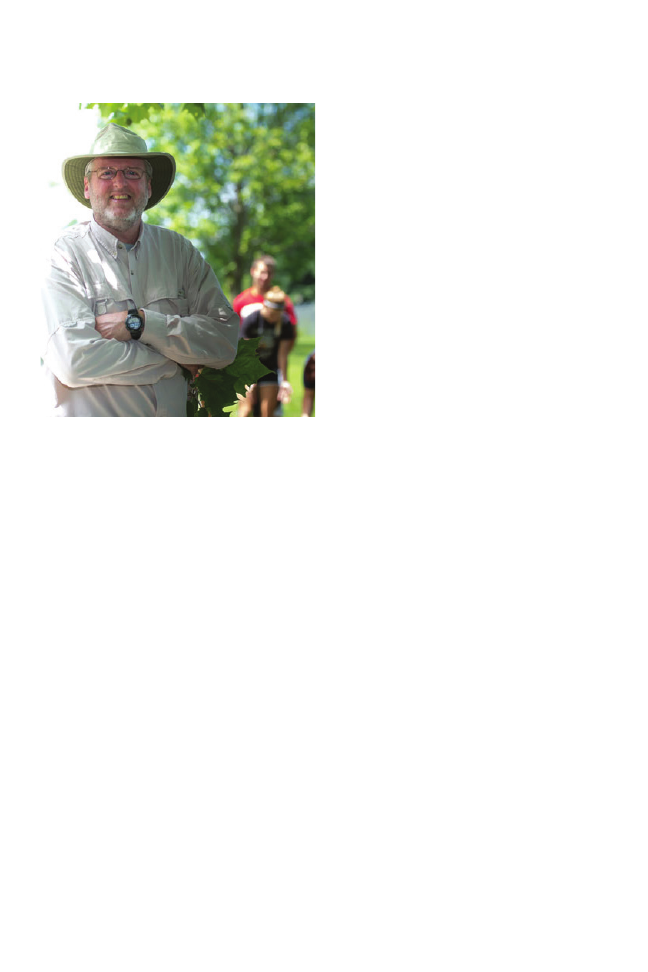
132
Plant Science Bulletin 60(3) 2014
In Memoriam
Matthew H. Hils
1955-2014
Matt Hils, Professor of Biology, Director of J.H.
Barrow Field Station, and Director of the Center for
the Study of Nature and Society at Hiram College,
passed away June 10, 2014 at his residence. Matt
received his B.A. in Biology from Thomas More
College, his M.S. from Miami University (OH), and
Ph.D. at University of Florida in Gainesville before
arriving at Hiram College in 1984.
Although Matt has made contributions to the
systematics of several flowering plant groups
(Saxifragaceae, Rosaceae, and Melastomataceae,
to name a few), he will be remembered best for
his legacy as a teacher, mentor, and friend to every
student who entered his class. In a time when a love
for Botany is waning in students, Matt’s unwavering
enthusiasm sparked a love for plants among so
many budding biologists. Matt was at his best
in the field, hand lens to one eye and mindful of
his students with the other. He taught many field
courses including Systematics of Vascular Plants in
the Smoky Mountains, Non-Vascular Plants on the
trails of the James H. Barrow Field Station, Field
Botany in the Upper Peninsula of Michigan, A
Natural History of the Caribbean in Trinidad and
Tobago, and Natural History in the 21st Century in
the Galapagos Islands. Even on campus he taught
courses to inspire a sense of awe and wonder in
our inner naturalist, such as Ethnobotany and his
seminar On the Origin of Species.
Beyond his courses, Matt was a central member
of the Hiram College community. He served as a
faculty advisor for many in the Biology department,
and went above and beyond to know each student
in class. As a mentor, it was not uncommon to see
him at a sporting event cheering on his students, or
checking in with a student (former or present) that
he ran into on campus. As a friend, he transcended
academia in his availability to listen, help, and
laugh. His dedication to these roles was authentic
and transparent to all. Many of his students came
to him for guidance in coursework, life, and careers
regardless of their focus of study, and he gladly
made an effort to guide them toward their goals. An
avid cyclist, basketball enthusiast, and volleyball
fan, one could expect to see Matt around campus
and town any day, and he was always happy to see
you.
Thank you Matt, you will be missed but your
lessons and love will live on.
In lieu of flowers, memorial gifts can be made in
Professor Hils’ honor to the James H. Barrow Field
Station or Hiram College.
Otto Ludwig Stein
1925 - 2014
Otto Stein was born Jan. 14, 1925, in Augsburg,
Germany, and moved to Berlin when he was 8 years
old. He and his parents were protected by a local
policeman on Kristallnacht, Nov. 9-10, 1938, and
the family moved to the United States in January,
1940. He enlisted in the U.S. Army in September
1944 and after the war, he served as an interpreter
for the United Nations War Crimes Commission
and for the first four U.S. War Crimes Tribunals at
the former Dachau Concentration Camp.
Upon returning to the United States, Otto
attended the University of Minnesota through
the G.I. bill, obtaining a doctorate in botany
under Ernst Abbe. He completed a post-doctoral
fellowship at Brookhaven National Laboratory and
joined the botany department at the University of
Montana at Missoula.
Coming from Indiana, I first met Otto as a
beginning graduate student at Montana. Otto was
never shy or timid about anything, but he had a
compassion for seeing that everyone did their best.

133
Plant Science Bulletin 60(3) 2014
sectioning 96 corn seedlings, I had the disastrous
experience of seeing all my serial sections float off
the slides because of defective Haupt’s adhesive. I
was devastated. After repeating the experiment,
Otto’s compassion exuded as he helped me section
another 96 seedlings. That was Otto.
In Otto’s lab, my graduate student colleague,
Elisabeth Baker Fosket (wife of Don Fosket)
and I constantly would hear Otto expressing his
displeasure with someone, male or female, by
stating “I’m going to castrate you with a dull spoon!”
So Betsy Fosket and I made a beautiful plaque
with a large wooden spoon and a shiny brass label
entitled “THE DULL SPOON.” We wrapped it up
and interrupted his botany lecture and presented it
to him in front of 200 students. Some immediately
asked what does it say and what does it mean? He
unabashedly told them, and said that he would use
the spoon on these two graduate students after the
lecture! The plaque still hangs above his office at
UMass.
For me and others, Otto was a superb analyst
and critic with compassion to urge everyone to do
their best. He was a great mentor to me and any
success I have had as an educator and researcher, I
owe to Otto. I cherish the long friendship and close
relationship we maintained through the past 50
years. We all continue to celebrate his contributions
to botany and humanity.
—David Dobbins, Professor Emeritus, Millersville
University of Pennsylvania.
You had to know this to understand Otto and I
relate some examples. While a first-year graduate
student, I was learning how to use the microtome
for a research project. At one point Otto yelled at
me because I was not doing something right. He
saw my startled and astonished expression and then
sat down beside me to explain his yelling. He said,
“I will tell you twice about something, but the third
time I yell.” I responded that he yelled at me the first
time and he replied, “I am getting older and don’t
have time for the first two, so I go straight to the
third time.” That was Otto.
After my microtome experience, I entered his
office and indicated I would like to do my graduate
studies under his advisement. He said, “I don’t
take graduate students I know nothing about.”
He plopped a book on his desk that was Edmond
Sinnott’ s Plant Morphogenesis and said I should
read it and then come see him. I took the book and
in 3 days had read it from cover to cover. Returning
it to him on the third day, he asked if I had read
it. I said yes, all of it. Unsure I had done that, he
asked what was on page 100? I responded that it
showed the experiment by Vochting on polarity
of root/shoot formation in willow twigs. He
looked astonishingly at page 100 (which had that
description) and said, “That’s it. You can be my
graduate student.” I knew what was on page 100
because, in those days, libraries stamped their seal
on page 100 of books. I never told him why I knew
what was on page 100.
Sometimes it was difficult to predict what Otto
would say or do. While I was taking an exam in Plant
Systematics, he tapped on the door window and
called me out to say he was leaving the University
of Montana for the University of Massachusetts
and I could either finish my degree at Montana
or transfer to Massachusetts and to let him know
my decision the next morning. After lamenting all
night about what to do, I entered his office bleary
eyed and declared I had decided to transfer to
UMass. He responded by asking me to give him
nine reasons I wanted to transfer! Unprepared for
that question, I fumbled around for nine reasons
and evidently satisfied him. Thus our relationship
continued through the years at UMass.
Otto had a compassion that endeared me to him.
In my Masters research I had done an experiment
involving effects of heavy water (D
2
O) on the
growth of corn seedlings. The experiment involved
making growth measurements every 2 hours for
48 hours. I slept in the lab for 2 days. After serial
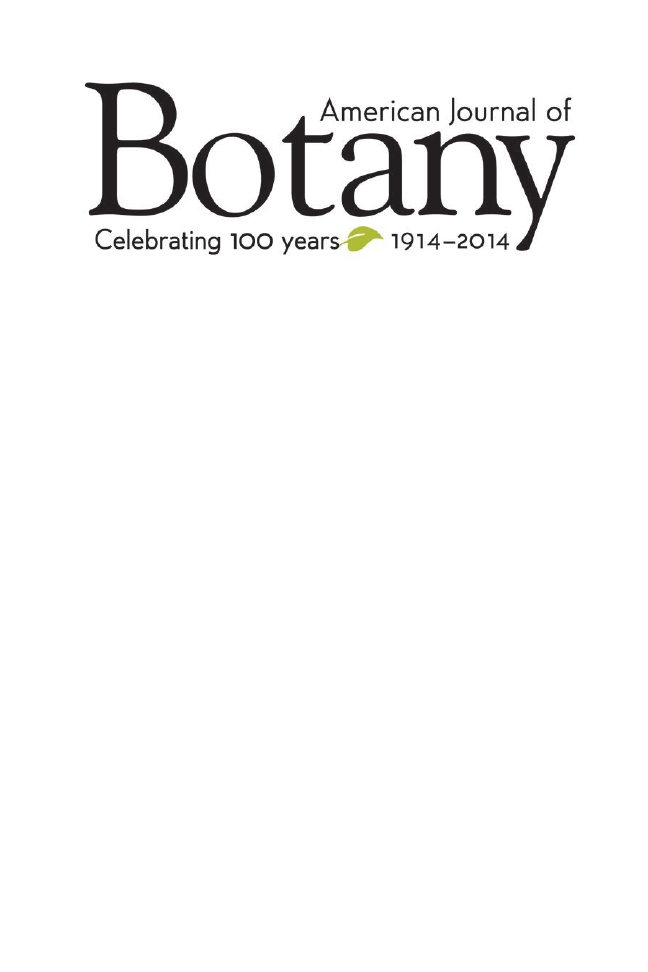
134
Plant Science Bulletin 60(3) 2014
The American Journal of Botany Centennial Celebration
Continues through out 2014
The celebration of the first 100 years of the American Journal of Botany continues! The first two issues of
the PSB this year have featured interviews with some of the AJB’s most prolific authors over the years, and
this issue features interviews with more members of this elite group, as the following pages show.
The AJB has been promoting its anniversary with the special Centennial Review papers, which have
appeared every month this year. These papers take a look at key research from the AJB’s past and re-
examines and updates the research to find where the field stands now and into the future. The following
AJB Centennial Review articles are already available and can be accessed for free:
• “The relative and absolute frequencies of angiosperm sexual systems: Dioecy, monoecy, gynodioecy,
and an updated online database” by Susanne S. Renner [101(10):1588, 2014]
• “Phloem development: Current knowledge and future perspectives” by Jung-ok Heo, Pawel Roszak,
Kaori M. Furuta, and Ykä Helariutta [101(9):1393, 2014]
• “The role of homoploid hybridization in evolution: A century of studies synthesizing genetics and
ecology” by Sarah B. Yakimowski and Loren H. Rieseberg [101(8):1247, 2014]
• “The polyploidy revolution then…and now: Stebbins revisited” by Douglas E. Soltis, Clayton J.
Visger, and Pamela S. Soltis [101(7):1057, 2014]
• “Plant evolution at the interface of paleontology and developmental biology: An organism-
centered paradigm” by Gar W. Rothwell, Sarah E. Wyatt, and Alexandru M. F. Tomescu [101(6):899, 2014]
• “Is gene flow the most important evolutionary force in plants?” by Norman C. Ellstrand [101(5):757, 2014]
• “Repeated evolution of tricellular (and bicellular) pollen” by Joseph H. Williams, Mackenzie L.
Taylor, and Brian C. O’Meara [101(4):559, 2014]
• “The voice of American botanists: The founding and establishment of the American Journal of
Botany, ‘American botany,’ and the Great War (1906-1935)” by Vassiliki Betty Smocovitis [101(3):389, 2014]
• “The nature of serpentine endemism” by Brian L. Anacker [101(2):219, 2014]
• “The evolutionary-developmental origins of multicellularity” by Karl J. Niklas [101(1):6, 2014]
• “The American Journal of Botany: Into the Second Century of Publication” by Judy Jernstedt
[101(1):1, 2014]
These articles are also hosted at botany.org/ajb100, and the site also hosts other free content---
nearly 1000 articles from the history of the AJB, as written by the journal’s top 25 contributors! The AJB is
one of the few surviving plant science publications published by a non-profit scientific society. The journal,
and its authors, reviewers, editors, readers, and subscribers, are at the heart of the Botanical Society of
America, and the strength of this connection makes the AJB stand out from many other journals.

135
Plant Science Bulletin 60(3) 2014
Ray Evert
Ray Evert joined the BSA in 1955---nearly 60
years ago!---and served as the Society President in
1986. He also won the the Society’s most prestigious
award, the BSA Merit Award, in 1982. Ray went
on to publish 39 articles in the American Journal
of Botany, and he recently took time to discuss his
career and some of his key AJB research.
My first article published in AJB was “Some
aspects of cambial development in Pyrus communis”
in 1961. My principal research interest at the
time was the vascular cambium and seasonal
development of the secondary phloem in trees.
Katherine Esau was my major professor, and my
Ph.D. thesis (Phloem structure in Pyrus communis
and its seasonal changes. Univ. Calif. Publ. Bot.
1960.32, 127-194) was patterned after her similar
study on the grapevine.
Two articles (my latest) were published in AJB
in 1994 and dealt with vastly different topics
(“Ontogeny of the vascular bundles and contiguous
tissues in the maize leaf blade” by A.M. Bosabalidis,
R.F. Evert, and W.A. Russin; the other, “Development
and ultrastructure of the primary phloem in the shoot
of Ephedra viridis (Ephedraceae)” by R.A. Cresson
and R.F. Evert.
As indicated, my early research was on the
vascular cambium and seasonal development
of the secondary phloem in trees (eudicots and
conifers). With the advent of electron microscopy,
I began ultrastructural studies on the phloem of
woody and herbaceous eudicots, monocots, and
gymnosperms. This was followed by extensive
studies on the comparative ultrastructure of
seedless vascular plants, ranging from Psilotum
to a broad array of ferns. In 1978, my research
shifted to studies on the development and structure
of leaves of selected C3 and C4 plants, utilizing
bright-field and electron microscopy and a variety
of experimental procedures to gain a greater
understanding of structure-function relationships
in leaves. Among the plants studied were several
economically important crop plants: barley, maize,
sugarcane, sugar beet, and potato. Finally, my group
concentrated on developmental and structural
changes accompanying the transition of maize
and barley leaves from importers to exporters of
photoassimilates, a process commonly refereed to
as sink-to-source transition. I emphasize “group,”
because without my graduate students (25 PhDs,
23 MS) with their energy, enthusiasm, intelligence,
and innovativeness, I would have achieved far less
of my research goals.
My research interests never strayed far from the
phloem. It was during a seminar in 1953, while
working for the MS in Botany at Penn State, that
I became interested in phloem. There and then I
decided to pursue a PhD, with some aspect of the
phloem as my thesis topic. When I told this to
my MS mentor, Dr. David Kribs, he told me that
I must go to UC-Davis to work with Katherine
Esau. Shortly after my conversation with Dr. Kribs
I received a letter from Dr. Esau informing me that
Dr. Kribs had written to her on my behalf, and
that she would be happy to accept me as one of her
graduate students; moreover, she had a teaching
assistantship for me. I became her “phloem ray.”
Electron microscopy was in its infancy in the
early 1960s, so I could not have foreseen the
ultrastructural research undertaken by my students
and me. Nor could I have foreseen the splendid
collaborative research undertaken on aspects of
leaf structure and function with Walter Eschrich
(University of Gottingen, Germany) and C.E.J.
Botha (Rhodes University, South Africa).
It is difficult to choose one or two of my articles
published in AJB that stand out above the others.
One of the earliest articles (“Callose substance
in sieve elements”, 1964) is significant because it
demonstrated that the sieve pores of uninjured
sieve elements are virtually devoid of callose. The
article that was the most fun was “Observation
on penetration of linden branches by stylets of the
aphid Longistigma caryae” (1968), in which we
Ray Evert and Katherine Esau, April 1968, in
Madison, WI.
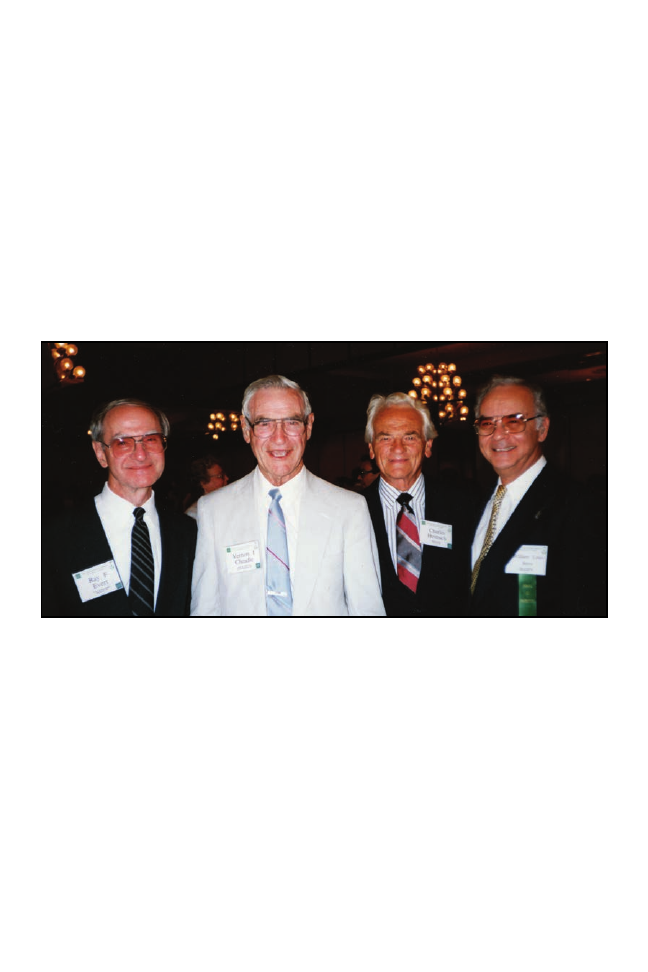
136
Plant Science Bulletin 60(3) 2014
demonstrated that sieve tubes greater than one year
old are still functional.
Why have I chosen AJB as one of the journals
in which to publish? AJB is the premier botanical
journal with a broad readership. Its reproduction
of micrographs, both photo and electron, is superb,
a matter of great importance to an anatomist. And
then, there is a matter of loyalty—AJB is “home.”
Dr. Evert’s complete list of AJB publications, which
are free for viewing throughout 2014, can be found at
https://botany.org/ajb100/revert.php.
Lef to right: Ray Evert, Vernon Cheadle, Charles Heimsch, William Stern, August 1989, in Toronto.

137
Plant Science Bulletin 60(3) 2014
Harvard was a place of almost total personal and
academic isolation for me—although Barbara and
Grady Webster, who were refreshingly friendly,
were there that year. I used the time to get my
thesis ready for publication and I wrote five other
papers. One of the papers I wrote was on pectic
warts, curious extrusions of pectic droplets into
intercellular spaces of certain plants. At the time
I was about to write this paper, my holiday-season
eviction from my rented room was looming. I did
not want to take a winter vacation in a snowy city like
New York. One was not allowed to sleep overnight
in one’s office in the Biological Laboratories—a
watchman signed one in and out, preventing that.
However, I had a key to the then-new herbarium
building. Nobody was in the building at night, and
nobody had used the darkroom. So for the holidays,
I was in my Biological Laboratories office during
the day, and I slept on plant press blotters laid on
the floor of the Herbarium darkroom at night.
I was determined to produce a positive outcome
from this experience, so I decided that the outcome
would be the paper on pectic warts, and that I
would try to get it published in American Journal of
Botany. A sort of revenge–triumph gesture. It did
appear in American Journal of Botany in 1956, the
first paper of mine to appear (“On the Occurrence
of Intercellular Pectic Warts in Compositae,” 43(6),
425).
The following year I took the job at Claremont—
the best possible job in botany, my first and last. I
had great students at Pomona College, a first-rate
liberal arts college, and at the Rancho Santa Ana
Botanic Garden, I had an office and laboratory.
It hosted a graduate program and had a truly
astonishingly great library—much better than a
job at a big university. Immediately my research
program took off, and almost every year for the
first several years after I took the job, I published
various papers in AJB. The 1957 paper (“Leaf
Anatomy and Ontogeny in Argyroxiphium and
Wilkesia (Compositae),” 44(8), 696) was about the
leaf anatomy of the famed Hawaiian silversword. It
manages life on alpine volcanic cinders by storing
water in pectic gels extruded into intercellular
spaces of the leaf—so in a sense, it was a follow-
up to the 1956 paper on pectic warts. It was also
a clue that the Hawaiian silverswords were related
to the Californian tarweeds, some of which also
had the foliar pectic gels. I became certain by 1959
that the Hawaiian silverswords and the Californian
tarweeds were related, but was widely disbelieved
Sherwin Carlquist
Dr. Sherwin Carlquist joined the BSA in
1955---nearly 60 years ago---and published his
very first article the following year in the American
Journal of Botany. He has received numerous
awards over his career, including the Grady L.
Webster Publication Award in 2011 and the BSA
Merit Award (the Society’s highest honor) in 1977.
Dr. Carlquist recently shared his thoughts about his
career and publications.
In the winter of 1955-56, after finishing my
graduate work at Berkeley, I thought that a learning
experience in a different locality would be of value,
and I had a postdoctoral fellowship from NSF I
could take anywhere. I chose Harvard, hoping to
imbibe some wisdom about plant anatomy from
I. W. Bailey—he was retired, but said he would be
available. I got a room off campus. Adequate, but
the owners of the house said that I would have to
vacate at Christmastime when their children came
home. I accepted the deal, figuring that I could go
see New York at that time or something.
As it turns out, Harvard was not a good choice.
I. W. Bailey was so ostracized for being the author
of the “Bailey plan” to unite botanical facilities at
Harvard that he spent the year out of town, and I
saw him for a total of only an hour or two. Ralph
Wetmore did come to my office weekly, but for only
one purpose: to try to dissuade me from working
in comparative plant anatomy. He thought that his
brand of morphogenesis (long since superseded)
was where the future lay and that I was misdirected.
Sherwin Carlquist at a scanning electron microscope
in the midst of his research.

138
Plant Science Bulletin 60(3) 2014
until Bruce Baldwin’s molecular work showed
indisputably that the two groups were related (a
hybrid was even made!).
Most of those who published frequently in
American Journal of Botany tended to have a central
theme—like Norman Boke and his papers on cactus
areole ontogeny. But I tried to put my best papers
representing a wide range of interests in the AJB.
The papers had to be brief ones—the long papers
had to go elsewhere. And also, I was publishing
actively and so I could put only a fraction of my
papers in any one journal.
For the last decade, I have been devising large-
scale synthetic views of wood and primary xylem
evolution, and these are too big to be published
in AJB. AJB and other “high-impact” journals
have become the provinces of ambitious young
professors, whose placement of research papers
in such journals becomes their ticket to success
in obtaining grants and in securing professional
advancement. Fortunately, my research is a low-
cost field, and I am able to finance my research
largely out of my own pocket. Thus, the “impact
factor” becomes irrelevant to me, and while
publication of my results is still a very essential part
of my research, the precise venue for publication
doesn’t matter. I’m not turning my back on the
high-impact journals so much as enjoying the
freedom to cast my work in papers representing
interdisciplinary interests that inevitably require
greater length. These long papers, ironically, do
not have bigger audiences (too much background
in too many fields is required, compared to single-
topic papers)—so publishing them in AJB would be
a disservice to that journal.
Whatever pathway one takes that preserves one’s
research interests is good—and these pathways do
change over time. I am very grateful that AJB has
been willing to host my research, and to maintain
a high degree of diversity in what it offers readers.
Dr. Carlquist’s complete list of AJB publications,
which are free for viewing throughout 2014, can be
found at https://botany.org/ajb100/scarlquist.php.
Find out more about his entire career and research at
http://www.sherwincarlquist.com/.
Dr. William Crepet
Cornell University
Dr. William Crepet first started publishing in the
AJB in 1972 and joined the BSA 6 years later—
and he’s been a Society member and AJB author
ever since. Over this time, he published 28 articles
thus far in the AJB, and in 2007, he won the BSA
Merit Award, the Society’s highest honor. Dr. Crepet
recently reflected on his AJB publications and career.
The first article you published in AJB was
“Investigations of North American Cycadeoids:
Pollination Mechanisms in Cycadeoidea” in
1972. Take us back to that period; where were
you, what were you doing, and what were you
studying/most interested in at the time?
At that time I was a second year graduate student
at Yale with Ted Delevoryas, my advisor, and Ian
Sussex and Don Levin on my graduate committee.
At the time G. Evelyn Hutchinson was teaching
Ecological Principles, and he was also a significant
influence on how I viewed studying paleobotany.
Peers were also an important influence and mine
included colleague Barbara Schaal, and office
mates Ginny Walbot and Rod Gould (later to
become a successful businessman in Australia). I
was quite interested in explicating the details of
cycadeoidean reproductive biology. I was furiously
breaking promising well-preserved cycadeoid
trunks from the enormous Yale collection, amassed
by G. R. Wieland in the late 19th century, with a
sledgehammer and then trimming the pieces
with oil-lubricated diamond saws in order to
make it possible to mount and section the cones.
Our equipment was certainly crude by today’s
standards, and technique execution (probably not
that different from the techniques used by Wieland)
made all of the difference. I suppose many of my
peers would say that graduate school was one of the
best times in their professional lives and this was
certainly true for me. The excitement of discovery
combined with the inspiring environment,
wonderful peers and peerless committee made it a
fabulous experience.
Your latest article in the AJB was “Darwin’s
second “abominable mystery”: Why are there so
many angiosperm species?” in 2009. How has
the thread of your research changed over time?
In a sense, I have always been interested in the
evolution of reproductive biology in plants and in
the evolutionary implications of shifting strategies
in plant reproductive biology. I made a transition

139
Plant Science Bulletin 60(3) 2014
morphological studies in paleobotany, especially in
the angiosperms where there was a paucity of such
reliable studies outside of those concentrating on
leaves and pollen.
There has always been a balance in paleontological
studies between the generation of reliable data
(that is the generation of detailed descriptions
and determination of affinities of fossil taxa) and
the analysis of patterns based on these data. My
emphasis has shifted somewhat to exploring the
implications of certain patterns now that the record
of key fossils (both organs and taxa) in seed plants,
particularly angiosperms, has improved enough to
allow such analyses.
In looking back at all of the articles you’ve
published in AJB, which ones stand out above the
others and why?
I would say illuminating details of cycadeoid
reproductive biology, while esoteric (Investigations
of North American cycadeoids: Pollination
mechanisms in Cycadeoidea. AJB 59: 1048, 1972),
stands out and fleshes out our understanding
of an important extinct group of plants. With
respect to angiosperms, a variety of detailed
studies of charcoalified Cretaceous flowers from
the Turonian deposits of New Jersey set the bar for
both description of fossil flowers in detail and the
methods used to assess their phylogenetic position.
These studies seem to have had a positive effect
of the standards used in such studies in the field
in taxa of interest when moving from Cycadeoidales
(Bennettitales) to angiosperms when I left Yale and
began a really enjoyable and productive postdoc in
David Dilcher’s lab at Indiana University. Although
the taxa of my principal interest shifted, I remained
focused on the evolution of reproductive biology
in plants and I think it is fair to say that together
with David who very generously shared great fossil
material with me, really initiated the sustained
research on angiosperm flower fossils that persists
and is important today. I would be neglectful if I did
not mention my early and enjoyable collaborations
with Else Marie Friis, who was a pioneer in the
study of charcoalified angiosperm flowers.
There is no doubt that two major influences
affected the thread of my research subsequently:
the advent of precise phylogenetic methodologies
and of course nucleic acid based phylogenetics.
These contributed to the establishment of reliable
patterns in the fossil record in a number of ways.
One of which was by allowing a more objective
method for positioning fossil taxa that have
unique combinations of characters relative to their
extant relatives. Hence a great deal of my research
effort has gone into the precise identification of
angiosperm taxa in order to establish a reliable
pattern and exploit its implications. This aspect of
my research has been greatly aided by my colleagues
at Cornell who had pioneering influences in
phylogenetic methodologies, notably including
Kevin Nixon. The fact that my colleagues at Cornell
were also adept at angiosperm systematics and
had ancillary or direct interests in paleobotanical
research, especially Alejandra Gandolfo and Karl
Niklas, greatly affected my research trajectory
and this paper with Karl is an example of such
an interaction in my favorable intellectual
environment. In this particular paper, we examine
how, among other factors, reproductive strategies
may be involved in flowering plant evolutionary
success in the context of the fossil record.
In looking back over the course of your research,
what areas have you consistently explored? What
areas did you not expect to explore?
As noted before, I consistently explored the
history of reproductive structures and strategies
in plants. However, I wasn’t sure I would be
immersed in systematics and phylogenetics when
my career began. Certainly phylogenetics was in
the early stages of development as a field and in
general, there was still a need for careful structural
William Crepet, dressed up in his days at Yale in
the 1970s.
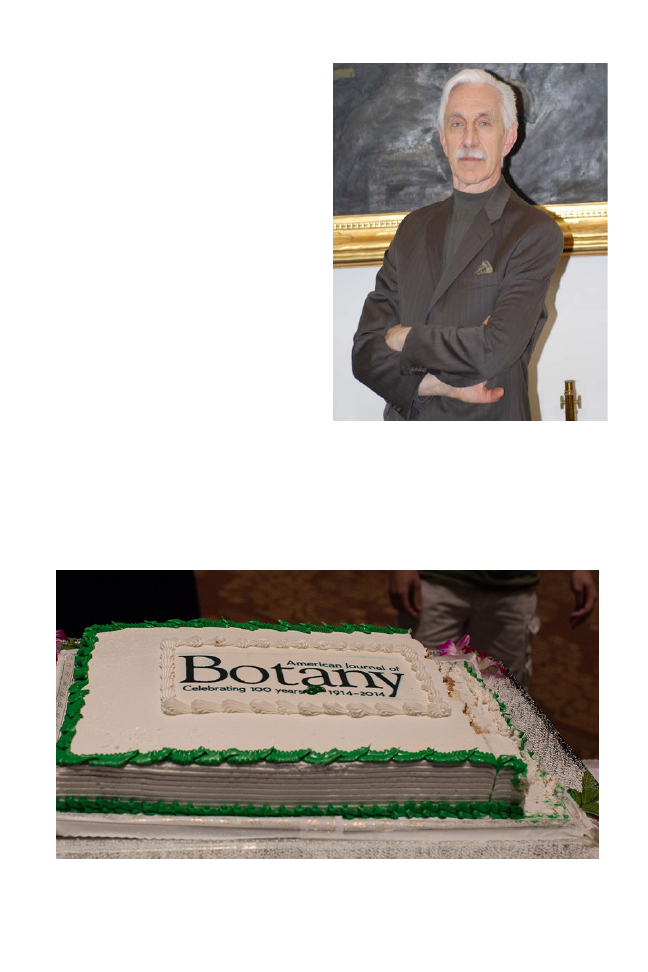
140
Plant Science Bulletin 60(3) 2014
in general and are data significant to a set of the
remaining major evolutionary mysteries grouped
under “Darwin’s Abominable Mystery” (the
reasons explaining angiosperm relative success and
explanation of angiosperm origins).
The 2004 paper with Kevin Nixon and Maria
Gondolfo (Fossil evidence and phylogeny: the age
of major angiosperm clades based on mesofossil
and macrofossil evidence from Cretaceous deposits,
91:1666) is important because it provides a well-
rationalized and carefully constructed fossil record
of angiosperms based conservatively on the most
reliable evidence, creating a baseline pattern
for angiosperm history that also introduced an
independent means for inferring minimum ages for
taxa that do not have adequate fossil records that is
independent of, but complementary to, molecular
clock-based models.
Why have you chosen AJB as one of the
journals in which you’ve published throughout
your career?
The AJB had an excellent reputation when I was a
graduate student and was an appropriate venue for
the kinds of papers that I submitted for publication.
It has maintained its quality and appropriate
readership.
Dr. Crepet’s complete list of AJB publications,
which are free for viewing throughout 2014, can be
found at https://botany.org/ajb100/wcrepet.php.
William Crepet, 2012.
The Botanical Society of America took a minute to honor the AJB with a special celebration at Botany 2014.

141
new botanical society be formed to unify and serve
the general interests of the American botanical
community (Steer, 1958). Although at the next
meeting of the American Botanical Club (in
Madison, Wisconsin), Bailey was made chairman
of a committee to investigate the feasibility of his
proposal and “A letter from Mr. L. H. Bailey . . . was
read as virtually the report of the majority in favor
of abandoning the attempt . . . .” (Steere, 1958).
Fortunately, Bailey’s advice was not followed and
the new society was formally created in 1894 and
William Trelease was elected as its first president.
REPORTS
Cornell University Celebrates its
Botanical Roots
Edward D. Cobb
Department of Plant Biology, Cornell
University
Email: ec38@cornell.edu
DOI: 10.3732/psb.1400007
Submitted 13 October 2013.
Accepted 30 July 2014.
This article presents a brief history of the plant
sciences at Cornell University in recognition of
the department’s pivotal role in USA academics
ever since the University opened its doors in
1868. The primary justification for presenting
this history rests on the fact that Cornell’s botany
faculty and former students have played important
roles in the Botanical Society of America and the
American Journal of Botany since the formation
of the BSA and the AJB; for example George
Francis Atkinson (1907), Joseph C. Arthur (1919),
Benjamin W. Duggar (1923), Liberty Hyde Bailey
(1926), Margaret C. Ferguson (1929), Karl M.
Wiegand (1939), and Harriet B. Creighton (1956)
served as presidents of BSA. Judith Skog and
Karl J. Niklas have served more recently in this
capacity. In addition, many Cornellians have
served as other officers of the BSA. Likewise, many
have been awarded BSA merit awards including
Bassett Maguire (1990), W. Hardy Esbaugh (1992),
Dominick J. Paolillo, Jr. (1998), Jack B. Fischer
(2003), William L. Crepet (2007), Dennis Stevenson
(2010), and Charles B. Beck (2013).
Indeed, in 1892, L. H. Bailey first suggested that a
Thereafter, 21 Cornell botanists have served as
presidents, including the original dissenter and
founding instigator L. H. Bailey.
The histories of the botanical and plant science
departments at Cornell University are rather
complex (Fig. 1). However, the first bona fide
botanist to be hired to the department was Albert
N. Prentiss, (Fig. 2), who was born in Cazenovia,
NY in 1836. Prentiss received both his B.S. and
M.S. degrees from Michigan Agricultural College
and, at the age of 32, became the first faculty
member and Chair of the Department of Botany,
Horticulture, and Arboriculture in the College of
Natural Sciences in 1868. It should be remembered
that, during the 1870s, there were probably fewer
than six professorships of botany in the U.S.
Although botany classes were held during the first
semester with comparatively few students, the
popularity of classes grew rapidly and enrollment
increased swiftly, making it difficult to find space
for lectures. The first classes were held in Morrill
Hall, which was originally called South Hall. During
the following Spring semester, botany classes were
held in the wooden chemistry building, which was
on the present day site of Sibley Hall. As class sizes
increased, lectures were held in various, scattered
rooms around campus.
Before the end of 1875, botany moved to its first
permanent space in the southeast wing of Sage
College (Fig. 3), which was also called Sage Hall.
Funded by Henry W. Sage, Sage College was built
as a residence and dining hall for female Cornell
students (Cleland and Stundtner, 2011), many
of whom took courses in botany. Soon after its
construction, a three-story addition was added
for the botany department. Prentiss described the
new space as “a large lecture-room, thirty-six by
fifty-eight feet, with seating for 156 students, which
may be increased to 200 on demand. Adjoining
the lecture- room is the principal laboratory,
sixty feet in length and twenty-eight in breadth
. . . . Adjoining this laboratory . . . is a laboratory
and office, eighteen by twenty-three feet, for the
use of the professor in charge of the department”
(Prentiss, 1890). In the Fall of 1875, botany course
enrollments grew substantially. The enrollment of
some of the larger classes was over 175 students.
The department taught many courses including
agricultural horticulture and landscape gardening.
The curriculum continued to grow, and, in 1877,
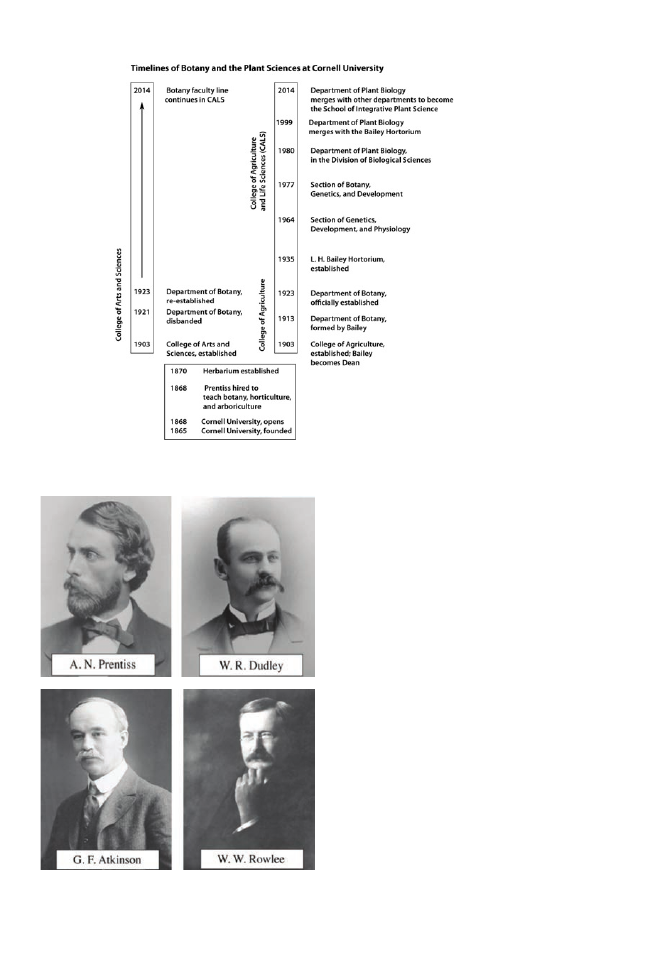
142
Plant Science Bulletin 60(3) 2014
courses dealing with pteridology and phycology
were taught in the Spring and Fall semesters.
In 1881, a conservatory was built for the botany
department with funds once again provided by
Henry W. Sage (Fig. 4). The conservatory was
dedicated in May or June 1882. It was a large
structure measuring over 150 feet long with several
rooms that could be held at different temperatures
and humidities. The complex was designed by the
Lord Company, which became Lord & Burnham in 1890.
The Importance of the Early
Students
Plant biologists were relatively rare at the time
botany was prospering at Cornell. Consequently,
many of the early students in the botany department
also served as laboratory or field instructors. The
first student to obtain a degree in botany at Cornell
was David Starr Jordan. Jordan, who was born in
Gainesville, New York, in 1851, was also the first
student instructor in botany at Cornell. Although
he entered as a B.S. degree candidate, he did such
a notable job as an instructor that the department
awarded him its first M.S. degree in 1872 based
on his thesis titled The Flora of Wyoming County,
Figure 1. Timelines of botany and the plant sciences at Cornell University.
Figure 2. Faculty of the early years. (1868-1922):
Prentiss (1868 – 1896), Dudley (1876 – 1891),
Atkinson (1892 – 1918) and Rowlee (1893 – 1922).
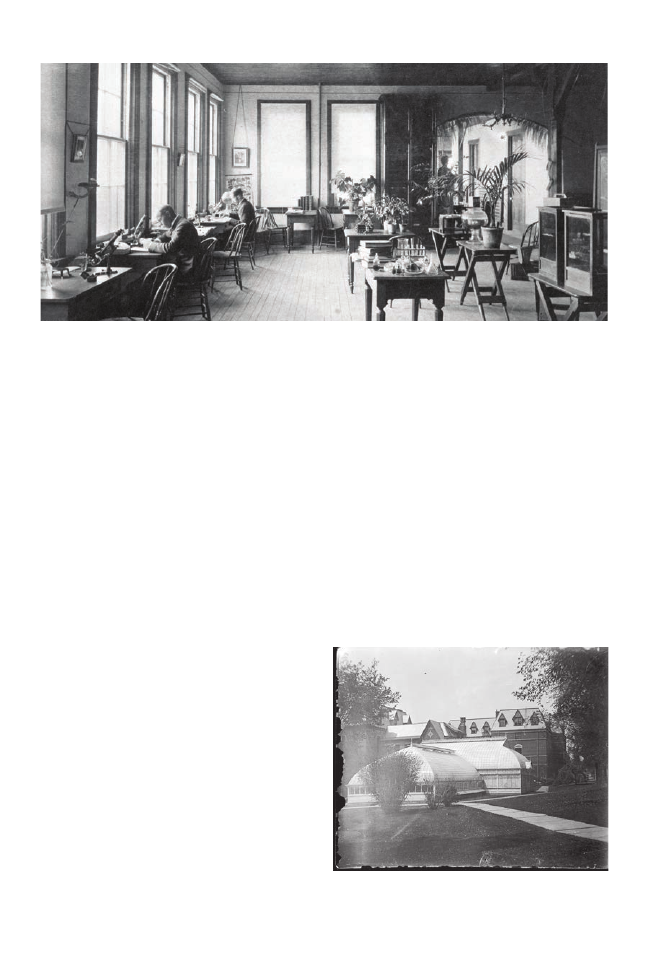
143
Plant Science Bulletin 60(3) 2014
raise and for improved laboratory space. Dudley
wrote to former fellow student G. F. Atkinson
explaining his situation and reasons for wanting to
leave Cornell. Beside a low salary, Dudley felt that
the administration did little to promote scientific
research and did not appreciate his work. Dudley
was offered a job at Wabash College, but he was
eventually recruited by David Starr Jordan to join
the faculty at Stanford University in 1892. Dudley,
who was 42 years old at this time, took some of
his herbarium specimens with him. He would
eventually build the number of specimens to over
120,000 sheets, mostly representing the flora of
California.
William Trelease was born in Mount Vernon,
NY, and received his B.S. degree in 1880 in botany.
N.Y. Jordan later distinguished himself as the first
president of Leland Stanford Jr. University, later
simply called “Stanford”.
William Rane Lazenby, who received his B.
Agr. in 1874, was an instructor in horticulture and
the superintendent of the botanical and general
gardens. In 1879, he was named assistant professor
of Horticulture. Lazenby resigned in 1881 to accept
a position at Ohio State University where he later
became the first director of the Ohio Experiment
Station (Cornell Alumni News, Vol.1, No.11, 1899).
Another early student was William Russell
Dudley who obtained a B.S. degree in 1874 and
an M.S. in 1876, both in botany. Dudley was an
instructor of botany from 1875-1876, after which
he was appointed as an assistant professor in 1876.
Dudley taught many courses including horticulture
after W. R. Lazenby left Cornell in 1881 but his
main area of teaching was cryptogamic botany.
In 1886, he published The Cayuga Flora. Part 1:
A catalogue of the Phaenogamia growing without
cultivation in the Cayuga Lake basin, which
catalogued some 1278 species and varieties of
plants found in the Cayuga Lake area. Dudley
joined the Cornell Experiment Station in 1888 after
he had studied mycology in Europe with Heinrich
A. DeBary and became the cryptogamic botanist
for the newly formed Agricultural Experiment
Station. Dudley began working more with fungal
diseases of plants, both ornamental and cultivated
crops, than actually researching plants per se. After
many years as an assistant professor and no salary
increase, Dudley pushed President Adams for a
Figure 4. Sage Conservatory circa 1920. (Image
from the author’s collection.)
Figure 3
.
Botany laboratory at Sage College. (Image courtesy of the Cornell Plant Pathology Herbarium.)

144
Plant Science Bulletin 60(3) 2014
she donated to Huguenot College is still used
as a retreat to this day (Jasper Slingsley, personal
communication, Dec. 2010).
Karl McKay Wiegand was born in Truxton, New
York in 1873 and attended Ithaca High School. He
obtained a B.S. degree in 1894 for a thesis titled A
critical study of the order Ranunculaceae from the
standpoint of the fruit and a Ph.D. degree in 1898
for a thesis titled Investigations on the sporogeny
and embryology of certain monocotyledons. After a
brief position as Associate Professor of Botany at
Wellesley College, west of Boston, Wiegand became
the first department chair for the new Department
of Botany established on February 1, 1913 in the
College of Agriculture at Cornell.
Benjamin Minge Duggar received his Ph.D.
degree in 1898 for a thesis titled On the morphology
of the gametophyte and the development of the
sporangium in some angiosperms. He was an
instructor from 1896 to 1900 and an Assistant
Professor of Botany from 1900 to 1901. Duggar was
Professor of Botany at the University of Missouri
from 1902 to 1907. He returned to Cornell in
1907 to become the Chair of the first Department
of Plant Physiology at Cornell, a position he held
until 1911. After his retirement, at age 71, Duggar
discovered chlorotetracycline (Aureomycin) from a
soil bacterium. He was to remain a life-long friend
He assisted Dudley with The Cayuga Flora and
went on to become the director of the Missouri
Botanical Garden where he directed a 75 acre
garden for over 20 years. He was a gifted botanist
and taxonomist who also taught at the University
of Illinois (where Trelease Woods is named in his
honor). He published many papers and several
books including Winter Botany in 1918 as well as
many practical guides for gardeners. Trelease was
elected the first president of the Botanical Society of
America (BSA) in 1893.
The first Cornell doctorate in botany was awarded
to Joseph C. Arthur in 1886. Arthur, who was born
in Lowville, NY, held several positions including
that of botanist at the Geneva Experiment Station
from 1884 to 1886. Arthur took no formal classes
at the main campus. He later became professor of
botany and head of the Department of Botany and
Plant Pathology at Perdue University. He devoted
his life to the study of rust fungi.
Willard Winfield Rowlee came to Cornell in
1884. He completed his B. L. degree in 1888, and
became an instructor the same year. He completed
his D.Sc. in 1893 and joined the department as
an assistant professor (for additional details, see
below).
George Francis Atkinson obtained a Ph.D. from
Cornell in 1885 and was named Assistant Professor
of Crytogamic Botany in 1892 when he replaced W.
R. Dudley. Atkinson served as department Chair
from 1896 until 1918. He wrote five botanical books
and later devoted much of his time to mycology.
Jane Eleanor Datcher was the first African
American woman to receive an advanced degree
at Cornell. She received her B.S. degree in 1890
for a thesis entitled A biological sketch of Hepatica
triloba. Datcher attended Howard Medical School
from 1893 to 1894 and went on to teach chemistry
from 1892 until 1934 at Dunbar High School in
Washington, D.C. Many of her relatives would
eventually obtain Cornell degrees (Kammen, 2009).
Bertha Stoneman received her Ph.B. in 1894 for
a thesis entitled Zygnemaceae cayugensis and her
D.Sc. degree in 1896 for A comparative study of the
development of some anthracnoses. Stoneman was
the first woman to get her doctorate in Botany at
Cornell. She became a faculty member at Hugenot
College in Wellington, Cape Colony (South Africa)
in 1897 and also served as president of Huguenot
College from 1928 to 1933. Stoneman wrote Plants
and their ways in South Africa. The property
of L. H. Bailey.
Margaret Clay Ferguson was born in Orleans,
N.Y. She attended Cornell from 1897 to 1901.
Studying under George F. Atkinson, she received her
B.S. degree in 1899 based on a thesis titled A study
of the sporogeny of Pinus strobus and a Ph.D. degree
in 1901 for a thesis titled The development of the
pollen tube and the division of the generative nucleus
in certain species of pine. She also did research with
B. M. Duggar that was published in 1902 as the first
successful germination of the spores of Agaricus
campestris. Ferguson became a full professor and
the Chair of the Department of Botany at Wellesley
College (Wellesley, Massachusetts), where she
studied plant physiology and genetics. She was
the first woman to be elected as a vice president of
BSA in 1922 and went on to become its first female
president in 1929. The Margaret C. Ferguson
Greenhouses and Visitor Center at Wellesley were
named in her honor.
(Ella) Maude Cipperly Wiegand, who received
her A.B. degree in 1904, was an instructor in botany
at Cornell from 1898 to 1905. She and Karl M.
Wiegand were married in 1906. From 1905 until

145
Plant Science Bulletin 60(3) 2014
1912, she was an instructor of botany at Wellesley
College to which she donated 1000 herbarium
specimens. Maude, as she affectionately became
known, became a staff member in botany at Cornell
in 1913 where she taught and prepared materials
for class. She was clearly devoted to the students
and the University. She sold Liberty Bonds for the
University in 1918 (Cornell Alumni News, April,
1918) and she was remembered fondly for all that
she did for the botany students including her famous
steak cookouts. She insisted on buying sirloin
steaks and preparing them for the many Summer
and Winter field trips. The food was transported
in a Model T Ford, which was the first department
vehicle purchased by Karl Wiegand. Summer field
trips were to McLean Bogs, Junius Ponds, Enfield
Gorge (Fig. 5), Taughannock, Coy Glen, Buttermilk
and Fall Creek. The Winter picnics were held in the
gorges including Enfield Gorge.
The Beginning of the End of the
“Other School”
In the College of Arts and Sciences, botany
followed a different path. After W. R. Lazenby left
Ithaca, W. R. Dudley was asked again to help Prentiss
teach horticulture. Prentiss asked Cornell President
Charles Kendall Adams for a faculty member to fill
the need in horticulture, but Adams retorted that
no one could be found (Cornell Alumni News, Vol.
1-No. 11, 1899). Eventually someone was and that
person was none other than Liberty Hyde Bailey,
who was hired in the Botany Department as a
professor of general and experimental horticulture.
By the Fall of 1888, Bailey was giving lectures. He
became the Chair of Horticulture in 1889. With the
building of the Sage Conservatory greenhouses in
1882, the field of floriculture and the construction
of practical greenhouses had greatly advanced. In
1889, the first forcing house was built on campus by
Bailey. These facilities, along with the designation
of approximately 20 acres of land for use by
horticulture, gave horticulture a major boost.
Around the same time, Albert Prentiss had taken
on many responsibilities on the Cornell campus.
He was in charge of the campus grounds and its
landscape, and in that capacity he was responsible
for planting many trees on the campus grounds,
which were subsequently removed to make room
for new buildings and roads. Unfortunately, at the
time of his death, only a few gymnosperms that
he had planted were still surviving (Gardening,
1898) in part because the campus had grown so
rapidly and in a largely unplanned way. Indeed,
even faculty houses were removed to make way for
new teaching and research buildings. Nevertheless,
Prentiss could be very proud of the $300,000 that
was spent to pave the paths toward the central
campus. This was a major improvement for the
students that had been previously forced to walk
through mud to get to classes for several months of
the year. One can only imagine the condition of the
floors in the university buildings before these paved
paths were built.
In 1889, Willard W. Rowlee was appointed
instructor and taught pharmaceutical botany
as well as other topics. Rowlee also served as
superintendent of grounds from 1897 until 1911.
Previously Prentiss had been in charge of campus
plantings. In this capacity, Rowlee planted exotic
Figure 5. Collection trip to Enfield Gorge, c. 1898. From L to R: George F. Atkinson, Patrick B. Kennedy,
Paul W. Magnus, Benjamin M. Duggar, Fred C. Stewart and Karl M. Wiegand.
(Image courtesy of the
Cornell Plant Pathology.)
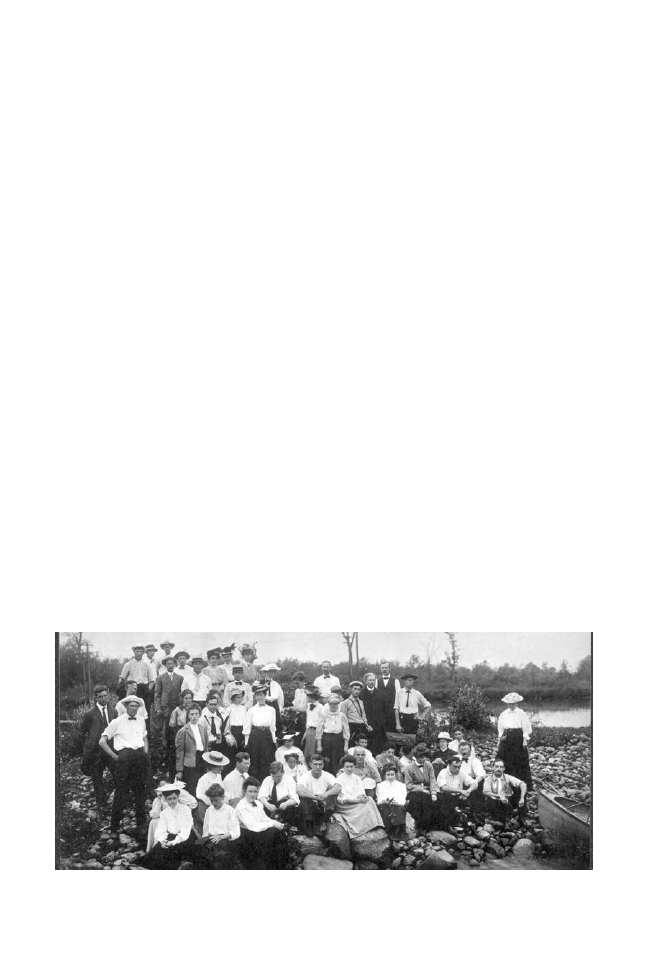
146
Plant Science Bulletin 60(3) 2014
trees, established a Crataegus collection (East of
the Crescent) and created a water garden in front
of the Veterinary School. He had a vision for an
arboretum and remained in the College of Arts
and Sciences wherein he served as Chair of the
department from 1918 to 1922.
In 1892, George F. Atkinson (Cornell Ph.D.
1885) was hired to replace Dudley. Atkinson
had been Chair of the Botany Department at the
University of North Carolina at Chapel Hill and
a Professor of Biology at the Agricultural College
of Alabama before returning to Cornell. Atkinson
was a mycologist as well as a botanist. He was also
interested in pollination and seed development in
the Pinaceae.
Albert N. Prentiss, who had been Chair for 28
years, was in poor health for several years. In the
winter of 1896, he retired and was named professor
emeritus for his long and faithful service to the
university. George F. Atkinson became the head
of the Botany Department and Willard W. Rowlee
was advanced to the rank of Associate Professor of
Botany (New York Times, March 9, 1896). Prentiss
died August 14, 1896 at the age of 60. After Prentiss’
passing, Rowlee became superintendent of grounds.
When the College of Arts and Sciences was
established in 1903, the Botany Department
was still located in Sage College. The facility was
cramped and outdated. Several greenhouses and
a conservatory were part of the occupied space.
During this time a first year botany course included
all the students not taking the zoology requirement.
Field trips to Junius Ponds (Fig. 6) were an annual
ritual for upwards of 40 students to see plants
not found in Tompkins County. Travel to Junius
Ponds was by boat or train and horse drawn buggy.
Today, Junius Ponds is an hour drive from Ithaca
(just down the road from the present day Waterloo
Premium Outlet Mall).
While collecting fungi, Atkinson became ill
and died of pneumonia in a hospital in Tacoma,
Washington on November 14, 1918. Upon
Atkinson’s death, Willard W. Rowlee became
department chair. Rowlee was involved with many
Cornell activities. He served as superintendent of
grounds, as the life-long secretary of his Cornell
graduating class of 1888, as the faculty advisor
for football and also as a trustee of the Athletics
Association. However, in 1921, the botany
department in the College of Arts and Sciences was
discontinued, and Rowlee was transferred in the
following year to the Department of Forestry as a
professor of dendrology. Rowlee died in 1923 after
a brief illness.
The botanical facilities in Sage College were
no longer considered adequate even though “The
name Department of Botany lingered on in the old
laboratories until 1923” (Thom, 1956). The Sage
Conservatory was deemed by the administration “a
superfluous structure” (Cornell Daily Sun, April 14,
1923). It was demolished on April 13, 1923. The
botany department was reinstated in the College of
Arts and Science in 1923. It remains a part of the
College of Agriculture and the College of Arts and
Sciences to this day.
Figure 6. Field trip to Junius Ponds c. 1906. Back row far right, K. M. Wiegand with vasculum, to his left,
E. J. Durand and to his left M. B. Thomas. In the lower right, second row, W. W. Rowlee. (Image courtesy
of the Cornell Plant Pathology Herbarium Photograph Collection.)

147
Plant Science Bulletin 60(3) 2014
Before the turn of the 20
th
century, the success
of the College of Agriculture required expansion
and thus new agricultural buildings. Liberty Hyde
Bailey was a key player in the founding of the new
College of Agriculture. He was named Dean of the
College of Agriculture after the retirement of Isaac
P. Roberts in the summer of 1903. Roberts came
to Cornell in 1874 as the Professor of Agriculture.
Subsequently he became Director of the College of
Agriculture and the Experiment Station. Pressure
had been building in NY State to expand the College
of Agriculture, and Bailey sought support from New
York state farm groups as he increased the faculty.
President Jacob Gould Schurman tried to secure
funds from the state, but wanted to keep control
of the college. After several years of lobbying by
agricultural organizations and some disagreement
between the Agricultural College Faculty and
Schurman, progress was made. The focus changed
from getting money for new buildings to securing
funding for a new College of Agriculture as an
official NY State institution (Colman, 1962). The
timing for the $250,000 funding of the college’s new
buildings was all important. Legislation, signed
by Governor Odell in May of 1904, procured the
necessary money to build Stone, Roberts and East
Roberts buildings (Fig. 7). Ground breaking began
on May 1, 1905 with the now famous plow pulled
by students with Bailey gripping the handles (Fig. 8).
Construction proceeded rapidly. By the Fall
of 1906, classes were held in the new building
complex. On April 27, 1907, Governor Charles E.
Hughes came to campus for the dedication. It was a
proud day for Bailey who, in his speech, proclaimed
that the State College fulfilled the dream of Ezra
Cornell. Bailey also paid tribute to Isaac P. Roberts
for his foresight and faith and for his “long, patient
and tenacious work” (Dorf, 1956).
The new buildings were occupied in 1907 by
several new departments created by Bailey. These
included the Departments of Plant Breeding,
Plant Physiology, and Plant Pathology, headed
respectively by Herbert J. Webber, Benjamin M.
Duggar, and Herbert H. Whetzel. Bailey had asked
Whetzel to head up a botany department, but
Whetzel selected Plant Pathology. Webber became
chair of the Plant Biology department but changed
the named to Plant Breeding in 1909 (Murphy
and Kass, 2007). Knudson became Assistant
Professor and acting chair of Plant Physiology from
1911 to 1913. Bailey pushed for the expansion of
departments and areas of study.
Botany in the New College of
Agriculture
Bailey quickly created other departments in
the new college in response to his great desire
to have as broad as possible a spectrum of the
plant sciences taught in the Agricultural College.
Curiously however, he delayed the formation of
the Botany Department in the new College of
Agriculture, probably because he felt there would
be resistance to this part of his plan, particularly
because the University was financially weak at this
time. Nevertheless, after intensive planning during
1912, the new Department of Botany in the College
of Agriculture was formed in February 1, 1913,
in large part because of the increasing demand
for more botanical instruction, which was to be
expected in a college devoted to agriculture in a
State wherein crops were a matter of great concern.
From its inception, the new botany department
was a hybrid, since it was merged with the former
Department of Plant Physiology (created in the
College of Agriculture in 1907). Bailey selected
Karl McKay Wiegand as the first head of the new
department. Wiegand had an intimate knowledge
of plant biology and how it was taught at Cornell,
having obtained two degrees from Cornell: a B.S.
degree in 1894 (thanks to Professors Prentiss
and Rowlee) and a Ph.D. in 1898 (with no major
professor acknowledged). Wiegand built the
reputation of his new department by hiring
Assistant Professor Lewis Knudson of Plant
Physiology and key instructors including Arthur J.
Eames, Maude C. Wiegand, Otis Freeman Curtis,
Figure 7. Former Cornell President Andrew D.
White breaking ground with L. H. Bailey for Stone,
Roberts and East Roberts buildings, May 1, 1905.
(Image of author’s original photo.)
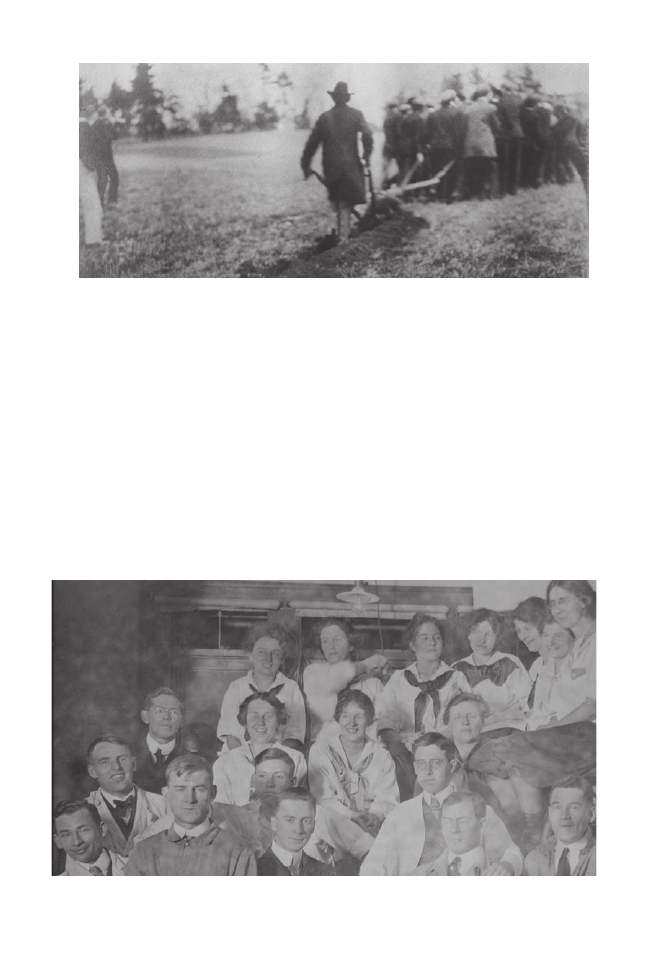
148
Plant Science Bulletin 60(3) 2014
the Agricultural College was met with resistance
by the new botany department faculty perhaps
because some felt threatened by “the new comers”
(Colman, 1962).
Within a few years of the College of Agriculture
moving into Stone, Roberts and East Roberts, the
buildings were filled beyond capacity (Fig. 10). The
botany group had shared space in Stone Hall with
Plant Pathology. Before Bailey retired as Dean there
was a push to build several new buildings including
a Plant Industries building. New York State funded
$135,000 for Bailey Hall and when it was completed
in 1913, Plant Pathology moved into offices and labs
in the basement. The Plant Industries building was
Figure 8. Bailey plowing the first furrow to mark the foundation for the new building. (Image courtesy
of the Bailey Hortorium Archives.)
and William J. Robbins. More faculty were added to
the department later, among whom Lester W. Sharp
(in 1914), Jacob R. Schramm (in 1915), Walter C.
Muenscher (in 1922), and Loren C. Petry (in 1925)
are perhaps best known. Many women were active
in the new department as can be seen in Figure 9.
The formation of the new botany department
was neither easy nor well received across the
University. Although Eames was brought into the
botany department in the Arts College in 1912, he
quickly transferred to the new department in the
College of Agriculture in 1913. The relocation of
Rowlee and other botanists from the College of
Arts and Sciences to the Department of Botany in
Figure 9. Botany department, 1915. Third row on left, Karl M. Wiegand, Maude C. Wiegand. Second row L
to R: Otis F. Curtis, Franklin P. Metcalf, William J. Robbins. Front row L to R: Ralph S. Nanz, Laurence H.
MacDaniels, Lester W. Sharp, Cecil C. Thomas and Arthur J. Eames. (Attributed to L. H. MacDaniels.)

149
Plant Science Bulletin 60(3) 2014
not funded until much later. Funding came from
the State of New York, backed by Governor Smith
and passed in 1927 after a seven-year fight in the
legislature. The new building brought together five
plant science departments and greatly improved
conditions for the faculty and students. Upon
completion in 1931, the Plant Industries building
became known as Plant Science.
Fortunately, the new department of botany in
the College of Agriculture flourished as it does
today. Wiegand himself continued to study the
local flora with the cooperation of students, staff,
A. J. Eames, and other faculty members. The Flora
of the Cayuga Lake Basin, New York, published in
1925, was an expanded version of the Cayuga Flora
by W. R. Dudley and others published in 1886.
Wiegand taught large courses with laboratory
and field components. He built a herbarium that
contained almost 300,000 specimens.
Early Faculty, Staff, and Students
The following provides brief biographical details
about the early faculty and staff in the newly created
Department of Botany in the College of Agriculture
(for more details, see Kass and Cobb, 2007).
Arthur J. Eames graduated from Harvard with
an A.B. degree (1908) and an A.M. degree (1910).
He came to Cornell in 1912 as an instructor in
botany in the College of Arts and Sciences. In
1913, he transferred to Wiegand’s department.
Eames is best known for his contributions to plant
morphology. He served as Secretary (1927-1931),
Vice-president (1932) and President (1938) of the
BSA. Lewis Knudson (Cornell Ph.D. 1911) got his
degree on Tannic Acid Fermentation with Benjamin
M. Duggar. After acting Chair of Plant Physiology
in 1912, he became an assistant professor of botany
in the College of Agriculture in 1913. Knudson
is known for his diverse work with orchid seed
germination, nitrogen fixing bacteria and fern
chloroplast morphology. Knudson served as Chair
of the department from 1941 until 1952. Lester W.
Sharp (1912 Ph.D. University of Chicago) became
an instructor of botany in 1914 and taught plant
morphology and cytology. He is remembered for
his great sense of humor and his clever cartoons. His
famous spoof “The Wiffenpoof” (Eoörnis pterovelox
gobiensis, an exotic and very rare bird, which looked
like the hood ornament of a car) co-authored with
graduate student Cuthbert B. Fraser, continues to
fascinate some eight decades later. Sharp served as
Vice-president (1929) and President (1930) of the
BSA. Jacob R. Schramm joined the department
as an assistant professor in 1915 and served as a
professor from 1917 until 1921. Schramm became
Editor-in-chief of Biological Abstracts. He served
as Secretary (1918-1921), Vice-president (1923)
and President (1925) of the BSA. Otis F. Curtis
(Cornell Ph.D. 1916) studied The stimulation of root
growth with special reference to formation of roots in
cuttings for his degree. Curtis became an assistant
in botany, and subsequently rose from the rank
of assistant professor to that of full professor. He
taught plant physiology. His main area of research
was translocation. The book he wrote with Daniel
G. Clark, An Introduction to Plant Physiology, was
a popular text. Curtis served as president of the
American Society of Plant Physiologists in 1938.
Laurence H. MacDaniels (Cornell Ph.D. 1917) was
an assistant in the department. He wrote a text on
plant anatomy with A. J. Eames, An introduction to
Plant Anatomy, which is considered by many to be
a classic in its field, rivaled only later by Katherine
Esau’s plant anatomy textbook. MacDaniels later
transferred to Horticulture and became Chair of
Floriculture in 1940.
Among the later additions to the botany
department, the following are notable (Fig. 11).
Donald Reddick (Ph.D. 1909) submitted two
theses, one on the Black Rot of grapes and the
other on the development of some species of the
Agaricaceae. He moved into the Plant Pathology
department in 1907, but transferred to botany
Figure 10. Stone, Roberts and East Roberts build-
ings, Greenhouses and Fernow Hall, c. 1913 the year
that the new botany department moved into Stone
Hall. (Image courtesy of Sue Thompson.)

150
Plant Science Bulletin 60(3) 2014
in 1918 after some disagreements with the Chair
of the Plant Pathology, H. H. Whetzel. Reddick
returned to Plant Pathology in 1930 and continued
to do research with potatoes. He is known for the
release of the “Essex,” a late blight resistant potato
variety that was widely grown in Europe. Edwin
Fraser Hopkins (B.S. 1915; Ph.D. 1920) became
an assistant professor of plant physiology in 1925.
Hopkins’ research centered on mineral nutrition in
plants. Loren C. Petry was hired at Cornell in
1925. He taught taxonomy and paleobotany. Petry
worked with the summer program for teachers and
founded the Paleobotanical Section in the Botanical
Society of America. Petry served as Secretary
(1933-1936) and Vice-president (1937) of the
BSA. Walter C. Muenscher (Cornell Ph.D. 1921)
was a student of O. F. Curtis. Muenscher became
an assistant professor in 1923 and a full professor
in 1937. He was a taxonomist and weed scientist.
Indeed, he became known as the “Wizard of weeds”.
It is said that he visited every major swamp in New
York and surrounding states. Muenscher wrote
several books including Weeds, Poisonous Plants of
the United States and Aquatic Plants of the United
States. He taught the first course on “Poisonous
plants” in the College of Veterinary Medicine.
Daniel G. Clark (Cornell B.S. 1929; Ph.D. 1936)
was a student of Curtis as he worked in the Plant
Physiology stock room. He taught plant physiology
and was a popular undergraduate advisor. In fact
he sometimes had as many as 70 advisees. He co-
authored An Introduction to Plant Physiology with
Otis F. Curtis.
Among the early students, the following deserve
special recognition.
Stewart H. Burham had been an assistant in
botany between 1904 and 1905. He served as the
Assistant State Botanist at the New York State
Museum in Albany until 1913. Burham returned
to Cornell in 1920, where he served as the assistant
curator of the Cornell University Herbarium until
age 70 in 1940. Mary Alida Fitch received her
Ph. D. in plant physiology in 1912 for Studies in
transpiration with B. M. Duggar. Fitch worked on
North American species of Puccinia on Carex with
J. C. Arthur. She taught botany at Oxford College
in Oxford, Ohio and later at Howard University in
Washington, DC from 1919 until 1931. William J.
Robbins studied plant physiology with L. Knudson
and received his Ph.D. in 1915 for his thesis titled
The influence of certain salts on the digestion of
starch by Penicillium camembertii. His brilliant
career in botany and science included contact with
most of the botanists of his time including Duggar,
Bailey, and Barbara McClintock as well as many
scientists at the Fairchild Tropical Garden. Robbins
was at the University of Missouri from 1919 to
1938 where he served as chairman of the botany
department. In 1938, he became director of the
New York Botanical Garden, a post he held until
1958. Elected to the National Academy of Sciences
in 1940, he served in many capacities with that
organization. Robbins also served on the board
of the Fairchild Botanical Garden where he was
president from 1962 until 1969. He was a member
of the Boyce Thompson Institute for 29 years and
served as its director. He continued to do research
and published many papers dealing with tissue
culture, vitamins and growth substances until his
death in 1978 (Kavanagh & Hervey, 1991).
Sterling H. Emerson (B.S. 1922), son of R. A.
Emerson, got his Ph.D. at the California Institute
of Technology in 1928 and spent his entire career
at Cal Tech. Emerson worked in several areas
of genetics, including self-incompatibility and
genetic recombination of Oenothera, and later on
the biochemical genetics of Neurospora crassa. He
became a member of the National Academy of
Sciences. Adriance S. Foster (B.S. 1923), became
the first plant anatomist in the newly reorganized
Department of Botany, University of California
Berkley in 1934. He wrote Practical Plant Anatomy
in 1942 and co-wrote Morphology of Vascular Plants
Figure 11. Department October, 1930. Back Row
L to R: unknown, unknown, Robert H. Tshudy,
Muneo Kikucho, Walter C. Muenscher, unknown.
Front Row: L To R: Mary Malone, Edwin F. Hop-
kins, Lewis Knudson, Otis F. Freeman, Daniel G.
Clark. (Image gift of M. Kikucho, courtesy of Cornell
RMC.)

151
Plant Science Bulletin 60(3) 2014
Notable Students of the
1930s to 1940
Harriet Baldwin Creighton (Ph.D. 1933) was a
friend and colleague of Barbara McClintock. Her
Ph.D. thesis advisor was L. W. Sharp. The title of
her thesis was A cytogenetic study of crossing-over in
Zea mays. Creighton went on to become head of the
botany department at Wellesley College, Boston.
She was the third woman to be elected President of
the BSA in 1956 after serving as Vice-president in
1955 and as the first woman Secretary of the BSA
(1950-1954). Creighton also served as editor for the
Plant Science Bulletin in 1958. Robert T. Clausen
(Cornell A.B. 1933; M.S. 1934; Ph.D. 1937) was a
student of Wiegand and worked as a taxonomist
in the newly formed L. H. Bailey Hortorium in
1935. He became an assistant professor in 1939,
an associate professor in 1941, and a full professor
in 1949. Clausen taught taxonomy and was the
Curator of the Wiegand Herbarium after Wiegand
died in 1942. He wrote Sedum of the trans-Mexican
volcanic belt: an exposition of taxonomic methods
and Sedum of the North America north of the
Mexican Plateau. Edward Marshall Palmquist
(Ph.D. 1936) worked with Curtis on the movement
of carbohydrates and fluorescein. Palmquist wrote
General Botany Laboratory with Loren C. Petry.
Palmquist became a professor of botany at the
University of Missouri and later served as program
director at the NSF for Education in the Sciences
from 1956 until 1961. Stanley J. Smith (M.S. 1939)
wrote his thesis on the Preliminary investigations
in the genus Astragalus. He became Curator of
Botany at the New York State Museum Albany,
NY. Smith compiled several checklists including a
Checklist for grasses of New York State (1965) and a
Preliminary checklist of the vascular aquatic plants
of Lake George (1971) with E. C. Ogden. Arthur
W. Galston (B.S. 1940) became an important plant
physiologist. His career was in the department of
Molecular, Cellular and Developmental Biology at
Yale. Galston concentrated on plant photobiology,
hormones, protoplasts and polyamines. Perhaps he
is most known for the first evidence of riboflavin
as a photo receptor for phototropism. Galston
served as president of both the BSA (1968) and the
American Society of Plant Physiologists (ASPP)
(1962-1963).
It is not possible to give details about all the
students who were nurtured by the Department
of Botany. Wiegand taught seven courses to some
852 students between 1913 and 1914 alone. By
with Ernest M. Gifford in 1959. Foster taught at
Berkeley from 1934 until 1968. Barbara McClintock
(B.S. 1923; M.S. 1925; Ph.D. 1927) studied the
genetics and cytogenetics of Zea mays. Her M.S.
degree thesis was titled Cytological investigation of
the cereals. Her Ph.D. thesis was titled A cytological
and genetical study of triploid maize. Her major
professor was L. W. Sharp, but she also worked with
L. F. Randolph and Rollins A. Emerson (who was a
corn breeder in the Department of Plant Breeding).
McClintock was an instructor in botany at Cornell
from 1927 to 1931. She was elected to the National
Academy of Sciences in 1944. She went on to study
corn genetics at Cold Springs Harbor Laboratory,
NY and received a Nobel Prize in Physiology or
Medicine in 1983 for her discovery of “jumping
genes” or mobile gene elements in Z. mays. Another
notable student was Chester A. Arnold (B.S. 1924;
Ph.D. 1928) who was a student of L. C. Petry. Arnold
was the Curator of Fossil Plants at the University of
Michigan and is best known for his research on the
Paleozoic, Mesozoic and Tertiary periods in North
America. He wrote the Introduction to Paleobotany
in 1947 and won a Distinguished Service Award
from the Paleobotany section of the BSA. Several
paleobotanical taxa were named in his honor (e.g.,
Protosalvinia arnoldii).
International Congress for
Plant Sciences, IBC IV
An important milestone in the early history of the
Botany Department was the International Congress
for Plant Sciences (the Fourth International
Botanical Congress) held in Ithaca, August 16-23,
1926 (Fig. 12). Professor B. M. Duggar served as
the chairman of the Organizing Committee and
general secretary of the meeting. This was an
important meeting because it was the very first
formal opportunity for all U. S. professionals in
the plant sciences to meet in one place. There was
also unrestricted international participation. L. H.
Bailey served as president and presiding chairman
of the conference. Many Cornellians were selected
as Secretaries to represent the various disciplinary
groups, e.g., Cytology: L. W. Sharp; Physiology: O.
F. Curtis; Pathology: D. Reddick; and Taxonomy: K.
M. Wiegand. The proceedings were published with
B. M. Duggar as its editor (Duggar, 1929).

152
Plant Science Bulletin 60(3) 2014
all areas of science, including the plant sciences,
changed rapidly.
During this time, several notable faculty joined
the Department of Botany. Lowell Fitz Randolph
(Cornell Ph.D. 1921) obtained his degree with L.
W. Sharp and worked with the Office of Cereal
Investigations, USDA, in Ithaca, until 1939 when
he joined the department as a professor. He
resigned from the USDA in 1947, but continued in
the botany department as a cytogeneticist working
with Zea mays and Iris. Harlan P. Banks (Cornell
Ph.D. 1940) studied paleobotany with L. C. Petry
and was hired to replace Petry in 1949 (Fig. 15).
Banks, who served as department Chair from 1952
until 1961, was acknowledged as an outstanding
teacher. He taught courses in introductory botany
and paleobotany. Banks was also active with the
Science Teachers Summer Program. Charles H.
Uhl (Cornell Ph.D. 1947) got his degree with L. W.
Sharp and worked on the cytology and taxonomy
of the Crassulaceae. Uhl joined the faculty and
became an assistant professor upon the retirement
of Sharp in 1947. Frederick C. Steward came to
Cornell in 1927 as a Rockefeller Foundation Fellow.
He worked with Otis F. Curtis. During the Knudson
years, Steward joined the botany department as
a professor in 1950. He taught advanced plant
1937-1938, twenty courses were taught with a total
enrollment of 1,625 students (Fig. 13). During a
25-year period, 69 Ph.D. candidates and 79 masters
candidates earned their degrees in botany (Cobb,
2013). In addition, Prentiss started Summer
instruction in botany as a separate endeavor, and,
in 1923, Wiegand helped to organize summer
school for biology for school teachers—a program
that was continued by L. C. Petry and later by
Harlan P. Banks. On October 15, 1938, the botany
department celebrated K. M. Wiegand’s 25 years as
head of the department. A dinner was held in the
Plant Science building’s seminar room. Knudson
wrote “A Brief History of the Department of Botany”
(Cobb, 2013).
The War and Post War Years
1941-1952
With the retirement and death of Wiegand in
1942, the department entered a new era presided
over by Knudson (Fig. 14). The University
Herbarium became the Wiegand Herbarium in
Wiegand’s honor and in recognition of his long
service to the department.
Many things were changing both here and
abroad—students such as André Jagendorf, Reid
Moran, and Charles Uhl went off to war, but
fortunately returned to finish their degrees as
Figure 12. Officers of the International Botanical Congress IV (Plant Sciences), Ithaca, NY, 1926.4
th
row
(back row) L to R: Loren C. Petry, Lester W. Sharp, James M. Sherman, Robert S. Breed, Otis F. Curtis. 3
rd
row: Heber W. Youngken, Freeman S. Howlett, Homer L. Shantz, Charles A. Shull, Albert S. Hitchcock,
Cornelius L. Shear, Harry M. Fitzpatrick, Roy B. Wiggins, Paul B. Sears, Herbert Hice Whetzel, Arthur John
Heinicke. 2
nd
row: George Thomas Moore, Duncan S. Johnson, Henry C. Cowles, Karl McKay Wiegand,
Charles E. Allen, Clifton D. Howe, Ralph S. Hosmer, Donald Reddick, Benjamin Minge Duggar, Jacob R.
Shramm, Julian H. Miller. 1
st
row (front row): Edwin J. Butler, Robert H. Chodat, Eduard Rubel, Carl H. Os-
tenfeld, John Briquet, John Merle Coulter, George Tischler, Egbertus Van Slogteren, Frederick J. Chittenden,
Tor Jonson, Richard Wettstein, Ernst Lehmann. (Photo by John P. Troy.)
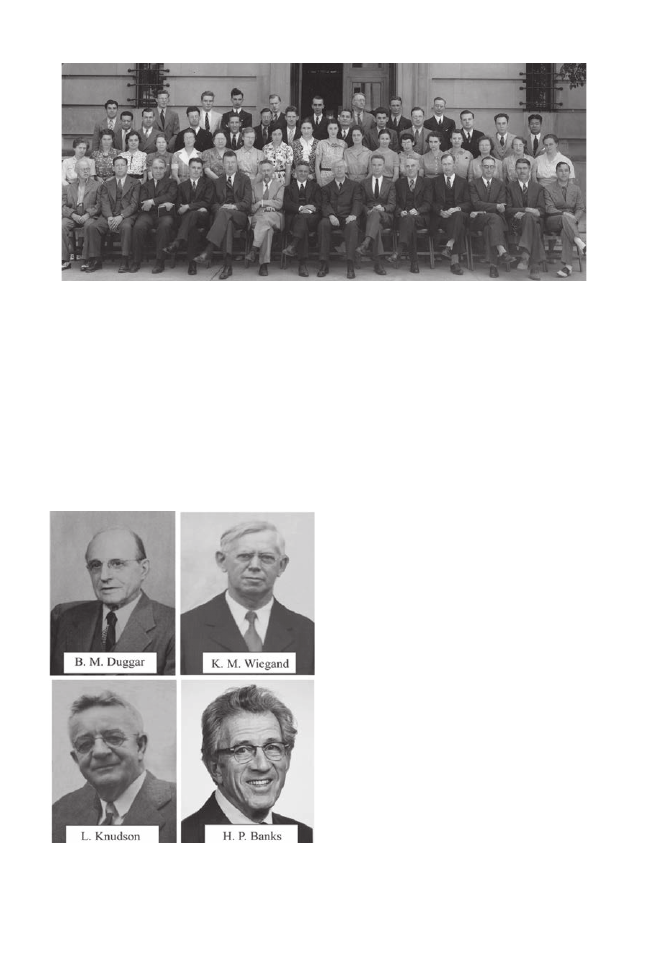
153
Plant Science Bulletin 60(3) 2014
physiology and is perhaps best remembered as
the scientist who first cloned carrots from pith
cells (thereby coining the phrase cell totipotency).
Knudson thought that Steward would eventually
become the Chair of botany but that never
happened.
Students of the late 1940’s to 1950
Sherret S. Chase (Ph.D. 1947) was a professor
at Iowa State University and at SUNY Oswego.
He also was a research geneticist and director
of International Seed Operations for DeKalb
AgResearch, Inc. Chase developed the “Double
Haploid” method of Zea mays breeding. (Ching
Hsiung) C. H. Li (Ph.D. 1948) became an
outstanding corn breeder and cytogeneticist in
China. Li was able to dramatically increase crop
yields with his varieties. Arthur Bing (Ph.D. 1949)
was a professor of Horticulture at Cornell and later
directed the Cornell University-USDA Ornamentals
Laboratory at Farmingdale, NY. Robert Folger
Thorne (Ph.D. 1949) was a taxonomist at Rancho
Santa Anna Botanic Garden and Claremont
Graduate University. His research focused on the
evolution of flowering plants. (Haruyuki) Harry
Kamemoto (Ph.D. 1950) became an important
Figure 13. Botany Department June 1, 1938, our most complete department photograph. Back row (L to
R): Milton Arnold Lessler, Gabriel Raphael Mandels, Otis Freeman Curtis, J., John Irwin Shafer, Charles
Arthur Taylor, Sidney Robinson Kennedy, Clayton I. Swayze, Robert Haydn Tschudy, Bassett Maguire. Third
row: Leon Berstein, Elmer Arthur Palmatier, Charles A. John, Harlan Parker Banks, Dwain Vorhis, Oren
Lloyd Justice, Clyde E. Harris, John T. Baldwin, Jr., George Hill Mathewson Lawrence, Robert H. Williams,
Philip Cullodin Reece, “Tom” S. Boon-Long. Second row: Ruth Alice Petry, Beradine D. Tschudy, Rosamond
Shurtleff, Carrolle E. Anderson, Mabel W. Allen, Mary A. Malone, Helvia Justice, Helen Heck, Ethel Belk,
Elizabeth C. Mosher, Fannie Rane Randolph, Lois Will, Lela Koster, Louise Raynor, Eleanor Graham Coley,
Elizabeth Richards, Doris Little, Ruth Krehl. Front row: Stewart H. Burnham, Richard August Laubengayer,
Albert LeRoy Andrews, Edward M. Palmquist, Daniel Grover Clark, Loren Clifford Petry, Lewis Knudson,
Karl McKay Wiegand, Lester Whyland Sharp, Otis Freeman Curtis, Walter Conrad Muenscher, Edwin
Fraser Hopkins, Lowell Fitz Randolph, James A. de Tomisi. (Image courtesy of the Division of Rare and
Manuscript Collections, Cornell University Library.)
Figure 14. Chairs of the Departments of Plant
Physiology and Botany (1907 – 1961): Duggar
(1907 – 1911), Wiegand (1913 – 1941), Knudson
(1941 – 1952), and Banks (1952 – 1961).

154
Plant Science Bulletin 60(3) 2014
Dendrobium orchid and Anthurium breeder at the
University of Hawaii at Manoa.
The Banks and Kent Years
1952 to 1965
During the chairmanship of H. P. Banks, several
new faculty were hired. Some left within a few years
undoubtedly because of the strong personality of
F. C. Steward, who did not mesh well with newly
hired faculty, many of whom went on to have
accomplished careers. For example, Walter D.
Bonner, Jr. came to the department in 1953. He
was an Associate Professor of plant physiology,
but left for the University of Pennsylvania in 1959.
Another plant physiologist, Conrad S. Yocum,
joined the department in 1955 and left for the
University of Michigan in 1961. Other faculty also
survived Steward’s personality. John M. Kingsbury
also joined the department as an assistant professor
in 1954, after Walter C. Muenscher had suffered a
stroke and retired. Kingsbury taught courses on the
algae and poisonous plants and went on to found
the Shoals Marine Laboratory. David W. Bierhorst
joined the department in 1955, but moved to the
University of Massachusetts in 1968 largely because
of health problems and his dislike of the newly
created Division of Biological Sciences. Loren Petry
retired on July 1, 1955 (Fig. 16).
Harlan Banks stepped down as Chair of the
department in 1961 when George C. Kent, the
Chair of Plant Pathology, assumed the role of an
acting Chair and remained so until Harry T. Stinson
became Chair of the department that subsumed the
old botany department (the Section of Genetics,
Development and Physiology). Stinson served as
Chair of the Section of Genetics, Development,
and Physiology between 1965 and 1977. With the
formation of the Division of Biological Sciences, F.
C. Steward was relocated in his own department
as director of the Laboratory of Cell Physiology,
Growth and Development. Steward moved to
Clark Hall when it opened in 1965. Much like
Steward, R. T. Clausen was also appointed as the
Director of the one-manned Wiegand Herbarium,
a position he held from 1954 until 1977.
Among the students receiving degrees (and their
advisors) during this interval are:
David E. Fairbrothers
(MS ‘52, Ph.D. ‘54)
R. T. Clausen
Charles B. Beck
(MS ‘52, Ph.D. ‘55) H. P. Banks
Wayne L. Fry
(Ph.D. ‘53)
H. P. Banks
Nancy G. Slack
(BS ‘52, MS ‘54)
H. P. Banks
Robert Rabson
(Ph.D. ‘56)
F. C. Steward
William C. Burger
(MS ‘59)
R. T. Clausen
Francis M. Hueber
(M.S. ‘59, Ph.D. ‘60) H. P. Banks
James Douglas Grierson (Ph.D. ’62)
H. P. Banks
Abraham Der Krikorian ( Ph.D. 1965)
F. C. Steward
The Division of Biological
Sciences: 1965–1979
Many changes were made with the creation
of the Division of Biological Sciences in the New
York State College of Agriculture in 1964. In 1965,
members of the botany department joined with
some members of the zoology and plant breeding
departments to become the Section of Genetics,
Development and Physiology. Professors Adrian
M. Srb, Harry T. Stinson, Jr. and Bruce Wallace
left Plant Breeding to become members of this
new section. During this time, several new faculty
were added in the area of plant physiology. André
T. Jagendorf (Cornell B.S. 1948) joined the
department in 1966. Jagendorf taught and did
research in plant physiology. Roderick K. Clayton
also joined in 1966 and taught plant physiology,
most notably courses in photosynthesis. Roger
M. Spanswick joined the department in 1967
and taught courses in plant water relations, but
transferred to Biological and Environmental
Engineering in 2001. Peter J. Davies joined the
department in 1969 and taught plant physiology.
Dominick J. Paolillo, Jr. (Cornell B.S. 1958) joined
the department in 1970 to teach plant anatomy,
morphology and development. Mandayam V.
Parthasarathy (Cornell Ph.D. 1966) joined the
department in 1971 and taught courses in electron
microscopy and plant ultrastructure.
On May 1, 1973, a symposium Historical and
Figure 15. Harlan P. Banks, Charles H. Uhl, Lewis
Knudson and Walter C. Muenscher, 1954. (Image
from the H. P. Banks Archives.)

155
Plant Science Bulletin 60(3) 2014
Current Aspects of Plant Physiology: A Symposium
Honoring F. C. Stewart was held at Cornell to
celebrate his retirement. Speakers from five
prominent universities spoke at the symposium.
The talks were published in 1975 as Historical and
Current Aspects of Plant Physiology with Peter J.
Davies as editor (Davies, 1975). Later in 1977, the
name of the section changed to Botany, Genetics
and Development, and new faculty hires followed.
The L. H. Bailey Hortorium also merged with the
Wiegand Herbarium. Neil A. Campbell came in
1977 to teach Introductory Biology. He studied
desert and coastal plants. Campbell’s textbook
Biology, first published in 1987, was used to teach
many generations of biologists world-wide. Karl
J. Niklas was hired upon the retirement of H. P.
Banks in 1978. He has taught introductory botany
and paleobotany since then.
Figure 16. Botany Group Photo taken in 404 Plant Science, May 20, 1954. Back row: L to R: Chuck Down-
ing, Robinson Abbott, Conrad Meyer, John Pollard, Sally Watkins Christie, Charles B. Beck, Ken Howe, Da-
vid E. Fairbrothers, Marvin J. Rosenberg, Dorothy Brown Beckel, Jesse F. Clovis Third row: Dorothy Niimoto,
Elfriede Philena Townley, Edgar Shantz, Ken Burlington, Harlan Q. Stevenson, Krishnaier Subramanyam,
Nancy Slack, Robert T. Clausen, Robert Rabson. Second row: Joan Smith, Janice S. Sanford, Abbe, Virginia
Rock, Ester Spielman, Dorothy Van de Mar, Ruth Petry, Thoraya Lotfy, Harlan P. Banks, Loren C. Petry,
Lewis Knudson. Front row: Jyotirmay Mitra, Kathryn Mears, Walter D. Bonner, Nathanael Grobbelaar,
William B. Drake, A. S. Rao F. Randolph, Gerald Reisner, F. C. Steward, Charles H. Uhl and Mohammed
Zahur (Absent from photo: Daniel G. Clark, James Cruise, Arthur J. Eames, Mohammed El-Ghawas, Harold
Howard, H. Lugo-Lugo, Marjorie Maguire, Walter C. Muenscher (Department photo.)
The Banks Symposium, which was held in the Fall
of 1979, brought together important paleobotanists
to honor his career as a paleobotanist. Twenty-five
authors contributed to the published two-volume
set titled Paleobotany, Paleoecology and Evolution
(Vols. I and II), edited by Karl J. Niklas, the organizer
of the symposium.
Among the students receiving degrees (and their
advisors) during these years are
Patricia Bonamo
(M.S. ’65, Ph.D. ’66)
H. P. Banks
Jack B. Fisher
(BS ’65, MS ’66)
D. W. Bierhorst
Allan Witztum
(Ph.D. ‘66)
D. W. Bierhorst
Judith E. Skog
(Ph.D. ‘72)
H. P. Banks
Laurence E. Skog
(Ph.D. ‘72)
H. E. Moore
Stephen E. Scheckler (BS ’66, MS ‘70, Ph.D. ‘73)
H. P. Banks
Lee B. Kass
(Ph.D. ‘75)
D. J. Paolillo, Jr.
Larry H. Klotz
(MS ’71, Ph.D. ‘77)
H. E. Moore

156
Plant Science Bulletin 60(3) 2014
The Section of Plant Biology
(1980-1999)
Harry Stinson, Jr. stepped down as Chair in 1980
when the former Section of Botany, Genetics and
Development separated into the Section of Genetics
and Development and the Section of Plant Biology
(Figs. 17 and 18). Mandayam Parthasarathy became
the first Chair of the new Section of Plant Biology
(1980-1983). Successive chairs included Dominick
J. Paolillo, Jr. (1983-1985) and André T. Jagendorf
(1985-1986). While Jagendorf was on sabbatical
leave from August 1986 until June 1987, Paolillo
and Parthasarathy served successively as acting
chairs. Jagendorf continued as Chair (1987-1992).
Peter J. Davies served as Chair from 1992-1996.
Paolillo once again served as chair from 1996 until
1999, when William L. Crepet became Chair of the
Department of Plant Biology. June B. Nasrallah
(Cornell Ph.D. 1977) joined the department in
1986. Nasrallah was a student of Adrian Srb. Her
main research focus is on the molecular biology of
self-incompatibility in the Brassicaceae. She was
elected to the National Academy of Science in 2003.
Mikhail E. Nasrallah (Ph.D. ‘65 in Plant Breeding)
also joined the department in 1986.
Figure 17. Chairs of botany / plant biology from 1964 until present: Stinson (1964 – 1980), Parthasarathy
(1980 – 1983), Paolillo (1983 – 1985; 1996 – 1999), Jagendorf (1985 – 1992), Davies (1992 – 1996), and
Crepet (1999 – present).
The Department of Plant Biology
(1999–2013)
In 1999, the Division of Biological Science,
which was under the direction of Peter Bruns,
was dissolved (amidst considerable controversy).
Numerous faculty meetings were held to discuss
the topic, and most of the faculty resisted the
change. Nevertheless, the final report submitted
to the President, Hunter Rawlings III, favored
the dismantling of the Division, which was
accomplished without fanfare or further discussion.
At the same time, Rawlings also mandated the
merger of the Bailey Hortorium and the Section of
Plant Biology to form the new Department of Plant
Biology. William Crepet became the first chair
of the newly created department (Cobb, 2013). A
curious twist of fate is that five departments will
soon be merged to form a School of Integrative
Plant Science with a new director and a supervisory
council. The five departments will be called
sections. Thus, 2014 will see the rebirth of a mini-
Division of Biological Sciences and a new Section
of Plant Biology.
The Cornell Agriculture and Life Sciences (CALS)
Centennial in 2004 and the BSA Centennial in 2006
got the Department of Plant Biology thinking about
its own centennial in CALS occurring in 2013. A
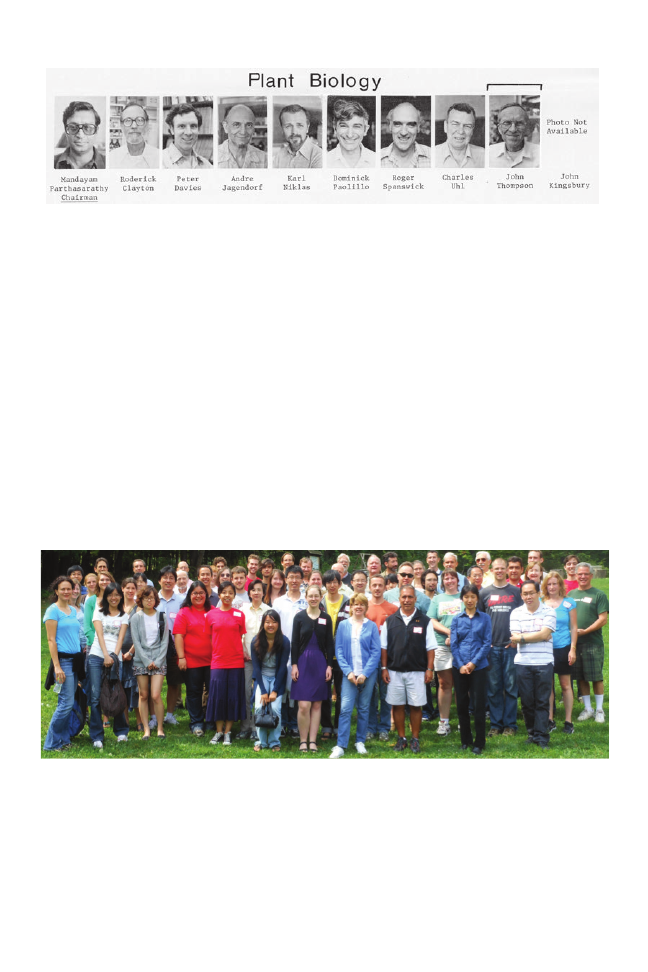
157
Plant Science Bulletin 60(3) 2014
Figure 18. Plant Biology Faculty, early 1980s. (From a CALS poster.)
plan was devised by the organizing committee
(Edward Cobb, William Crepet, Karl Niklas, and
Maria Alejandra Gandolfo Nixon) to reach out to
as many as possible of those who have made our
department what it is today. Invitations were sent in
the hopes of seeing as many alumni, faculty, friends,
and staff as possible at a two-day celebration on
June 28th and 29th, 2013. In recognition of the
Department of Botany’s 145 years of history and
service, a series of events was held that included a
keynote lecture by a former Cornell botany student
Marcus A. McFerren, Ph.D., M.D. (Friday, June
28th, 2013), titled A Journey Through Plant Biology:
Botanical Medicine & All It’s Warts, and lectures
about the department’s history that culminated in
a banquet (Saturday, June 29th, 2013). The series
of events was videotaped and is available at http://
ecommons.library.cornell.edu/handle/1813/33671.
The rest is history (Figure 19).
Acknowledgements.
The author gratefully acknowledges former
Cornell students, colleagues, and historians Robert
Dirig and Lee B. Kass (who provided the dates for
the various chairs of the department) for valuable
shared information. He also thanks Kent Loeffler
for providing and improving rare historical images;
the staff at Mann Library including Meg Ackerblade,
Liz Brown, Tom Clausen, Erin Eldermire and Judy
Wayno for their invaluable assistance; the staff at
the Kroch Rare Manuscripts Collection especially
Laura M. Linke for tracking down photos, and the
Department of Plant Biology for logistical support.
Finally, he thanks William L. Crepet, Royse P.
Murphy, and Karl J. Niklas for their encouragement.
Figure 19. Plant Biology Retreat August 2011, held at the Cayuga Nature Center, Ithaca, NY. Back Row: L
to R. Mingyue Gou, David Ruth, Wojciech Pawlowski, Ryan McQuinn, Adrian Powell, Sam Crowell, Jim
Reveal, Robert Raguso, Andy Vail, Bill Crepet, Elden Rowland, Simon Gunner. Third Row: Margaret Frank,
Baijuan Du, Andre Jagendorf, Eric Fich, Lisa Earle, Alfonso Doucette, Ed Cobb, Karl Niklas, Kevin Nixon,
Susan McCouch, Klass van Wijk, Jiping Liu, Miguel Pineros, Maureen Hanson, Randy Wayne. Second Row:
Karin Jantz, Dezi Elzinga, Laetitia Martin, Jitae Kim, Sam Lieboff, Rob Harbert, Holly Summers, Tao Sun,
Beth Takacs, Xian Qu, Zhilong Bao, Arnaud Germain, Mike Scanlon, Jennifer Svitko, Peter Lundquist,
Tracey Sherwood. Front Row: Sorina Popescu, Yann-Ru Lou, Soohyun Oh, Maria Carrizales, Gwynne Lim,
Titima Tantikanjana, Haiyi (Heidi) Wang, Adrienne Roeder, Maria Alejandra Gondolfo Nixon, Manuel
Aregullin, Jian Hua, Myat Lin. (Edward D. Cobb photo.)

158
Plant Science Bulletin 60(3) 2014
Literature cited
ANON. 1898. Botany at Cornell University, Ithaca,
N.Y. Gardening 6: 230–231.
ANON. 1899. Horticulture and Nature Study.
Cornell Alumni News. 1 (11) (June 14).
ANON. 1923. Razing of the Greenhouse at Sage
Now Finished. Cornell Daily Sun, Vol. XLIII,
issue 143, 14
th
April, 1923, page 2.
ANON. 1923. Cornell Alumni News. Vol. XXV,
No. 40, p. 506.
ANON. 1937. Fifty Years of Research at Cornell
University Agricultural Experiment Station,
1887-1937. Cornell University Agricultural
Experiment Station. Ithaca, NY.
ANON. 1987. One Hundred Years of Agricultural
Research at Cornell University: A celebration
of the Centennial of the Hatch Act, 1887-1987.
Publication of the Office for Research, College
of Agriculture and Life Sciences, Cornell
University, Ithaca, NY. Produced by Cornell
Media Services.
ATKINSON, GEORGE F. 1896. Albert Nelson
Prentiss. Botanical Gazette XXI (May): 283–289.
CLELAND, JENNIFER, and ROBERT P.
STUNDTER. 2011. Sage Hall, Experiments
in Coeducation and Preservation at Cornell
University. PhG Publishing, Ithaca, NY.
COBB, EDWARD D. 2013. 150 Years of Botany at
Cornell: A History of Botany and Plant Biology.
Cornell University, Ithaca, NY.
COLMAN, GOULD P. 1962. A History of
Agricultural Education at Cornell University.
Ph.D Thesis, Cornell University.
DORF, PHILIP. 1956. Liberty Hyde Bailey; An
informal Biography. Cornell University Press,
Ithaca, NY.
DUDLEY, WILLIAM R. 1886. The Cayuga Flora.
Part 1: A Catalogue of the Phaenogamia Growing
Without Cultivation in the Cayuga Lake Basin.
Ithaca, NY.
DUGGER, BENJAMIN M. (Editor) 1929.
Proceedings of the International Congress of
Plant Sciences, Ithaca, NY August 16–23, 1926.
George Banta Publishing Company, Menasha,
Wisconsin.
KAMMEN, CAROL, 2009. Part and Apart. Cornell
University Library, Ithaca, NY.
KASS, LEE B., and EDWARD D. COBB. 2007.
Landmarks and Milestones in American Plant
Biology: The Cornell Connection. Plant Science
Bulletin. 53 (3) (Fall): 90–101.
KAVANAGH, FREDERICK, and ANNETTE
HERVEY. 1991. William Jacob Robbins: A
Biographical Memoir. National Academy of
Sciences. Washington, DC.
KNUDSON, LEWIS 1938. A Brief History of the
Department of Botany (New York State College of
Agriculture). Division of the Rare Manuscripts
Collections (21-17-1778). Cornell University,
Ithaca, NY.
MURPHY, ROYSE P., and LEE B. KASS. 2007.
Evolution of Plant Breeding at Cornell University:
A Centennial History, 1907-2006. Cornell
University, Ithaca, NY.
PRENTISS, ALBERT N. 1890. Report of the
Botanist. Report of the Agricultural Experiment
Station, Ithaca, NY. pp. 44–53.
STEERE, WILLIAM C. (editor) 1958. Botanical
Society of America, Fifty Years of Botany;
Golden Jubilee Volume of the Botanical Society of
America. McGraw Hill, New York, NY.
THOM, CHARLES. 1956. George Francis Atkinson:
A Biographical Memoir. National Academy of
Sciences. Washington, DC.
TROY, JOHN P. 1926. Photographs of the
International Congress of Plant Scientists held
at Cornell University, Ithaca, NY.

159
Plant Science Bulletin 60(3) 2014
INTRODUCTION
Humans are completely dependent on plants
for our survival as the source of food for ourselves
or for the animals that we eat, as providers of
ecosystem services (e.g., oxygen generation, carbon
dioxide sinks, soil stabilization) and as synthesizers
of biofuels, building materials, medicines, oils,
and other natural products (Costanza et al.,
1997). Furthermore, in the current age of rapid
urbanization, biotic invasion and climate change,
basic botanical literacy is as important as ever if
the public is to recognize and cope with the real
threats to plants and plant communities that we
depend on and that define each region ecologically.
Plant blindness, the increasingly common lack of
knowledge and “seeing” of plants in everyday life is
also a powerful phenomenon that affects students
personally, as well as the focus of media, educators,
and popular culture (Wandersee & Schussler, 2001,
see also Hershey, 2002). Many people nowadays
see plants just as the green background to more
important things such as cars, buildings, golf balls,
dogs, and the erratic groundhog. This is at least
partially due to less of a personal connection with
plants (and nature) during our upbringing, and also
to the agricultural production of plants as food,
and an overwhelmingly zoo-centric media culture,
especially by producers such as Disney, Discovery
Channel, and National Geographic.
Despite the universal importance of plants
and the current need for more plant awareness,
plant science knowledge and course offerings,
especially field- and taxon-based botany, have been
reduced during the last decades at high school
and college levels (Hershey, 1996; Reinsvold,
1999). The National Science Education Standards
are also weak when it comes to plant knowledge
and understanding (Hershey, 2013). In our own
experience, few children and teenagers today can
identify more than 100 plant species, and the ones
they know are mostly supermarket or garden plants
(see also Adams et al., 2010).
At Rutgers University, we teach a combined
undergraduate and graduate level class in plant
diversity and evolution and advanced plant
systematics, which includes lectures, labs and
written and practical assignments. In the labs,
we bring in over 1000 species or cultivars of
representative plants, highlighting plants of
ethnobotanical use, including landscaping,
agriculture, food and spices. To increase student
knowledge of plants in the local ecosystems, we
The Making of a Student-Driven
Online Campus Flora:
an example from Rutgers University
Lena Struwe
1,4
, Lauren S. Poster
1,2
, Natalie
Howe
1,2
, Christopher B. Zambell
1,2
,
and Patrick W. Sweeney
3
DOI: 10.3732/psb.1400008
Submitted 6 November 2013
Accepted 25 May 2014
ABSTRACT
Student participation in floristics at the university
level is essential for the longevity and expansion of
botany, plant ecology, and their many associated
fields, but knowledge and college course options
have been decreasing. In many cases students are
unaware of the botanical biodiversity that is right
in front of their eyes. We started a project called
Flora of Rutgers Campus (FoRC), which provides
students with hands-on outdoor fieldwork as an
engaging and effective way to experience botany
first hand. In 2011, 32 students participated in this
project and uploaded 580 vouchered observations
to a database. In total, we found 98 families, 200
genera, and 259 species on the Cook/Douglass
campus of Rutgers University in New Jersey. Nearly
10% of the state’s flora was found on 317 urban/
suburban acres. This project strongly increased the
students’ knowledge of local plants, opened their
eyes to “see” plants everywhere, and encouraged
students to work cooperatively.
Key words: botany; biodiversity; campus;
education; plant blindness; plant systematics
1 Department of Ecology, Evolution & Natural Resources,
Rutgers University, 14 College Farm Road, New
Brunswick, NJ 08901
2 Graduate Program in Ecology & Evolution, Rutgers
University, 14 College Farm Road, New Brunswick,
NJ 08901
3 Yale University, Peabody Museum of Natural History,
PO Box 208118, New Haven, CT 06520
4 Email: struwe@aesop.rutgers.edu

160
Plant Science Bulletin 60(3) 2014
developed the project Flora of Rutgers Campus in
2011, which aims to provide students with a variety
of skills.
Field-based botanical inventories strengthen
skills in morphology, identification, vouchering
and other biodocumentation, family recognition,
georeferencing, and description. Any teaching that
focuses on local and personally relevant issues and
brings with it a “sense of place” for students has a
higher chance of being found important to students
(Gruenewald, 2003; Semken & Butler Freeman,
2008; Kudryavtsev et al. 2012). The project provided
students with a focused, but open-ended research
question, a positive challenge, and a valuable
goal—the first floristic biodiversity inventory of
any Rutgers campus in the history of our university.
Rutgers, The State University of New Jersey
(aka “Rutgers University”) is located in three
locations in New Jersey (Camden, Newark, and
New Brunswick). Our project took place in the
New Brunswick location, which is the largest part
of the university. Of five Rutgers campuses located
within the New Brunswick area, the campus flora
project included two of them: the George H.
Cook Campus, which is the old agricultural land
grant school, and the adjoining Rutgers’ Douglass
Campus, the former New Jersey College for
Women. The Cook/Douglass campuses are located
at approximately 40.48 N, 74.43 W on the east coast
of the United States, in central New Jersey, and the
local environment is influenced by the tidal Raritan
River (Ashley & Renwick, 1983). New Brunswick
is 8.5 miles (13.7 km) away from the Raritan Bay
of the Atlantic Ocean and the distance to the outer
coastline at Sandy Hook is 24 miles (38.6 km).
Our area of inventory covered 317 acres (1.3
km
2
), which included an abundance of maintained
lawns, a remnant of an old growth hardwood
forest (Frank G. Helyar Woods), ditches, wetlands
(natural and artificial), and retention basins, a
few small ponds (including Passion Puddle), one
dammed lake (Weston Mill Pond), asphalted roads
and parking lots, horse and cow fields, a pig, goat
and sheep farm, a horticultural garden (Rutgers
Garden), a research farm, an organic community
garden, abandoned lots and fields, rocky cliffs, and
several intensively used highways (Route 18 and US
Route 1).
METHODS
During the fall of 2011, we challenged 32 graduate
and undergraduate students to create a campus-
wide floristic survey of all wild and naturalized
plant species on Cook/Douglass campuses (317
acres, Rutgers University, NJ, USA). Students used
both traditional tools (floras, hand lenses, knives,
bags, herbarium presses, dissecting microscopes,
and rubber boots) and high-tech equipment (smart
phones with instant GPS, cameras, and internet
identification resources). All newly found species
had to be vouchered with herbarium specimens,
and all observations had to have a photo of the
plant either in the field or after being pressed (or
both).
Identification was accomplished by keying
out plants using floras or online-keys, or with
comparison with other herbarium materials
available at Chrysler Herbarium (CHRB, at
Rutgers University). To help with the project, we
provided manuals on (1) how to press plants, (2)
georeferencing, (3) using Google Maps to find
coordinates, and (4) how to identify the 50 most
common plant families of temperate regions.
All herbarium vouchers were photographed and
included in the online database. Afterwards they
could be donated to the CHRB at Rutgers University
if the student so wished.
The observation data were uploaded by students
to an online web portal housed by Consortium of
Northeastern Herbaria (http://neherbaria.org/), a
Symbiota Software Project portal (http://symbiota.
org/tiki/tiki-index.php). Taxonomy for vascular
plants follows the one used in the USDA-PLANTS
database, which is the taxonomy utilized in the
CNH portal. Classification for lichens followed
Esslinger (2011).
The students’ resulting herbarium specimens,
field observations, and photos formed a Flora of
Rutgers Campus species list, image bank, and maps
of species locations now publicly available online
(http://portal.neherbaria.org/portal/checklists/
checklist.php?cl=28). Included in the inventory
were all vascular plants (flowering plants, conifers,
ferns and fern allies, and lycopods), as well as
lichens, mosses, liverworts, and algae. Generally
specimens representing plants grown in cultivation
were not included in the inventory.
Cultivated native plants were included, but
plants that were non-native or unlikely in their
natural range were only included if they appeared

161
Plant Science Bulletin 60(3) 2014
RESULTS
The project started in late September 2011 and
ran until mid-December 2011, three months total,
and over that time period, 580 observations of 259
species were uploaded by 32 students. (Twenty-
eight observations were plants that students had
collected in July and August, before the start of the
class.)
Right before our project started, our campus was
hit by Hurricane Irene, which led to massive tree
destruction in our area, which made epiphytes more
accessible, but otherwise appeared not to affect our
floristic work. However, in late October, the project
was interrupted by an unusually early snowstorm
that covered all vegetation in deep, wet snow for a
few days. Some herbaceous plants recovered from
this, others did not. Most of the plant observations
(400) were recorded in September and October,
before the storm.
The inventory resulted in us finding 259 species
in 200 genera, distributed among 98 families
(Figures 2 and 3). Compared with the reported
species from Middlesex County, NJ on the USDA-
PLANTS database, our findings represent 19% of
the vascular plant species found in our county,
35% of the vascular plant genera, and 64% of the
vascular plant families. Compared with the total
number of land plant species reported from New
Jersey (3207 species) in the USDA-PLANTS database,
we found 8%.
to be escaped and/or naturalized to uncultivated
areas of campus.
In order to identify their specimens, students had
access to a variety of taxonomic keys, and they often
collaborated when keying out difficult specimens.
Students also had access to botanists who could
verify their tentative identifications: the Professor
(LS) and Teaching Assistant (CZ) for vascular
plants, Bill Buck of The New York Botanical Garden
for mosses and liverworts, and Richard Harris of
The New York Botanical Garden for lichens. Many
identifications were incorrect at first, and this input
and subsequent feedback was important for quality
control of the database. Most students relied on
keys in Rhoads and Block’s (2007) The Plants of
Pennsylvania and Haines’ (2011) Flora Novae-
Angliae. Gleason and Cronquist’s (1991) Manual of
the Vascular Plants of the Northeastern United States
and Adjacent Canada was also available, although
students then had to compare the nomenclature
to the USDA-PLANTS Database to ensure that
names were current. For difficult groups, students
used Barkworth et al.’s (2007) Manual of Grasses for
North America, Brodo et al.’s (2001) Lichens of North
America, Hinds and Hinds’ (2007) Macrolichens of
New England, Lincoln’s (2008) Liverworts of New
England, and Crum and Anderson’s (1981) Mosses
of Eastern North America.
To provide additional incentives to students we
set up a system of gaining points according to the
following schedule: 10 points for finding a new
family, 5 points for finding a new genus, 5 points for
finding a new species, and 1 point per observation
overall. Ten observations were mandatory for each
student. We recruited donations of prizes (books,
botanical items, living plants, garden clippers, etc.)
from faculty, deans, and department chairs.
At the end of the project, we arranged for a
special celebration and the students got to select
among the prizes in order of the number of points
they had achieved. We also got the chair of the
Department of Ecology, Evolution and Natural
Resources to promise a pizza party for the whole
class at the end of the project, if the class managed
to find over 250 species on our campus.
As a separate small project, we ran a logo design
competition, where the students provided brand-
new logos which were then voted on by the students
(Figure 1). This was an optional assignment and
brought out some of the design and art skills in
some students.
Figure 1. Logo for Flora of Rutgers Campus, devel-
oped and designed by Clayton Leadbetter, winner in
the logo design competition.
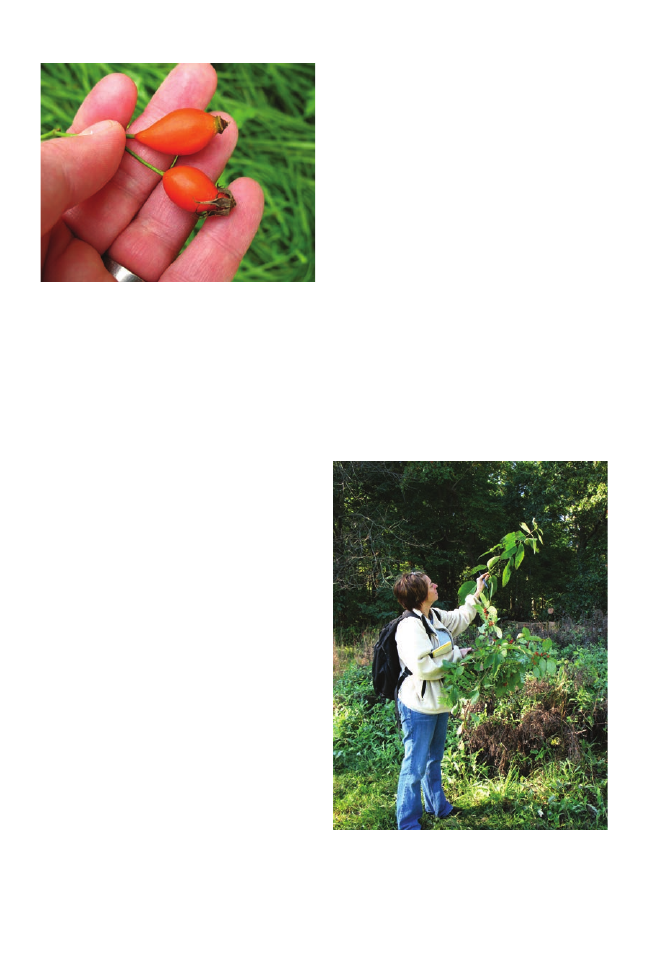
162
Plant Science Bulletin 60(3) 2014
that were most frequently misidentified were
Cyperus (9 collections), Persicaria (4), Plantago (3),
Setaria (2), Digitaria (2), and Solidago (2), which
are groups known for being challenging to identify.
The Cyperus specimens were so difficult to identify
using the literature that the CHRB Collections
Manager had to pull reference materials from the
main collection for comparison before the teaching
assistant was sure about the species identification.
Only four collections were misidentified at the
generic level and those were in the Asteraceae.
The students had access to expert help and floristic
literature during all weeks before hand-in of the
herbarium collections, and identification was
practiced frequently during the indoor regular
labs. It should be noted that most students in the
class had never keyed out a plant before this class.
The student that specialized in mosses and lichens
(NH) estimated that her initial identifications were
about 40% wrong for lichens and 75% for mosses,
when she first started to look at these groups for
the project, but then she went to The New York
Botanical Garden and was taught there how to
identify these correctly.
Of the 580 observations, the most commonly
reported species was Trifolium repens (white clover,
Fabaceae), which was reported 15 times. The most
species-rich family for this late fall time period
was unsurprisingly Asteraceae, which included 27
species on campus (10.5% of all species reported).
The genus with the most species was Polygonum
(Polygonaceae), with nine different species.
Approximately half of the reported vascular plant
species can be considered weedy species (listed in
floristic works on weeds and/or invasive species),
either native or non-native. Thirteen of the species
found are classified by the USDA as invasive plants
in the Northeast.
Although students are often loosely familiar
with tree groups, most of the observations of the
plants were of forbs (356, 61% of all observations).
Students also made many observations of trees,
shrubs and vines (129, or 23%). Other groups
were less well represented in the collections: 49
observations (8%) were grasses, sedges, or rushes,
24 (4%) were mosses, 15 (2%) were lichens, 4 (1%)
were ferns, and one was a liverwort.
As part of the class the students had to hand in
10 pressed herbarium collections from 10 different
plant families, and included in these were vouchers
for any new species found during the Flora of
Rutgers Campus project. Of the total of 310
collections that were handed in (by 31 students),
only 33 (11%) collections were incorrectly
identified or were lacking critical material that
made species identification possible. The genera
Figure 2. Example of a species found on Rutgers
University’s Cook Campus: rosehips from Rosa
canina (Rosaceae), easily identified based on its leaf
and fruit characteristics. Photo by Lena Struwe.
Figure 3. Graduate student April Jackson collecting
species of Asclepias (milkweed, Apocynaceae) and
Lonicera (honeysuckle, Caprifoliaceae) behind the
old dairy barn on Cook Campus at Rutgers Univer-
sity. Photo by Lena Struwe.

163
Plant Science Bulletin 60(3) 2014
A large majority of students were strongly
engaged in the project and spent a large amount
of time outside of regular class collecting and
determining plants, and then uploading specimen
data. We estimate that the time spent outside of the
classroom for this project amounts to an average of
6-8 hours per student, with some students exceeding
this average by far. The most active student (NH)
put in over 60 hours outside the classroom.
The students visited many different parts of
campus for the project. As expected, most of the
observations were recorded close to the lab building
(Foran Hall). The distance to Helyar Woods is 0.9
miles (1.6 miles following roads) and predictably
most students did not visit this area but stayed closer
to home. The types of habitats in which students
recorded observations included: mixed hardwood
forests and patchy wood lots (21% of observations);
campus lawns and landscaped areas (20%); weedy
parking lots, roadsides, and sidewalks (15%); pond
edges and stream banks (7%); garden plots and
agricultural areas (7%); abandoned meadows and
fields (6%); and aquatic habitats (2%). Twenty two
percent of observations did not include adequate
habitat information to classify their habitat type.
Twenty-two of the students (69%) submitted
more than the 10 required observations. Only
the professor (LS) got poison ivy dermatitis and
the project as a whole provided a great learning
experience to the students of the class.
Critical non-plant related skills learned during
this class included species collection techniques,
photography and resizing of digital images, and the
basics of georeferencing and GPS use, including
understanding latitude and longitude data and
uncertainty in GPS coordinates. All students in
the class quickly learned that the longitude of New
Jersey needs to be negative, or their specimens
would end up in Kazakhstan on the Google Map in
the flora list portal (Figure 4).
At the end of the class when the points were
tallied up, it was clear that the winner was the
student that had largely focused on bryophytes
and lichens (i.e., Natalie Howe, co-author on this
paper). Her work lead to a large swath of new
families and genera and a large lead compared to
other students working mostly with vascular plants.
She ended as the winner with 809 points total,
based on 59 uploaded observations, and won the
three subcategories of most new families, genera,
and species reported. The runner-up (Clayton
Leadbetter) reported the most species and most
genera within vascular plants, accumulating 499
points, based on 54 observations. He also won the
category of ‘fastest point gain’ when he went from
to 0 to 315 points in 10 days half-way through the
semester.
BROADER IMPACTS AND
CONCLUSIONS
Our learning goals for this project were
accomplished by most of our students, and are
listed here:
• strongly increase knowledge of and
interest in local plants
• gain essential botanical skills in field
identification, inventorying, and data management
• gain critical spatial skills in georeferencing
and GPS use
• heighten appreciation and understanding
of the biodiversity of semi-natural and urban
landscapes
• increase ability to ‘see’ plants everywhere,
especially in human-influenced habitats
• work cooperatively even when competing
In addition to these personal goals for individual
students, this project provided the start of a long-
term dataset that can be used both as an educational
tool in future classes, as well as for ecological and
biodiversity research on campus. It is the first
floristic biodiversity inventory of any Rutgers
campus, at a university that is nearly 250 years old,
and is the beginning of building a database of the
flora and its ecology and biodiversity to be used in
future classes and research.
A project of this kind is a perfect example of how
a college campus can become a living laboratory,
field station, and specimen exhibit, right outside
the classroom doors. The fact that students were
able to record 110 observations of wild plants
on the lawns and landscaped areas of campus,
suggests that most college campuses will harbor
unanticipated plant diversity, even if they aren’t
associated with old growth forests or wetland areas.
Additionally, the fact that 121 of the observations
were in wooded areas, and over half of those (66)
were in the old growth forest area far from the
main campus, suggests that projects of this type
encourage students to spend time in natural areas
that they might not have otherwise visited. After
the class was over in 2011, it was clear that most
students loved finding new species and exploring
the botanical diversity outside the classroom.

164
Plant Science Bulletin 60(3) 2014
This project strongly increased the students’
knowledge of local plants, heightened their
appreciation of the natural or human-disturbed
world and their university campus, opened their
eyes to ‘see’ plants everywhere, and encouraged
students to work cooperatively.
Another feature of our findings is that it is
ultimately important to make the plant groups
accessible to students by providing accurate and
straightforward keys and to have access to experts
to verify tentative identifications. Particularly
in the moss group, most of the original student
identifications were incorrect even after using the
dichotomous key, so having a verification step was
key to maintaining an accurate and useful database.
At the time of the submission of this article
(Fall 2013), we are running the Flora of Rutgers
Campus project with 34 new students and the
same incentives and learning goals. We have also
expanded the flora area to all five campuses in New
Brunswick, New Jersey, so we have increased the
habitat diversity as well as area size significantly.
The students are building on the database we started
in 2011, and we expect to find new species, new
populations, and new campus areas that show high
levels of biodiversity this year. We are also letting
students develop small field identification guides
to difficult groups or genera, which will build up a
library of online tools for local plant identification.
ACKNOWLEDGMENTS
This project would not have been possible
without the Consortium of Northeastern Herbaria
and the implementation of the Symbiota software
framework (developed by Ed Gilbert) on their
website. The School of Environmental and Biological
Sciences at Rutgers University provided funding for
the Chrysler Herbarium, and the Departments of
Ecology, Evolution and Natural Resources as well
as Plant Biology and Pathology provided funding
for the class and this particular project. We also
thank the following sponsors of student prizes
for the Flora of Rutgers Campus project: Rutgers
University School of Environmental and Biological
Sciences, New Jersey Agricultural Experiment
Station, Chrysler Herbarium, Mark Vodak, Steven
Handel, Jason Grabosky, and Henry John-Alder in
the Department of Ecology, Evolution, & Natural
Figure 4. Map view in Google map of all collections and observations uploaded to the Flora
of Rutgers Campus project. The map is centered over New Brunswick, NJ, and Raritan River
crosses the map from northwest to east. Interstate 95 (aka NJ turnpike) is the highway a few
miles to the east side of Cook/Douglass Campus.

165
Plant Science Bulletin 60(3) 2014
Resources, Joan Bennett in the Department of
Plant Biology and Pathology, Nicoletta Graf at
the Floriculture Greenhouse, Bruce Crawford at
Rutgers Gardens, Consortium of Northeastern
Herbaria, Executive Dean Bob Goodman, Mike
Green in the Media and Marketing Office, Jean
Marie Hartman in the Landscape Architecture
department; and Richard Harris, James Lendemer,
and Bill Buck at the New York Botanical Garden
for taxonomic expertise in mosses and lichens. The
FoRC logo was designed by Clayton Leadbetter.
This project was supported by the New Jersey
Agricultural Experiment Station and by the USDA-
National Institute for Food and Agriculture, Hatch
project number NJ17610 to LS. The co-authors
on this paper consist of the professor leading the
project and class (LS), the 2011 Teaching Assistant
(CZ), the winner of the 2011 student competition
and the 2013 Teaching Assistant (NH), CHRB
Collections Manager and also student in the
2011 class (LSP), and the Administrator of the
Consortium of Northeast Herbaria’s Symbiota
website and collaborator at Yale University (PS).
REFERENCES
Adams, C.R., M.E. Kane, J.G. Norcini, G. Acomb,
and C. Larsen. 2010. Awareness of and Interest
in Native Wildflowers among College Students
in Plant-related Disciplines: A Case Study from
Florida. HortTechnology 20:368–376.
Allen, W. 2003. Plant Blindness. BioScience 53: 926.
Ashley, G. M., and Renwick, W. H. 1983. Channel
Morphology and Processes at the Riverine-
Transition, the Raritan River, New Jersey, in
Modern and Ancient Fluvial Systems (eds J. D.
Collinson and J. Lewin). Blackwell Publishing
Ltd., Oxford, UK.
Barkworth, M.E., L.K. Anderton, K.M. Capels,
S. Long, and M.B. Piep, eds. 2007. Manual of
grasses for North America. University Press of
Colorado, Boulder, CO.
Brodo, I.M., S.D. Sharnoff, & S. Sharnoff. 2001.
Lichens of North America. Yale University
Press, New Haven, CT.
Costanza, R., R. D’Arge, R. de Groot, S. Farber,
and M. Grasso. 1997. The value of the world’s
ecosystem services and natural capital. Nature
387: 253-260.
Crum, H.A., and L.E. Anderson. 1981. Mosses of
eastern North America, vols. 1 & 2. Columbia
University Press, New York, NY. 1328 pp.
Esslinger, T.L. 2011. A cumulative checklist for the
lichen-forming, lichenicolous and allied fungi
of the continental United States and Canada,
ver. 17 (16 May 2011). North Dakota State
University, Fargo, ND. (accessed September 15,
2011) http://www.ndsu.edu/pubweb/~esslinge/
chcklst/chcklst7.htm
Gleason, H.A., and A. Cronquist.1991. Manual of
the Vascular Plants of the Northeastern US and
Adjacent Canada. New York Botanical Garden
Press, New York, NY.
Gruenewald, D. A. 2003. Foundations of Place:
A Multidisciplinary Framework for Place-
Conscious Education. American Educational
Research Journal 40: 619-654.
Haines, A. 2011. New England Wild Flower
Society’s Flora Novae Angliae: A Manual for
the Identification of Native and Naturalized
Higher Vascular Plants of New England. Yale
University Press. 1008 pp.
Hershey, D.R. 1996. Historical perspective on
problems in botany teaching. The American
Biology Teacher 58(6): 340-347.
Hershey, D.R. 2002. Plant Blindness: “We have Met
the Enemy and He is Us.” Plant Science Bulletin
48: 78-85.
Hershey, D.R. 2013. Plant Content in the National
Science Education Standards. Available at:
http://www.actionbioscience.org/education/
hershey2.html?print. (Accessed October 1,
2013)
Hinds, J. W., and P. L. Hinds. 2007. Macrolichens
of New England. Memoirs of The New York
Botanical Garden 96. The New York Botanical
Garden Press. 608 pp.
Kudryavtsev, A., M. E. Krasny, and R. C. Stedman.
2012. The impact of environmental education
on sense of place among urban youth. Ecosphere
3(4): 29.
Lincoln, M.S.G. 2008. Liverworts of New England:
A Guide for the Amateur Naturalist. New York
Botanical Garden Press, New York, NY.
Reinsvold, R. 1999. Why Study Plants? Why Not?
Science Activities 36: 3-5.
Rhoads, A.F., and T.A. Block. 2007. The plants of
Pennsylvania, an illustrated manual, 2
nd
ed.
University of Pennsylvania Press, Philadelphia,
PA.

166
Plant Science Bulletin 60(3) 2014
Semken, S., and C. Butler Freeman. 2008. Sense
of Place in the Practiced Assessment of Place-
Based Science Teaching. Scientific Education
92: 1042-1057.
USDA-PLANTS database. http://plants.usda.gov/
java/. (Accessed April 15, 2014)
Wandersee, J.H., and E.E. Schussler. 2001. Toward
a Theory of Plant Blindness. Plant Science
Bulletin 47: 2-9.
Appendix 1.
Species list from Flora of Rutgers Campus project
as of December 2011. These species were all found
in the field by students in the Plant Systematics
class. A total of 259 species in 200 genera and 98
families were found, and non-seed plant groups are
indicated in parentheses after family names below.
ADOXACEAE
Viburnum acerifolium
Viburnum dentatum
ALTINGIACEAE
Liquidambar styraciflua
AMARANTHACEAE s.str.
Amaranthus hybridus
Amaranthus retroflexus
AMARYLLIDACEAE s.lat. (ALLIACEAE s.str.)
Allium oleraceum
Allium schoenoprasum
AMBLYSTEGIACEAE (MOSSES)
Leptodictyum riparium
ANACARDIACEAE
Rhus aromatica
Rhus typhina
Toxicodendron radicans
ANNONACEAE
Asimina triloba
ANOMODONTACEAE (MOSSES)
Anomodon attenuatus
Anomodon rostratus
APIACEAE
Daucus carota
AQUIFOLIACEAE
Ilex laevigata
Ilex opaca
Ilex verticillata
ARACEAE
Arisaema triphyllum
Lemna minor
Peltandra virginica
Symplocarpus foetidus
ARALIACEAE
Hedera helix
ASCOMYCOTA (LICHENS)
Amandinea polyspora
Candelaria concolor
Cladonia chlorophaea
Cladonia coniocraea
Cladonia cristatella
Flavoparmelia caperata
Lecanora strobilina
Parmelia sulcata
Parmotrema perforatum
Peltigera didactyla
Physcia millegrana
Punctelia caseana
Pyrrhospora varians
ASPARAGACEAE
Maianthemum racemosum
ASPLENIACEAE (FERNS)
Asplenium platyneuron
ASTERACEAE
Achillea millefolium
Ageratina altissima
Ambrosia artemisiifolia
Anthemis arvensis
Arctium minus
Artemisia ludoviciana
Bidens bipinnata
Bidens frondosa
Cichorium intybus
Cirsium vulgare
Conyza canadensis
Erechtites hieracifolia
Erigeron annuus
Eupatorium dubium
Eupatorium serotinum
Eurybia divaricata
Euthamia graminifolia

167
Plant Science Bulletin 60(3) 2014
Galinsoga quadriradiata
Helianthus annuus
Hieracium flagellare
Matricaria discoidea
Mikania scandens
Senecio vulgaris
Solidago canadensis
Solidago gigantea
Solidago rugosa
Taraxacum officinale
BALSAMINACEAE
Impatiens capensis
BERBERIDACEAE
Berberis thunbergii
BETULACEAE
Alnus serrulata
Betula alleghaniensis
Betula nigra
Carpinus caroliniana
Ostrya virginiana
BIGNONIACEAE
Catalpa speciosa
BRACHYTHECIACEAE
(MOSSES)
Brachythecium plumosum
Brachythecium populeum
BRASSICACEAE
Alliaria petiolata
Capsella bursa-pastoris
Cardamine hirsuta
Lepidium virginicum
Sinapis arvensis
Sisymbrium officinale
BRYACEAE (MOSSES)
Bryum capillare
Bryum pseudotriquetrum
CABOMBACEAE
Cabomba caroliniana
CALYCANTHACEAE
Calycanthus floridus
CAMPANULACEAE
Lobelia inflata
CANNABACEAE
Celtis occidentalis
Humulus japonicus
CAPRIFOLIACEAE
Lonicera japonica
Lonicera maackii
CARYOPHYLLACEAE
Cerastium pumilum
Silene latifolia
Spergularia rubra
Stellaria media
CELASTRACEAE
Celastrus orbiculatus
Euonymus alatus
CEPHALOZIACEAE
(MOSSES)
Cephalozia lunulifolia
CERATOPHYLLACEAE
Ceratophyllum demersum
CHENOPODIACEAE
(AMARANTHACEAE s. lat.)
Chenopodium album
CLETHRACEAE
Clethra alnifolia
COMMELINACEAE
Commelina communis
CONVOLVULACEAE
Ipomoea hederacea
Ipomoea purpurea
CORNACEAE
Cornus amomum
Cornus florida
CUCURBITACEAE
Cucumis anguria
Sicyos angulatus
CUPRESSACEAE
(CONIFERS)
Juniperus virginiana
CYPERACEAE
Cyperus esculentus
Cyperus microiria
Cyperus strigosus
Scirpus cyperinus
DENNSTAEDTIACEAE
(FERNS)
Dennstaedtia punctilobula
DICRANACEAE (MOSSES)
Dicranella heteromalla
Thuidium delicatulum
DITRICHACEAE (MOSSES)
Ceratodon purpureus
DRYOPTERIDACEAE
(FERNS)
Dryopteris marginalis
EBENACEAE
Diospyros virginiana
ENTODONTACEAE
(MOSSES)
Entodon seductrix
ERICACEAE
Vaccinium pallidum
EUPHORBIACEAE
Acalypha rhomboidea
Acalypha virginica
Euphorbia maculata
Euphorbia vermiculata
FABACEAE
Cercis canadensis
Gymnocladus dioicus
Medicago lupulina
Medicago sativa
Robinia pseudoacacia
Trifolium campestre
Trifolium pratense
Trifolium repens
FAGACEAE
Fagus grandifolia
Quercus alba
Quercus palustris
Quercus rubra

168
Plant Science Bulletin 60(3) 2014
GEOCALYCACEAE
(LIVERWORTS)
Lophocolea minor
GERANIACEAE
Geranium carolinianum
HAMAMELIDACEAE
Hamamelis virginiana
HEDWIGIACEAE (MOSSES)
Hedwigia ciliata
HYPNACEAE (MOSSES)
Hypnum imponens
Platygyrium repens
Pseudotaxiphyllum elegans
IRIDACEAE
Iris versicolor
JUBULACEAE
(LIVERWORTS)
Frullania eboracensis
JUGLANDACEAE
Carya glabra
Carya ovata
Juglans nigra
JUNCACEAE
Juncus tenuis
LAMIACEAE
Collinsonia canadensis
Glechoma hederacea
Lamium amplexicaule
Lamium purpureum
Lycopus sp.
Prunella vulgaris
LAURACEAE
Lindera benzoin
Sassafras albidum
LESKEACEAE (MOSSES)
Leskea gracilescens
MAGNOLIACEAE
Liriodendron tulipifera
Magnolia tripetala
MALVACEAE
Abutilon theophrasti
Althaea officinalis
Hibiscus trionum
Malva neglecta
MNIACEAE (MOSSES)
Plagiomnium cuspidatum
MOLLUGINACEAE
Mollugo verticillata
MORACEAE
Ficus carica
Maclura pomifera
Morus alba
MYRICACEAE
Morella pensylvanica
NYMPHAEACEAE
Nymphaea odorata
OLEACEAE
Fraxinus americana
Fraxinus pennsylvanica
Ligustrum vulgare
ONAGRACEAE
Ludwigia palustris
OROBANCHACEAE
Epifagus virginiana
OXALIDACEAE
Oxalis stricta
PAULOWNIACEAE
Paulownia tomentosa
PHRYMACEAE
Mazus pumilus
PHYTOLACCACEAE
Phytolacca americana
PINACEAE (CONIFERS)
Pinus strobus
PLANTAGINACEAE
Callitriche heterophylla
Chelone glabra
Linaria vulgaris
Plantago lanceolata
Plantago major
Plantago rugelii
PLATANACEAE
Platanus occidentalis
POACEAE
Digitaria ciliaris
Digitaria ischaemum
Digitaria sanuinalis
Echinochloa muricata
Leersia oryzoides
Panicum virgatum
Phragmites australis
Poa autumnalis
Setaria faberi
Setaria glauca
Setaria pumila
Setaria viridis
Tridens flavus
POLYGONACEAE
Fallopia japonica
Persicaria longiseta
Polygonum arenastrum
Polygonum aviculare
Polygonum cespitosum
Polygonum cespitosum var.
longisetum
Polygonum cespitosum var.
cespitosum
Polygonum lapathifolium
Polygonum pensylvanicum
Polygonum perfoliatum
Polygonum persicaria
Rumex obtusifolius
POLYTRICHACEAE
(MOSSES)
Atrichum angustatum
Pogonatum pensilvanicum
Polytrichum commune
PONTEDERIACEAE
Heteranthera reniformis
Pontederia cordata
PORTULACACEAE
Portulaca oleracea

169
Plant Science Bulletin 60(3) 2014
PRIMULACEAE
Anagallis arvensis
Lysimachia quadrifolia
RANUNCULACEAE
Ranunculus hispidus
ROSACEAE
Duchesnea indica
Photinia pyrifolia
Prunus serotina
Pyrus calleryana
Rhodotypos scandens
Rosa canina
Rosa multiflora
Rubus pensilvanicus
Rubus phoenicolasius
RUBIACEAE
Cephalanthus occidentalis
Galium mollugo
SAPINDACEAE
Acer negundo
Acer nigrum
Acer platanoides
Acer saccharinum
Acer saccharum
Aesculus glabra
SCROPHULARIACEAE
Verbascum thapsus
SIMAROUBACEAE
Ailanthus altissima
SMILACACEAE
Smilax rotundifolia
SOLANACEAE
Datura stramonium
Physalis philadelphica
Solanum carolinense
Solanum dulcamara
Solanum ptycanthum
TYPHACEAE
Typha latifolia
URTICACEAE
Boehmeria cylindrica
Pilea pumila
VIOLACEAE
Viola blanda
Viola cucullata
Viola sororia
VITACEAE
Ampelopsis brevipedunculata
Vitis vulpina
WOODSIACEAE (FERNS)
Athyrium filix-femina
Cystopteris tenuis

170
Book Reviews
Economic Botany
The Genus Tulipa, Tulips of the World ..........................................................................170
Sustainable Landscaping: Principles and Practices ........................................................172
New Lives for Ancient and Extinct Crops ......................................................................173
Systematics
Conifers around the World: Conifers of the Temperate Zones and Adjacent Regions,
Vols. 1-2 ..................................................................................................................174
Genera Palmarum: The Evolution and Classification of Palms .....................................176
A Guide to Orchids of Myanmar ....................................................................................177
Land of Enchantment Wildflowers: A Guide to the Plants of New Mexico ...................178
Red List of the Endemic Plants of the Caucasus: Armenia, Azerbaijan, Georgia, Iran,
Russia, and Turkey. .................................................................................................179
The Genus Tulipa: Tulips of the
World
Diana Everett
2013. ISBN-13: 978-1-84246-481-6
Cloth, US$112.00. 380 pp.
Kew Publishing, Royal Botanic Gardens,
Kew, Richmond, United Kingdom
Artist Diana Everett has assembled an annotated
compendium of tulips by way of a travelogue,
commencing with her paintings of tulips from her
time as a student at the Chelsea Physic Garden, and
expanded through her travels to diverse regions
where tulips occur in the wild. She enriched
her collection of drawings and photographs
with information about synonymy, description,
distribution, flowering, and in some cases
chromosome number. Everett’s explanatory text is
expanded with chapters about current molecular
phylogenetics and classification of Tulipa by Kew
botanists Michael Fay and Maarten Christenhusz,
and about tulip cultivation by Richard Wilford.
Each species is illustrated with the author’s
botanical paintings and a color photograph of the
plants in habitat. There are several appendices,
preceded by a two-page glossary and a four-
page bibliography, which represents only a slight
measure of the vast literature about Tulipa.
Appendix 1 is an alphabetical checklist of the genus
including synonyms, Appendix 2 gives a summary
of Zonneveld’s 2009 sectional classification of the
Economic Botany
genus, Appendix 3 is a list of nurseries stocking
tulips, and Appendix 4 provides biographical notes
on select “prominent Tulipa authors, collectors and
growers”; these are followed by an index to species
names. The taxonomic treatment of accepted species
(Christenhusz et al., 2013) follows the arrangement
of the species into subgenera defined by Veldkamp
and Zonneveld (2012). For a user, however, finding
a given species is somewhat inconvenient because
tulip species names are not arranged alphabetically
throughout; yet this volume’s arrangement is
somewhat artificial because, as the author herself
points out [p. 1], there have been many revisions of
tulip nomenclature and classification; new studies
generate varying opinions with regard to subgenera
(e.g., Eker et al., 2014).
The chance choice of tulips as the subject of
the painting portfolio for Everett’s diploma
subsequently led her to hunt tulips in the mountains
and steppes of Central Asia: Afghanistan, Armenia,
Azerbaijan, Iran, Kazakhstan, Kyrgyzstan,
Tajikistan, Turkey, Turkmenistan, and Uzbekistan.
Her geographic range expands the more restricted
botanical survey of tulips by Tojibaev and Kadirov
(2010), for which Everett served as translator. Her
dramatic photographs of species growing in situ
are a study of contrasts between the surrounding
drabness of the steppe in early spring and the deep
crimson and gold of the tulip. The Genus Tulipa is
well illustrated with scenic views of little-known
regions photographed in the course of Everett’s field
trips. For the botanist-reader, it would have been
beneficial to include information about the ecology
and conservation of each species.

171
Plant Science Bulletin 60(3) 2014
Comparing this book with a related horticultural-
botanical survey, The Genus Lavandula (Upson and
Andrews, 2004), also published for Kew, the latter
raises issues in biogeography, cites more detailed
studies, and shows linkages between disparate parts
of the Old World. It takes account of chromosome
numbers. It too is beautifully illustrated with color
plates throughout the book, including 31 full-page
color paintings, close-up color photographs, 45
line drawings, and numerous distribution maps.
The Genus Lavandula includes the results of
phylogenetic studies that provide sequence data
for hypotheses of relationships at the sectional level
within the genus.
The Genus Tulipa is disappointing for several
reasons. It does not provide a high degree of
confidence in the major groupings of species. John
Parkinson (1567–1650), a historically significant
English herbalist, gardener, and pharmacist who
contributed a sizeable number of pre-Linnaean
descriptions of tulips, is not mentioned on a single
page. Parkinson apprenticed as an apothecary
and was an important member of the Society of
Apothecaries from its foundation in 1617, being
awarded the title of ‘botanicus regius primarius’
by Charles I. Later in life, he produced his own
herbal, Theatrum botanicum, but his real passion
was his garden at Long Acre in London. Paradisi in
sole paradisus terrestris (Parkinson, 1629) captures
his delight in his garden exquisitely. Although
Parkinson’s descriptions pre-date Linnaeus
(1753) and therefore have no nomenclatural
standing, it is of huge interest to this writer that
Parkinson (1629) described a species named Tulipa
armeniaca, perhaps due to its geographic origin,
but equally plausibly for the color of its flower.
That name reappears in the literature as a synonym
of T. montana Lindl. (Baker, 1883) described by
Lindley (1827). Haybusak [Armenian Plants, an
encyclopedia] (Alishan, 1895: 283–284) gives
details about tulip, under the name gagach. Because
this source would be inaccessible to most readers, a
literal translation is provided here:
“It is a flower known in many varieties and many
beautiful colors. In springtime one is delighted by
the sight of them, not only in gardens but (perhaps
even more) in uncultivated places. It is one of
the principal wild flowers [in Armenia] to the point
that some believe that it was the tulip that Christ Our
Lord pointed out as the wild lily (shushan vayreni).
Because of its many colors, Saladzorets’i [the poet]
sings: “Red tulip, white and yellow...” Despite
the laudable and desirable circumstance of its many
types and colors, [the tulip] is not said to have
any uses in the Medical Books, especially since
when [such books] were written down, the types
of tulip were not so widespread, since [the variety
mentioned in the Medical Books] was brought
from afar. Although [medieval physicians such
as] Beytar and Amirdovlat mention it under the
eastern name of Leashe, [this variety of tulip which
they describe] was foreign and unknown. ‘It is a
plant which comes from the Maka area and aids
in digestion...good for the stomach.’ Latin Tulipa,
French Tulipe and Russian Shushan/Tulip is a word
which derives from Persian Tyulpent since it was
brought to Europe in the 16th century from the
Turks and the Tatars.
“Now as for our own Armenian variety, it is
restricted to our nation, since it appears to
be a native, indigenous flower and there are
also variations on its name such as karkajanats,
which have related meanings such as “bright/
glittery/iridescent/shining” or “multi-colored.”
Numerous types are recalled under their Latin
name Oculus Solis (Arm. Arevak – “eye of the sun”),
in the Sinjar mountains. Among those [tulips]
designated mountainous, is a particular one called
Armenian, T. armeniaca, known at Van, Baghesh
[present-day Bitlis], Karin [present-day Erzeroum],
the banks of the [upper] Euphrates, and other
areas; T. gesneriana Minor, in Karin, Tsanax, and
elsewhere; T. eichleri, in Shamaxi; T. suaveolens in
the Caucasus; T. pulchella (Arm. Geghazan) in the
highlands of Cilicia at an elevation of 6500–8000
feet; T. violacea (Arm. Manishagoyn) among the
Caspian Talysh; T. bibersteiniana, in the environs of
Tiflis. Without recalling a specific type (which had
not been determined then) at the beginning of the last
century [18th c], Chemelli, the Italian topographer
rapturously recalls tulips observed at Mzhnkert
in Basen and in the hamlets of Xorasan which
could become charming adornments to European
gardens. The colors recalled by Saladzorats’i [in his
poem above] today are called different types: Red
Tulip, Mor Tulip, and Siwt’ma Tulip, which I do not
know what is designated.”
Parkinson (1629: 54) included Tulipa armeniaca
among the class of early tulips: “This small Tulipa
is much differing from all the former (except the
small or dwarfe white Tulipas remembred by
Lobel and Clusius, as is before set downe) in that
it beareth three or foure small, long, and somewhat
narrow greene leaves, altogether at one joynt or

172
Plant Science Bulletin 60(3) 2014
place; the stalke being not high, and naked or
without leaves from them to the toppe, where it
beareth one small flower like unto an ordinary red
Tulipa, but somewhat more yellow, tending to an
Orenge colour with a blacke bottome: the roote is
not much bigger than the ordinary yellow Bolonia
Tulipa, before set downe.”
According to Francis (2014), “Parkinson provides
an early modern example of the benefits of
interdisciplinary study: perhaps the reason he
was such a skilful and meticulous apothecary was
because he was also a passionate and knowledgeable
gardener.” Parkinson is a link between the older
texts treating plants from the point of view of their
utility, and the horticultural literature produced in
the later 17th and 18th centuries.
Visually pleasing, The Genus Tulipa will appeal to
gardeners, tulip enthusiasts, botanical libraries, and
botanical artists.
–Dorothea Bedigian, Missouri Botanical Garden, St.
Louis, Missouri, USA. dbedigian@yahoo.com
Literature Cited
A
lishAn
, G. M. 1895 [reprinted 1992]. [Haybusak
kam haykakan busabarut yun. Armenian Plants
or Armenian Botanical Glossary] Entry 1620.
“Parberakan” Hratarakch ut yan Tparan, Surp
Ghazar, Venice. [in Armenian]
B
Aker
, J. G. 1883. Tulipa montana. The species
of Tulipa II. Gardener’s Chronicle & New
Horticulturalist, May 26, p. 668.
C
hristenhusz
, M. J. M., r. G
ovAerts
, J. C.
D
AviD
, t. h
All
, k. B
orlAnD
, P.s. r
oBerts
,
A. t
uoMisto
, s. B
uerki
,
et
Al
. 2013. Tiptoe
through the tulips—Cultural history, molecular
phylogenetics anad classification of Tulipa
(Liliaceae). Botanical Journal of the Linnean
Society 172: 280–328.
e
ker
, i., M. t. B
ABAç
,
AnD
M. k
oyunCu
. 2014.
Revision of genus Tulipa. Phytotaxa 157(1):
1–112.
F
rAnCis
, J. 2014. John Parkinson: Gardener
and Apothecary of London. Pp. 229–246
in S. Francia and A. Stobart [eds.], Critical
Approaches to the History of Western Herbal
Medicine from Classical Antiquity to the Early
Modern Period. Bloomsbury Publishing,
London, United Kingdom.
l
inDley
, J. 1827. Tulipa montana crimson
mountain tulip. Botanical Register 13: t. 1106.
P
Arkinson
, J. 1629. Paradisi in Sole Paradisus
Terrestris (A Garden of all Sorts of Pleasant
Flowers). Humfrey Lownes and Robert Young,
London, United Kingdom.
t
oJiBAev
, k.,
AnD
r. k
ADirov
. 2010. Tulips of
Uzbekistan. Uzbek Academy of Sciences,
Scientific Centre of Plant Production
“Botanika”, Tashkent, Uzbekistan. [in Russian]
u
Pson
, t.,
AnD
s. A
nDrews
. 2004. The genus
Lavandula. Timber Press, Portland, Oregon,
USA.
v
elDkAMP
, J. e.,
AnD
B. J. M. z
onnevelD
. 2012.
The infrageneric nomenclature of Tulipa
(Liliaceae). Plant Systematics and Evolution
298: 87–92.
Sustainable Landscaping:
Principles and Practices
Marietta Loehrlein
2014. ISBN-13: 978-1-4665-9320-6
Cloth, US$89.95. 305 pp.
CRC Press, Taylor and Francis Group, Boca
Raton, Florida, USA
Landscaping has emerged as an important industry
over the past five decades and as an art form that has
monumental influences on the human mind and
aesthetics. As a significant source of employment
for architects, landscape designers and contractors,
professional gardeners, and builders, landscape
design is experiencing a new surge of conceptual
changes and paradigm shifts in the basic philosophy
behind it, making it more environmentally friendly
and relevant to our modern lifestyle. Consequently,
the lack of a comprehensive recent textbook for
this emerging discipline has become a serious
deficiency.
The current volume, Sustainable Landscaping:
Principles and Practice, fills this vacuum with
a comprehensive textbook that captures these
paradigm shifts in a reader-friendly fashion. The
volume points out the important challenges faced
from the perspective of sustainability and provides
viable solutions with sound, environmentally
friendly approaches. The suggested solutions
provide food for thought for designers, managers,
builders, and researchers of sustainable landscaping,
such as sustainable management of available

173
Plant Science Bulletin 60(3) 2014
resources; minimizing waste generation; utilization
of storm water; dealing with challenges of different
water parameters for assessing water quality and
quantity; use of integrated pest management and
organic manures; assessing and conserving soil,
water, and energy in the design process; utilizing
plants judiciously across different seasons for adding
optimal value to the redesigned landscape from
the perspective of better economics; environment
friendliness; and long-term sustainability in the
design process, to mention only a few.
The current volume is divided into 15 chapters
approaching sustainable landscape from multiple
perspectives in philosophical, fundamental, and
applied terms. Topics include wind and solar energy
conservation, water issues and water conservation,
management of excess water in the landscape,
soil health, sustainable fertilization, improving
landscape soils with organic matter, pesticides
in the landscape, integrated pest management,
different energy sources and uses, application of
different tools and equipment, and sustainable
landscape materials and products. Individual
chapters are divided into different thematic sections
and subsections with clearly stated objectives and
definitions of key terminologies at the beginning,
and ending with a short summary of the chapter
content along with a useful bibliography.
Within each chapter, the author has provided solid
justification and arguments for each approach,
provided a workable background for the reader
to comprehend different issues, and highlighted
pros and cons in a simple language that is easily
understandable by general landscape enthusiasts
as well as by highly trained professionals from the
discipline. The careful use of pictures, images, word
diagrams, and summary tables further enhances
the information content of each chapter. The only
criticism is that the arrangement of different topics
appears to be rather haphazard, and it would have
been nice if the chapters had been grouped in
sections with broader thematic concepts.
The volume also includes two appendices, one
providing useful tips for sustainability audits that
would certainly be helpful for landscape managers
and designers in evaluating the success and failure
of projects and the other a helpful compilation of
important websites used as resources in the current
volume. The author indicates that the targeted
readership includes landscape designers and
architects, contractors, gardeners, and builders.
The volume will be also useful as a standard text
for upper-division undergraduate and graduate
students and would be helpful for enthusiasts
interested in learning about sustainable landscape
design.
–Saikat Kumar Basu, University of Lethbridge,
Lethbridge, Alberta, Canada.
New Lives for Ancient and Extinct
Crops
Paul E. Minnis, editor
2014. ISBN-13: 978-0-8165-3062-5
Hardcover, US$65.00. vi + 275 pp.
University of Arizona Press, Tucson, Arizona,
USA
This volume provides a look at the subject from
the viewpoint of the archaeologist. The editor has
arranged for 15 experts (not including himself)
to contribute treatments on plants as diverse as
Iva annua (sumpweed; Asteraceae) to Maranta
arundinacea (arrowroot; Marantaceae). And this
is not to scant excellent treatments on Phalaris
caroliniana (maygrass; Poaceae), Hordeum
pusillum (little barley), and Vicia ervilia (bitter
vetch; Fabaceae), and several others. It should be
mentioned that species of both the Old and the
New World are treated.
Following a thoughtful Introduction from the
editor, the format of each chapter is a survey of the
taxonomy of the plant, followed by a very detailed
survey of the archaeological evidence of the plant’s
prior cultivation, and concluding with comments
on how, where, and why cultivation of the species
in question might be resumed. The “extinct crop” of
the title is a large-fruited race of Iva annua.
For many of the species, the authors have prepared
maps, with the archaeological sites indicated
beside modern highways and place names; for
some species, continent-wide maps are used to
show the sites. Occasionally, the going is a bit
hard, when authors use certain highly specialized
terminology—for example, with respect to dates,
the abbreviations (or acronyms?) cal. and cal* are
used on p. 213. I have been unable to find out the
meanings. But these are trivial interruptions in the
flow of the argument. Each of the nine chapters of
this book has its own “References Cited,” blessedly
free of abbreviations. There is a comprehensive
index to the entire volume.
Salvia hispanica (chia; Lamiaceae) is treated in

174
Plant Science Bulletin 60(3) 2014
zone (broadly defined). The online Gymnosperm
Database (http://www.conifers.org) is certainly
more taxonomically comprehensive, but it seems
unfair to compare online and print treatments and I
will not undertake a full comparison in this review.
The structure and layout of Conifers around
the World is impressive, the photographs are
of extremely high quality, and the pen-and-ink
drawings are beautifully executed. (Sample pages
available at: http://conifersaroundtheworld.com/
samplepages.) The authors’ attention to detail and
their ability to convey complex taxonomic concepts
with clarity make this book the envy of anyone who
has attempted to write taxonomic descriptions.
The geographical coverage of the two volumes
is presented inside the front cover on a
pseudocylindrical world projection map with boxes
drawn covering the 11 ecological regions covered
in the books. A brief table of contents printed on
the same page alerts the reader to the order of
presentation. This table would be even more useful
if it contained starting page numbers for each
region so that the reader could quickly find their
region of primary interest. The inside back cover
contains another world map, this time divided into
climatic zones. Inserted graphs show average annual
temperatures for representative locations in each of
the zones. Having just completed some consulting
work where I needed to assemble this type of
summary information for several regions, I know
how hard it can be to find. Opening this book and
finding the information I had just been struggling
with laid out neatly on two pages was a revelation.
Its placement at the back of the book makes it easy
to find and reference while consulting the text. The
authors’ attention to detail that is demonstrated
through the inclusion of this material is reflected
throughout the book.
Turning to the second volume, the inside front
cover contains a map of the floristic regions and
main vegetation types of the 34 regions recognized
by Takhtajan in his 1986 book Floristic Regions of
the World (University of California Press, Berkeley).
The 15 regions whose conifers are discussed in
the book are highlighted. The inside back cover
contains a final map of the world showing its
physical geography and the topography of the
ocean floor. The text on this page is from a version
of Chief Seattle’s famous 1854 speech, highlighting
the fact that conservation themes run throughout
both volumes. (Note: Please see http://www.snopes.
com/quotes/seattle.asp for a discussion of the
Chapter 6; there is an especially detailed treatment
of how artificial selection for certain horticultural
traits might have proceeded. The Mexican origin of
Chia Pets, ubiquitous on television at the Christmas
season, is explained here, although without explicit
mention of the product. The one-seeded nutlets
have many other modern uses, including agua de
chía, said to be very popular in Mexico today.
A continuing theme of the varied chapters in this
book is that many ancient crops were very labor
intensive; it may be inferred that their cultivation
was abandoned when alternative foods became
available. This seems to be especially the case with
Panicum sumatrense (Poaceae), one of the “small
millets” in the Indian subcontinent. It is today
a crop for only the poorest of the poor. All the
authors eschew mention of just how these ancient
crops might be integrated into today’s agricultural
world. And wisely so, I think, because such matters
are enormously complex and outside the expertise
of the authors.
The credentials of the authors are given very briefly
on pp. 269–270, without postal or e-mail addresses.
They are easily found on Google.
–Neil A. Harriman, Biology Department, University
of Wisconsin-Oshkosh, Oshkosh, Wisconsin, USA.
harriman@uwosh.edu
Systematics
Conifers around the World:
Conifers of the Temperate Zones
and Adjacent Regions, Vols. 1–2
Zsolt Debreczy and Istvan Rácz
2011. ISBN-13: 978-963-219-061-7
Cloth, $250.00. 1,089 pp.
DendroPress, Budapest, Hungary.
http://conifersaroundtheworld.com/
If you love plants, you need to own this book.
Conifers around the World is a massive two-volume
compendium of the conifers of the northern and
southern temperate region. At over 1,000 pages,
3700 color photographs, 1,300 line drawings, and
470 range maps, it is easily the most complete, if
not taxonomically comprehensive, treatment of
conifers that has ever been published. It covers
56 of the 70 extant conifer genera, excluding
only those that occur outside of the temperate

175
Plant Science Bulletin 60(3) 2014
authenticity of this version of the speech, and http://
www.synaptic.bc.ca/ejournal/wslibrry.htm#. for a
history of the different renditions of the speech.)
The first 86 pages of Volume 1 are dedicated to
introductory material. This material includes
a general introduction with information on
conservation, classification, morphology,
distribution and climate, and a brief survey of the
evolution of conifers from the Carboniferous to the
present. Some of these sections are very short, but
all are very well written and well illustrated.
Family and generic descriptions begin on page
87 and occupy the next 45 pages. The family
descriptions are assembled from the literature
(cited at the end of the section) by Robert Price, the
scientific editor of the volumes. Genus descriptions
were written by the authors. These descriptions are
illustrated with detailed and absolutely gorgeous
pen-and-ink drawings, the only drawings of this
sort that appear in the books. One of the really
nice things about these drawings is that, instead
of scale markers, the images are accompanied by
small annotations indicating their magnification.
For instance, a drawing of the mature cones of Abies
(p. 94) bears a small “1/2” in the lower right-hand
corner indicating that it is one half life-size. I find
these types of scale indications much more useful
than the typical scale bars, which are often difficult
to interpret, partly because they are seldom sized
consistently in all images. I was able to gain a very
good idea of the size of the illustrated structures
from the scale notations.
Since we are discussing the pen-and-ink drawings,
this may be the place to mention one of my few
complaints about the book, as it concerns these
images. Though the pen-and-ink drawings are
absolutely beautiful, they were printed in color
so that they appear slightly brown, almost as if
they were a tintype or a duotone (Figure 1; cone
of Chamaecyparis obtusa var. obtusa [p. 99, top,
drawing B2]). This effect is created by the use of
colored as well as black ink on every page when the
book was sent to press (Figure 2). This was likely a
compromise forced on the authors by the printing
house in order to economically allow the book to
be printed in color. Essentially every other page of
the book, except those containing the pen-and-ink
drawings, contains at least one color photograph.
Printing the drawings with only black ink would
likely have necessitated a separate press run for
only these pages, significantly increasing the cost of
the book. As much as I understand why the authors
wanted to avoid cost increases on an already
expensive book, the reduction in quality of these
stunning images is lamentable.
The main body of the book begins on page 133 and
continues through the two volumes to page 928 in
Volume 2. (Pagination is continuous through the
two volumes.) Each section of this portion of the
book begins with an overview of the world region,
including information on the human history of
the region, the geological history, the geographic
regions, the climatic zones, vegetation history,
and an introduction to the conifers of the region.
These introductions are followed by range maps of
the included species, which are presented together
instead of on the species pages for easy comparison.
Again, having just searched for this information for
another project, I very much appreciate the ease
with which this is made available on these pages.
Although these maps are a valuable resource in and
of themselves, they would be even more valuable
if the authors had made the data available as GIS-
accessible files on their website. Easy access to GIS-
compliant range maps would have increased the
value of the data immeasurably.
The bulk of the book is made up of species
description pages. These are arranged alphabetically
by species within a region. The family name is given
in the top left corner of each page, while the top
right corner contains the species name in a much
larger font size. At the bottom of the page, the
world region is listed so that readers can always be
sure of their place in the book. An introduction to
the species occurs at the top of the page, followed
by a synoptic morphological description. The
majority of the page is occupied by photographs.
The introduction includes information on the
elevational range, a description of the typical habitat
including associated species, and distinguishing
characteristics from easily confused species. The
synoptic descriptions are relatively short but include
original observations on size and color, in addition
to the more usual information. The arrangement
of the plates is semi-standardized, with the largest
photograph (of the full plant) usually placed along
the cut margin and smaller detail photographs
of the leaves and cones along the bound margin.
Standardization really helps the reader find relevant
information and make comparisons among taxa, so
I was happy to see that the authors have used it as
much as possible.
The final two sections of the books (Vol. 2) are a
Bark Gallery (pp. 929–1004) and an Appendix

176
Plant Science Bulletin 60(3) 2014
(pp. 1005–1037). The bark gallery contains 648
photographs (72 pages with nine images per
page), which seems like a large number until
you consider the range of variation that needs to
be represented. With 541 taxa to cover, this left
space for only a few of the most notable variants.
The order of arrangement is alphabetical, as in the
main text. Scale is indicated on these photographs
by a notation in the caption indicating the trunk
diameter. I personally do not think that scale is
extremely important when considering bark, but
if it is included I would have preferred that some
other method could have been found. I found it
difficult to translate stem diameters into anything
meaningful in terms of bark pattern elements.
The appendix contains brief descriptions of 28 taxa
that were excluded from the regional chapters for
various reasons. Infraspecific taxa are included
here, as well as taxa for which the requisite images
were not available, and new species that were
published after the main sections were completed.
A few nomenclatural problems are also dealt with
here, in more detail than would have been possible
in the main sections.
Conifers around the World is a fantastic book. The
authors’ love of these plants comes through on
almost every page, and is clearly expressed in the
introduction. The level of detail is astounding,
the photographs are beautiful, the range maps
are extremely helpful, the species pages are laid
out in a way that makes the information easily
accessible, and the 72 pages of bark photographs
are unprecedented in any publication of which I am
aware. It is an indictment of the publishing industry
that this book had to be published privately. No
commercial publisher would have allowed the
authors the freedom to produce this book. No
commercial publisher would have produced
something so beautiful.
–Bruce Kirchoff, University of North Carolina at
Greensboro, Greensboro, North Carolina, USA
Genera Palmarum: The Evolution
and Classification of Palms
John Dransfield, Natalie Uhl, Conny
Asmussen, William Baker, Madeline Harley,
and Carl Lewis
2008. ISBN-13: 978-1-84246-182-2
Hardcover, $170.00. xi + 732 pp.
Kew Publishing, Royal Botanic Gardens,
Kew, Richmond, United Kingdom.
It appears that this book, originally published in
2008, has undergone a second printing, because
the website of the University of Chicago Press notes
that it was published in February of 2014.
Officially, this is not the second edition of Genera
Palmarum by Natalie Uhl and John Dransfield
(published in 1987); that is, the title page says
nothing to that point. Nonetheless, the authors
themselves refer to the 1987 title as “Edition 1” in
their introduction (p. vii), and advertising copy
from the publisher refers to “the new edition.”
And for all practical purposes, it is a new edition,
greatly expanded from its predecessor, enhanced
with excellent color photography throughout. The
full-page line drawings that graced the 1987 work
are repeated. The SEM pictures of pollen grains are
an addition. The phylogenetic hypotheses are now
based on molecular evidence. I think there are only
two cladograms in the entire book, however.
Both versions feature a very helpful alphabetical
listing of the genera of palms on the inside front
and back covers, including both the accepted
names as well as the names that are synonymized.
The two lists appear to be nearly identical. A
notable addition is the genus Tahina, which was
first published in 2008, when this book was in its
final stages of preparation. The genus is named for
Anne-Tahina Metz, the daughter of the discoverer
of the palm—which one knows because all the
accepted generic names are explained or translated,
a most useful feature not found in the earlier work.
It happens that Tahina is a hapaxanthic species;
that is, it flowers and fruits once, and then dies. The
Greek roots are hapax, meaning “once,” and anthos,
meaning “flower.” One learns that hapaxanthy is
fairly widespread in palms, and is to be found in
16 genera representing two (out of five) subfamilies
(p. 5).
There is a key to distinguish the subfamilies (p. 137)

177
Plant Science Bulletin 60(3) 2014
and for each subfamily a following key to the tribes,
and then a key to the genera (where appropriate).
If a taxonomic account of a genus to species level
exists, it is cited.
The glossary is a necessary addition to a book like
this, because of the specialized terminology of the
palm world. This one is unusual because it includes
color photographs to illustrate the words.
The work concludes with two indexes; the first is
to scientific names, the second to subjects, like
hapaxanthy vs. pleonanthy (from pleo, meaning
“more than once,” and anthos, meaning “flower”).
The 1987 edition of Genera Palmarum made no
claim of permanency, nor does the current (2008)
version. The earlier work stimulated a great amount
of further work in palms, because it synthesized
a vast literature and also pointed out what wasn’t
known. In short, excellent works like these almost
guarantee that a third version will appear a few
decades from now.
–Neil A. Harriman, Biology Department, University
of Wisconsin-Oshkosh, Oshkosh, Wisconsin, USA.
harriman@uwosh.edu
A Guide to Orchids of Myanmar
Hubert Kurzweil and Saw Lwin
2014. ISBN-13: 978-983-812-147-7
Paperback, US$67.00. 196 pp.
Natural History Publications (Borneo), Kota
Kinabalu, Sabah, Malaysia
Myanmar (formerly Burma) is a country rich in
orchids, but they are not as well known as they
should be. One review was published 130 years ago
(Parish, 1883). The author, Charles Samuel Pollock
Parish (1822–1897), was a British missionary and
an accomplished amateur botanist with a special
interest in orchids (Anonymous, 1897a). Parish
discovered a large number of species, many of which
were described individually by H. G. Reichenbach
(1823–1889) and later included in an enumeration
(Reichenbach, 1874).
The first book on the orchids of Burma (including
the Andaman Islands) is by an amateur, Captain
Bartle Grant of the Border Regiment and Adjutant
of the Rangoon Volunteer Rifles (Grant, 1895).
At the time of publication, the book was praised
(Anonymous, 1896) by the Gardeners’ Chronicle:
“Too great praise cannot be bestowed …[on]
Captain Grant’s work [which] will be of inestimable
service.” But, as the orchid world contains, then
as now, petty jealousies, backbiting, animosities,
and treachery, the Orchid Album decreed that it
“will not be of great value” because it “has serious
defects” (Anonymous, 1897b). It did not take
long for this book to become rare and expensive.
(I bought my copy in the late 1960s for a pretty
penny.) A reasonable-quality reprint was published
in 1966 by the Central Press in Rangoon. As I recall,
it cost only US$2.00 at the official rate of exchange,
but the Burmese government prohibited its export
(I had to smuggle out my copy).
Over the years, orchids found in Burma were
included in several publications and books, but
there were no major publications dealing specifically
with them. Political instability, regressive regimes,
and visa limitations (for many years, visitors were
limited to seven-day stays) are the reasons for this.
I visited Burma ca. 1970, 1975, and 1979 and was
taken to the forests by my friend Saw Han (at that
time assistant director of the forestry department),
but not being a taxonomist I could only look
with amazement at the beautiful orchids and take
pictures. Burmese botanists did collect and study
the orchids of Burma during that period, but there
were few, if any, publications.
Collection of Burmese orchids and publications
about them has increased since the regime changes
of a few years ago, but this is the first major,
internationally published, full-color book on the
orchids of Myanmar. The effort is international.
One of the authors is an Austrian-born orchid
taxonomist stationed in Singapore (Kurzweil); the
other is an orchid specialist from Myanmar (Saw
Lwin). The publisher is Malaysian (located in
Sabah, Borneo) and well known for exquisite books
about orchids and other natural history subjects.
[Full disclosure: I consider Kurzweil a friend, have
met Lwin several times at orchid conferences, and
have spent time over a cup of tea with Chan Chew
Lun, owner of the publishing house.]
The book is not physically large (21.5 × 15. 2 cm
and vii + 196 pp.), but it provides a large amount
of information. The introduction, illustrated with
color and black-and-white photographs, describes
briefly, but well, the geography, climate, and
vegetation of Myanmar; the orchid flora (affinities
to other regions, endemics, structure of roots,
stems, and flowers); history of orchidology in the
country; and uses of the local orchids. Conservation

178
Plant Science Bulletin 60(3) 2014
is covered by Jacob Phelp (National University of
Singapore) in a separate section. This is followed by
what seems to be a very useful and usable key of the
orchid groups in Myanmar. (I had no opportunity
to test it.)
A list of the orchid genera found in Myanmar
that are featured in the book is followed by
descriptions and illustrations of 116 species (one
per page, pp. 51–167). Each description includes
two photographs (one of a plant in bloom or an
inflorescence bearing flowers, and the other a close-
up of a flower), a standard taxonomic description,
and indication of habitat and distribution. Pages
168–172 are devoted to an extensive glossary that
will be of great benefit for orchid growers and
even botanists who work with other plants. The
suggested reading list is short (15 entries), but
should have been longer. Acknowledgments and
photo credits follow. Welcome features are the two
indexes (general on p. 176 and scientific names
on pp 177–181). The last 14 pages of the book
are devoted to a checklist of the Orchidaceae of
Myanmar by Paul Ormerod and Hubert Kurzweil.
Given that the book does not illustrate all orchids of
Myanmar, this checklist is most welcome.
The publication of Grant’s book and this one is
separated by 119 years, perhaps a record interval
between books on the orchids of the same country.
Nearly half a century passed from the publication
of the reprint of Grant’s book and the present
volume. Both are a long time, but the excellent
content and production of this book make the wait
well worthwhile.
I enjoyed placing the original and the reprint of
Grant’s book, Reichenbach’s article, Parish’s paper,
and this volume next to each other and reading
similar descriptions. However, I am sure that this
book can be enjoyed all by itself.
Literature Cited
Anonymous. 1896. The orchids of Burma.
Gardeners’ Chronicle 20 (N.S. 3): 568.
Anonymous. 1897a. Obituary, Rev. C. S. P. Parish.
Gardeners’ Chronicle 22 (Ser. 3): 295.
Anonymous. 1897b. Review. The orchid of Burma
(and Andaman Islands). Text under plates 517–
518 in R. Warner and H. Williams (eds.), The
Orchid Volume, Vol. XI. Victoria and Paradise
Nurseries, Upper Holloway, London, United
Kingdom.
Grant, B. 1895. The orchids of Burma (including
the Andaman Islands). Hanthawaddy Press,
Rangoon, Burma. Reprint 1966 by Central
Press, Rangoon, Burma.
Parish, C. S. P. 1883. Order Orchidaceae. Pp. 148–
202 in F. Mason (ed.), Burma, its people and
productions 2. Rewritten and enlarged by W.
Theobald. Austin and Sons, Hertford, United
Kingdom.
Reichenbach, H. G. 1874. Enumeration of the
orchids collected by the Rev. E. C. Parish in the
neighbourhood of Moulmein, with descriptions
of the new species. Transactions of the Linnean
Society of London 30: 133–155, plates 27–32.
–Joseph Arditti, Professor Emeritus, University of
California, Irvine, California, USA
Land of Enchantment Wildflowers:
A Guide to the Plants of New
Mexico
Willa F. Finley and LaShara J. Nieland
2013. ISBN-13: 978-0-89672-822-6
Paperback, US$29.95. 352 pp.
Texas Tech University Press, Lubbock, Texas,
USA
This is a full-color work, in which some 200
commonly encountered herbaceous plants are
pictured and discussed, but not in any usual sense
described. There are no keys; one finds one’s plant
by flower color: red, yellow, green, etc. But the
color-tabbed page edges are subtly tinted, and the
“red” looks orange to my eye. “White flowers” gets a
gun-metal gray tab.
According to Allred (Flora Neomexicana, 2008,
a work not cited in the bibliography), there are
3696 species of vascular plants in New Mexico, an
area about the same size as modern Poland. It’s an
unavoidable fact that a book that includes only 200
species can scarcely qualify as a guide to the plants
of the state.
On Cover 4, the publisher calls this “The New
Mexico companion to Lone Star Wildflowers.” That
title, by these same authors, is similarly subtitled
“A Guide to Texas Flowering Plants.” Again, the
authors must have made some very hard choices as
to what to include.
I recall my first plant taxonomy class, when the

179
Plant Science Bulletin 60(3) 2014
The book concludes with a glossary, a bibliography, and
a very thorough index, important in a work that relies on
multiple common names. The book will become a
favorite of tourists, surely, along with all those who
delight in excellent color photographs.
–Neil A. Harriman, Biology Department, University
of Wisconsin-Oshkosh, Oshkosh, Wisconsin, USA.
harriman@uwosh.edu
professor said “No, we don’t include that in the
herbarium—it’s just a weed from Europe.” The
present authors do not harbor such silly prejudices,
and obvious roadside weeds like Hound’s Tongue,
Cynoglossum officinale, regularly over a meter tall,
are included, along with Peganum harmala L., with
a delightful story of how it came to be introduced
from the Old World.
In lieu of descriptions, the authors explain all the
Latin names, give some botanical history where
appropriate, and especially feature uses of the plant
by Native Americans and early settlers. Toxicity is
also mentioned. Many of the plants featured in this
book are alleged to be cures for everything from
fallen arches to baldness. Wisely, the authors refrain
from commenting on the efficacy of such remedies;
the obligatory warning about possibly poisoning
oneself is on page 5.
A search at amazon.com for “flowering plants of
New Mexico” will turn up at least the second and
third editions of Flowering Plants of New Mexico,
by Robert DeWitt Ivey, which features keys (after a
fashion) and copious line drawings. There are no
color photographs, but at least one can tell if the
leaves are opposite or alternate, which is sometimes
tricky in color photographs that concentrate on the
flowers themselves. (The search does not turn up
the title under review here.)
Pretty much at random, I turned to the account
of Zinnia (pp. 84–86). The genus is indeed named
by Linnaeus in honor of Johann Gottfried Zinn
(1727–1759), author of Catalogus Plantarum Horti
Academici et Agri Gottingensis (1757). Finley and
Nieland repeat the tale that Zinn himself travelled
to Mexico and collected the seed of what is today
the common garden zinnia, Zinnia elegans Jacquin,
1789. They may be forgiven, because the story is to
be found in many places on the Internet (University
of Wisconsin Garden Facts, for example). If only it
were true! Linnaeus’ decision to found the genus
Zinnia Systema Vegetabilium ed. 10, 2: 1221, 1759)
was spurred by Zinn’s description (p. 409 and plate
1 in his Catalogus) of a kind of “Rudbeckia,” for lack
of a better place to put it. Zinn himself expressed
considerable doubt as to what genus his plant
belonged to and in any case made no comment
whatever as to the seed source. Had he travelled
to Mexico (a most improbable voyage and trek at
that time in history) and personally returned with
the seeds, he would surely have said so. Various
biographical sketches (both old and modern) of
Zinn make no mention of his having travelled to Mexico.
Red List of the Endemic Plants of
the Caucasus: Armenia, Azerbaijan,
Georgia, Iran, Russia, and Turkey
James Solomon, Tatyana Shulkina, and
George E. Schatz, editors
2014. ISBN-13: 978-0-915279-82-1
Cloth, US$65.00. 451 pp.
Missouri Botanical Garden Press, St. Louis,
Missouri, USA
Realizing the magnitude and importance of the
ever-increasing threat to biodiversity, a new global
standard in assessing environmental risk—the
IUCN Red List of Endemic Plants—was prepared
about the Caucasus region, linked to the Red List
of Ecosystems. Straddling Europe and Asia and
rich in endemic vascular plants, the Caucasus was
identified as a biodiversity hotspot designated
as a conservation priority in 2003 by the Critical
Ecosystem Partnership Fund, part of the global
initiative designed to safeguard the world’s rare
and threatened species. This publication about the
endemic plants of the Caucasus region contains the
first floristic analysis of that territory, comprising
all of Armenia, Azerbaijan, Georgia, and sections
of Iran, the Russian Federation, and Turkey.
The book’s foreword, written by Peter Raven, draws
attention to the fact that the biodiversity of the
Caucasus region is being lost at an alarming rate.
Nearly half of the territory in the hotspot has been
transformed by human activities: the unsustainable
harvesting of natural resources, including plants,
animals and marine species. The loss, degradation,
or fragmentation of ecosystems through land
conversion for agriculture, forest clearing, and other
activities have most heavily impacted the plains,
foothills, and subalpine belts. Native floodplain
vegetation remains on only half of its original
area in the northern Caucasus, and only 2–3% of
original riparian forests remain in the southern
Caucasus. The major threats to biodiversity in the
region are illegal logging, fuel wood harvesting,

180
Plant Science Bulletin 60(3) 2014
and the timber trade; overgrazing, poaching, and
the illegal wildlife trade; overfishing; infrastructure
development; and pollution of rivers and wetlands.
All of the IUCN’s Red Listing processes rely on
the willingness of experts to contribute and pool
their collective knowledge to make the most
reliable estimates of species status. Without their
enthusiastic commitment to species conservation,
this kind of regional overview would not be possible.
It identifies those species that are threatened with
extinction at the regional level so that appropriate
conservation action can be taken to improve their
status.
This Red List publication summarizes results
for selected vascular plants in the Caucasus.
The Red List is a functional tool that will evolve
with time as species are reassessed according
to new information or situations. It is aimed at
stimulating and supporting research, monitoring,
and conservation action at local, regional, and
international levels, especially for Threatened, Near
Threatened, and Data Deficient species. However,
this volume leaves out a unit with conclusions and
recommendations about which threatened vascular
plant species require further conservation actions
to improve their status.
The species names included were those contributed
by authors from each country; therefore, some
omissions are inevitable. Nomenclature is also
open-ended: the editors indicate that it is beyond the
scope of this volume to resolve the circumscription
and application of taxonomic conflicts. Therefore,
for example, the name Iris iberica Hoffm. utilized in
this volume should be revised as I. iberica Steven,
which has priority of publication, and was applied
correctly by Akopian (2010). The editors write that
the absence of an “x” indicates that a particular
country does not have evidence of the presence of
this species, under this name. However, considering
the same example, although Turkey does not report
“I. iberica” (as named in this volume) it is present
there; also in the case of I. iberica, no subspecies
are indicated in this work, although they figure in
Akopian (2010).
The book’s arrangement follows, more or less, the
same pattern for each of the six chapters, each
chapter reporting on one of the six nations: [a] opens
with a synopsis in the language script (alphabet)
of each respective country, augmented with
each associated nation’s flag; [b] an introductory
environmental summary preceding the main
text: nation’s capital, other cities, population,
language, flora, botanical institutions, protected
areas; [c] ecology: climate, flora and vegetation,
main threats; [d] thematic content: distribution
of endemic species within each type of vegetation
zone; [e] description of the top 50 species viewed
as each country’s National Conservation Priorities,
followed by a distribution map of each species; [f]
succinct bibliography. Printed on thick, heavy-
duty paper with a high-gloss finish, the book’s 140
photographs are presented with high-quality, bright
color vibrancy.
Collectively, the participating authors of each
chapter represent the robust scholarship of
botany in their respective countries, i.e., sourced
from botanical gardens, institutes of botany, or
universities. The editors are all current or former
research staff at the Missouri Botanical Garden:
James Solomon, Associate Curator and Curator
of the Herbarium; Tatyana Shulkina, Associate
Curator, Former Soviet Union (the Caucasus)
Projects; and George Schatz, Curator, Africa and
Madagascar, and Project Supervisor, Coordination
and Development of Plant Red List Assessments for
the Caucasus Biodiversity Hotspot.
An electronic version of this volume would enable
it to become a more readily updatable, dynamic,
living tool, as opposed to a static hard copy.
Regrettably, one error crept into the text, containing
a symbolic and disturbing omission. The opening
sentence of the chapter on Turkey, written by Ekim,
Terzioğlu, Emanağaoğlu, and Coşkunçelebi (p. 210)
states: “The Caucasian region of Turkey occupies
the northeastern portion of the country, bounded
on the east by Georgia and Azerbaijan and southeast
by Iran.” It appears that Armenia was purged from
among the countries bordering Turkey. Within
the Caucasus region, Armenia shares a border of
268 km with Turkey, Georgia 252 km, Iran 499
km, while Turkey shares no common border with
Azerbaijan, aside from a 9-km land bridge ceded by
Iran that connects it to Nakhichevan.
–Dorothea Bedigian, Missouri Botanical Garden, St.
Louis, Missouri, USA. dbedigian@yahoo.com
Literature Cited
Akopian, J. A. 2010. Conservation of native
plant diversity at the Yerevan Botanic Garden,
Armenia. Kew Bulletin 65(4): 663–669.

181
Books Received
Anatomy of the Monocotyledons, Volume 10, Orchidaceae. 2014. William Louis
Stern. ISBN: 978-0-19968-907-1 (Cloth, US$150.00) 288 pp. Oxford University Press,
Cary, North Carolina, USA.
Compendium of Rhododendron and Azalea Diseases and Pests, 2nd ed. 2014.
Robert G. Linderman, and D. Michael Benson (eds.). ISBN 978-0-89054-436-5
(Paperback, US$99.00) 144 pp. 173 color images. American Phytopathological
Society, St. Paul, Minnesota, USA.
Essentials of Conservation Biology, 6th ed. 2014. Richard B. Primack. ISBN
978-1-60535-289-3 (Cloth US$94.95) 603 pp. Sinauer Associates, Sunderland,
Massachusetts, USA.
Field Guide to the Wild Flowers of the Algarve. 2014. Chris Thorogood and Simon
Hiscock. ISBN 978-184246-497-7 (Cloth US$60.00) 272 pp. Royal Botanic Gardens,
Kew, Richmond, Surrey, United Kingdom, distributed in US by University of Chicago
Press, Chicago, Illinois, USA.
Ireland’s Generous Nature: The Past and Present Uses of Wild Plants in Ireland.
2014. Peter Wyse Jackson. ISBN 978-0-91527-978-4 (Cloth US$60.00) 754 pp.
Missouri Botanical Garden Press, St. Louis, Missouri, USA.
Magnolias in Art and Cultivation. 2014. Barbara Oozeerally, Jim Gardiner, and
Stephen A. Spongberg. ISBN 978-1-84246-499-1 (Cloth US$150.00) 268 pp. Royal
Botanic Gardens, Kew, Richmond, Surrey, United Kingdom, distributed in US by
University of Chicago Press, Chicago, Illinois, USA.
Plant Biographies (Plant’s Eye View of the Planet and Man). 2014. Sue Eland. ISBN
978-0-9576539-0-0 (CD-ROM £59.99, US$100.00). http://www.plantlives.com.
Plant Systematics: The Origin, Interpretation, and Ordering of Plant Biodiversity.
2014. Tod F. Stuessy, Daniel J. Crawford, Douglas E. Soltis, and Pamela S. Soltis. ISBN
978-3-87429-452-2 (Cloth €98.00) 425 pp. Koeltz Scientific Books, Koenigstein,
Germany.
Trees of Eastern North America. 2014. Gil Nelson, Christopher J. Earle, and Richard
Spellenberg. ISBN 978-0-691-14591-4 (Paperback US$29.95) 720 pp. Princeton
University Press, Princeton, New Jersey, USA.
Trees of Western North America. 2014. Richard Spellenberg, Christopher J. Earle,
and Gil Nelson. ISBN 978-0-691-14580-8 (Paperback US$29.95) 560 pp. Princeton
University Press, Princeton, New Jersey, USA.
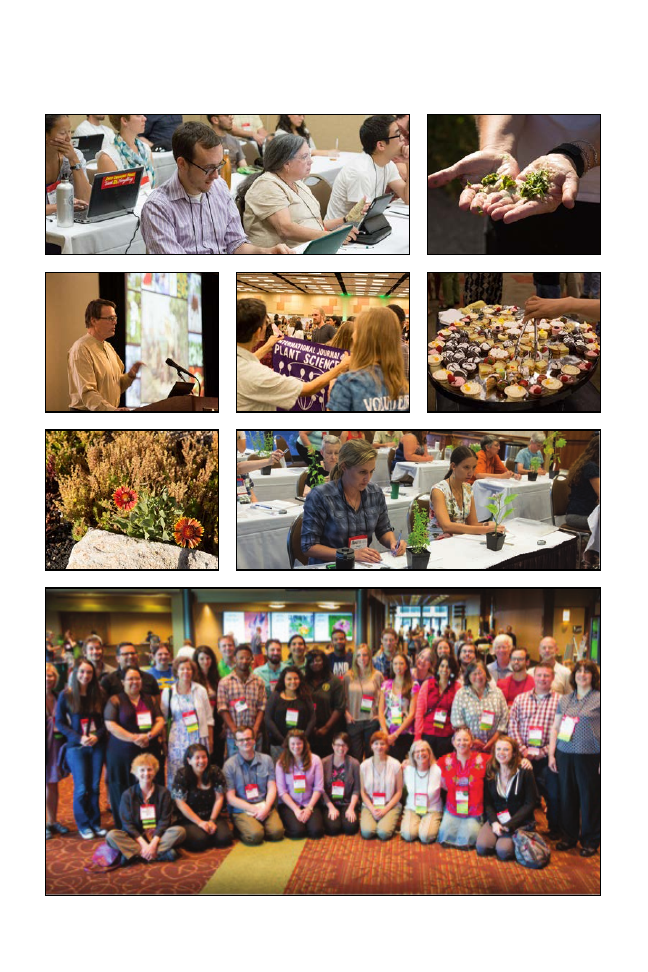
182
Plant Science Bulletin 60(3) 2014
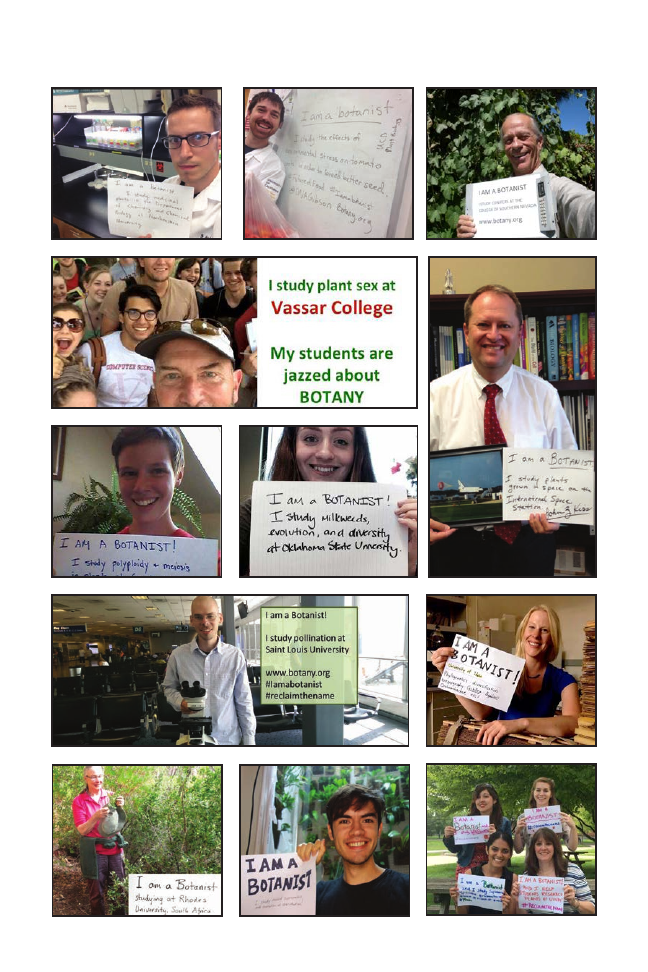
183
Plant Science Bulletin 60(3) 2014

184
Plant Science Bulletin 60(3) 2014
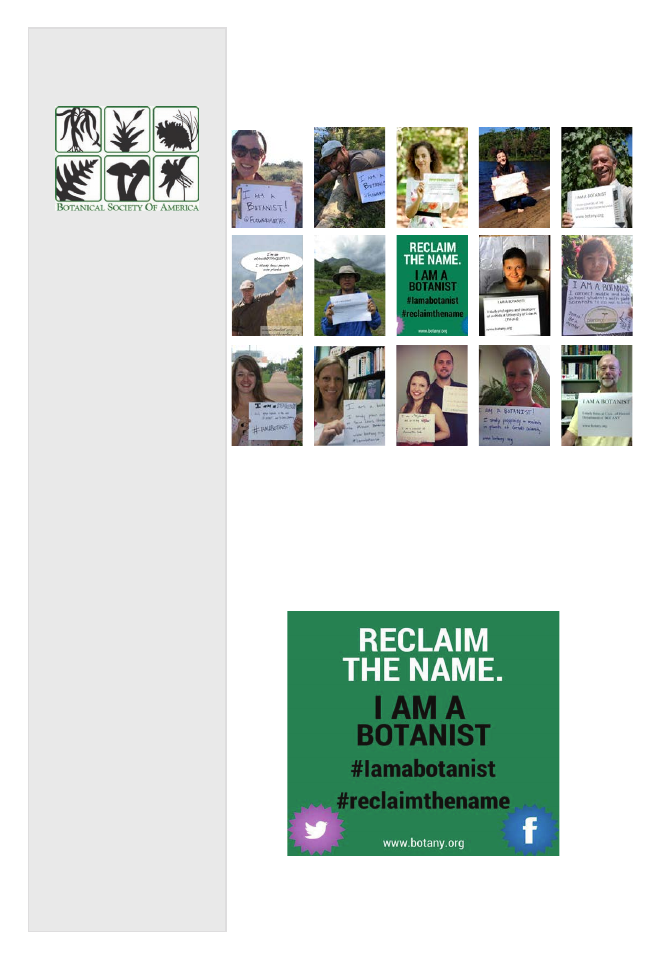
Plant Science Bulletin
Featured Images
The Botanical Society of
America is a membership
society whose mission is to:
promote botany, the field of
basic science dealing with the
study & inquiry into the form,
function, development, diversity,
reproduction, evolution, & uses
of plants & their interactions
within the biosphere.
ISSN 0032-0919
Published quarterly by
Botanical Society of America, Inc.
4475 Castleman Avenue
St. Louis, MO 63166-0299
Periodicals postage is paid at
St. Louis, MO & additional
mailing offices.
POSTMASTER:
Send address changes to:
Botanical Society of America
Business Office
P.O. Box 299
St. Louis, MO 63166-0299
bsa-manager@botany.org
The yearly subscription rate of
$15 is included in the membership
Address Editorial Matters (only) to:
Marshall D. Sundberg
Editor
Department of Biological Sciences
Emporia State University
1200 Commercial St.
Emporia, KS 66801-5057
Phone 620-341-5605
psb@botany.org
Plant Science
Bulletin
Fall 2014 Volume 60 Number 3
In September 2014, the BSA launched a social media campaign
inviting anyone studying the plant sciences to “reclaim the name” of
being a botanist. Botanists from around the world held up signs to show
what they study and where they are from, centered around the hashtag
#iamabotanist. The field can sometimes appear to be a “quiet science,”
and the campaign served as a way for botanists to be recognized, for
them to promote their scientific research interests, and to spread
the news about the BSA being a home for all botanists, regardless of
discipline.
